 |
Here are the various folding cameras in my collection. Other groups can be found elsewhere:
TLR cameras
focal plane shutters
SLR cameras
Zeca Goldi
Zeh is a relatively unknown pre-WWII camera maker from Dresden (the home of Zeiss, Altissa and Certo amongst others), but the Zeca cameras had a reputation of being well-build and engineered. The Zeca Goldi was no exception, it was a folding camera for 127 film with an extremely sturdy scissor-strut construction, later also used on the Zecaflex, Zeh's top of the range folding TLR camera. Supporting its good reputation was the fact that the Goldi was one of the few cameras that were sold with Leitz Elmar lenses, the only other ones I can think of were the Nagel Pupille and the Nagel/Kodak Vollenda. However, the latter two had unit focussing mechanisms, whereas the Elmar on the Goldi was a front cell focussing variant. So this may have been the only front cell focussing Elmar that Leitz produced, but let me know if I am wrong.
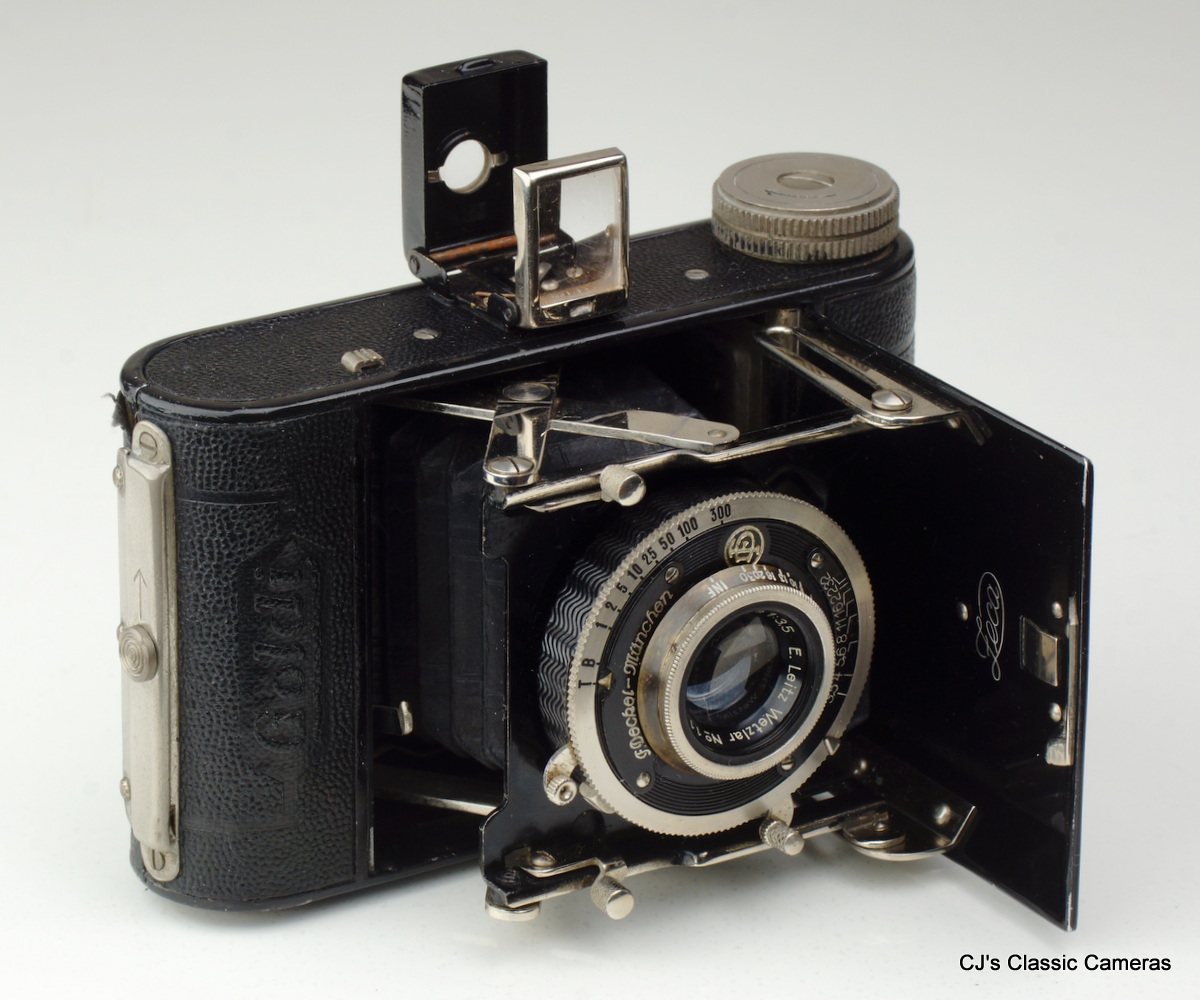
A 3x4 format Zeca Goldi with Leitz Elmar 50mm f/3.5 lens in Compur shutter from around 1934.
|
Same 3x4 format Zeca Goldi in upright position.
|
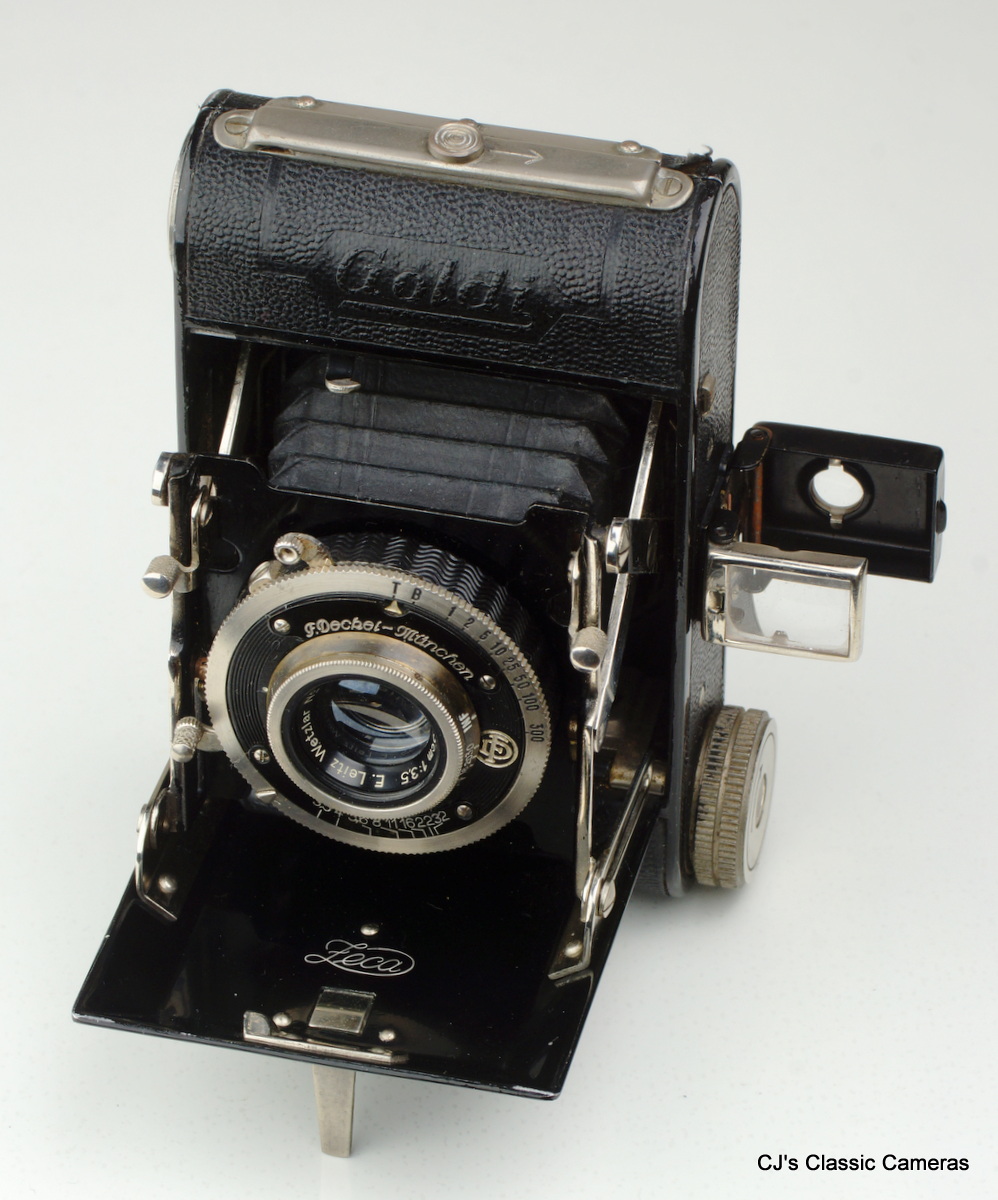
|
The Goldi was rebranded under several names, the Rodenstock Ysella is the most well known, but also as Coloprint, Imperial and Ralikona. Nearly all Goldi's were halfframe 3x4 cameras, but I happened to stumble upon a rare 6x4 version as well (which I only realised after receiving it!).

|
A 6x4 format Zeca Goldi with C. Friedriech Munchen Corygon-Anastigmat 75mm f/3.5 lens in Compur shutter from around 1933. This is an unmarked example, i.e., missing the Zeh Goldi name, so perhaps it was sold originally under a different name. It is the only image of a 6x4 Goldi variant I have been able to find on the internet, although their existence has been mentioned on a few forum posts.
The very stable strut system (often the bane of folding cameras) can be folded simply by pushing down on two small levers, keeping the lens board parallel at all times.
|
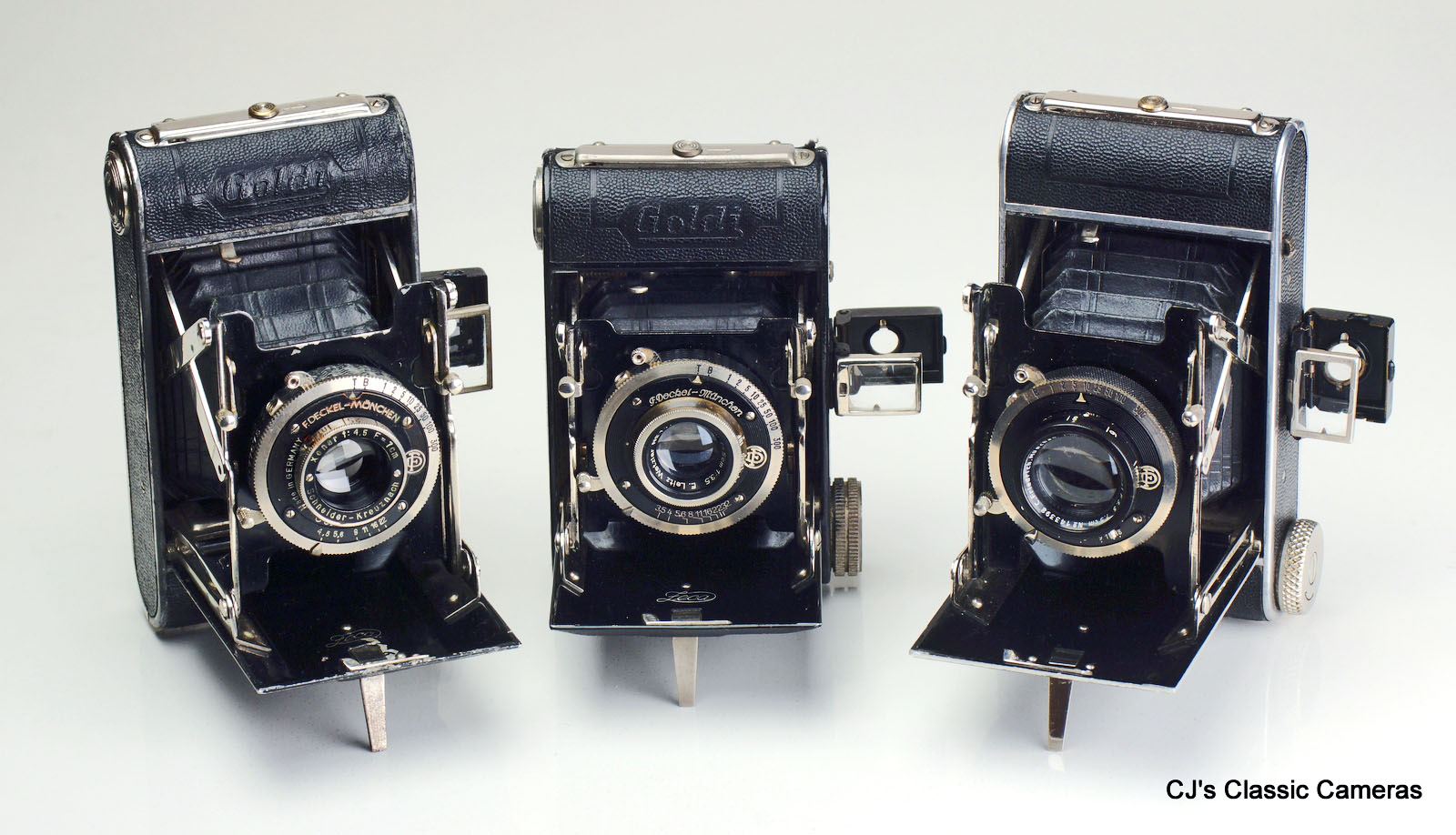
Ironically, not long after coming into possession of the non-branded 6x4 Goldi, a real one come along. Here they are all shown side by side, clearly showing the difference in size. Also note the different viewfinders, an easy means of checking which version it is. The Goldi-branded 6x4 is on the left, it sports a Schneider-Kreuznach Xenar 70mm f/4.5 lens which can be dated to winter 1934 (these early Xenars had the serial engraved on the rear element ring).
|
Rodenstock Ysella, a rebranded Zeca Goldi. Surprisingly, it does not have a Rodenstock lens, which makes me suspect the lens and perhaps even the shutter were swapped with another camera.
|
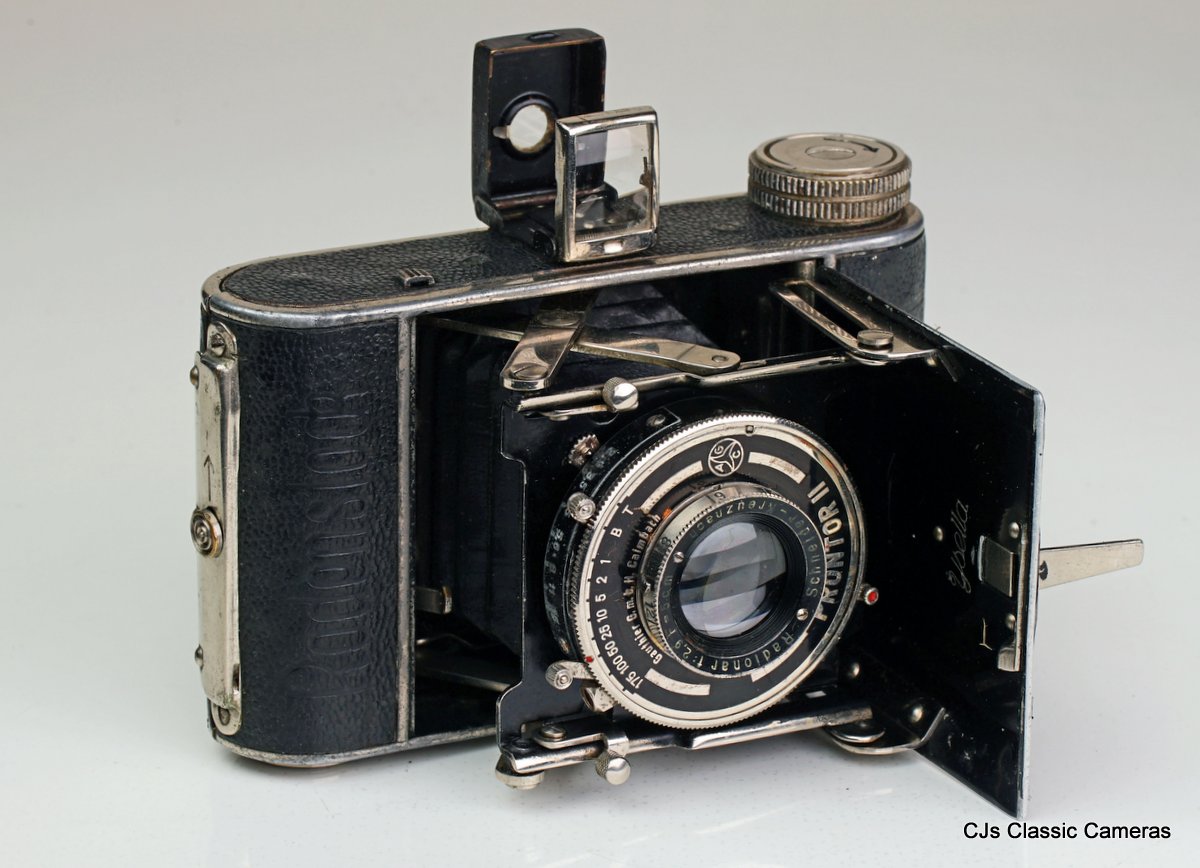
|
Merkel Metharette
Merkel was a small camera maker founded in 1900 in Tharandt near Dresden, mainly known from the Reflecta TLR camera (one of the earliest TLRs) introduced in 1932 around the same time as the company was taken over by Richter. The Merkel Metharette was a small strut-folding rollfilm camera for 127 film introduced around 1930. It had quite a characteristic strut mechanism (see photo below) and a baseplate with four embossed corners. The baseplate would move to its forward position upon pushing the release button at the bottom of the camera, and the viewfinder would pop up at the same time. To close the camera one simply pushed the baseplate back into the camera body.
Several different variants of the camera were build, including versions for other companies as the models often bear different names, such as Primula and Embirella (the latter reportedly sold by the Czech company Birnbaum). The Rodenstock Rodella certainly was a rebadged Metharette, and so was the Salmoiraghi Gioia (the name!) for a camera maker in Milan. Apparently a variant was also sold by Meyer (better known for its lenses) as the Megor, but more commonly found is a copy of the Korelle 127 3x4 folding camera with the same name, which had struts on the side of the baseplate instead of at the top and bottom like on the Metharette (see below for an example). It does not help the confusion surrounding the Merkel Metharette that neither the name of the camera or its maker was indicated on the camera.
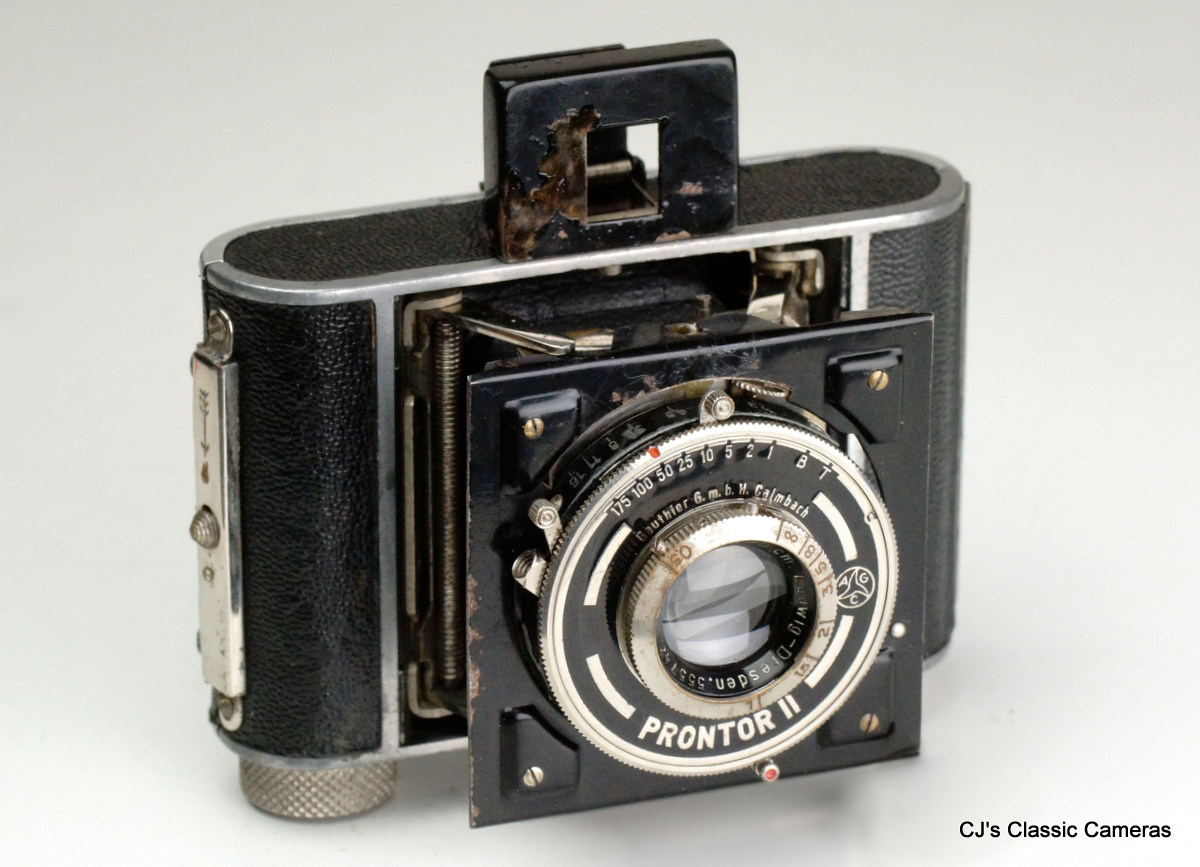
A Merkel Metharette with Ludwig-Dresden Victar 50mm f/2.9 lens in Prontor II shutter.
Meyer Megor (Kochmann Korelle 3x4)
Meyer was a well-known lens maker located in Görlitz (close to the Polish-German border) that also sold rebranded cameras under its own name, of course equipped with its own lenses. This was not uncommon at the time (the 1930s), e.g., Rodenstock did the same (see Rodenstock Citonette and Rodinett below). The Meyer Megor was a copy of the 3x4 Kochmann Korelle for 127 rollfilm. It had a spring-supported strut mechanism that could be closed by simply pushing it in. According ads from the time it was available with Meyer Trioplan, Primotar or Makro-Plasmat lenses, but the first was certainly the most common. Kochmann itself was one of the many camera companies based in Dresden, not far from the Meyer factories. Its specialty was small 'vest pocket', handsome cameras, many of them folding cameras, like indeed the Korelle 3x4.
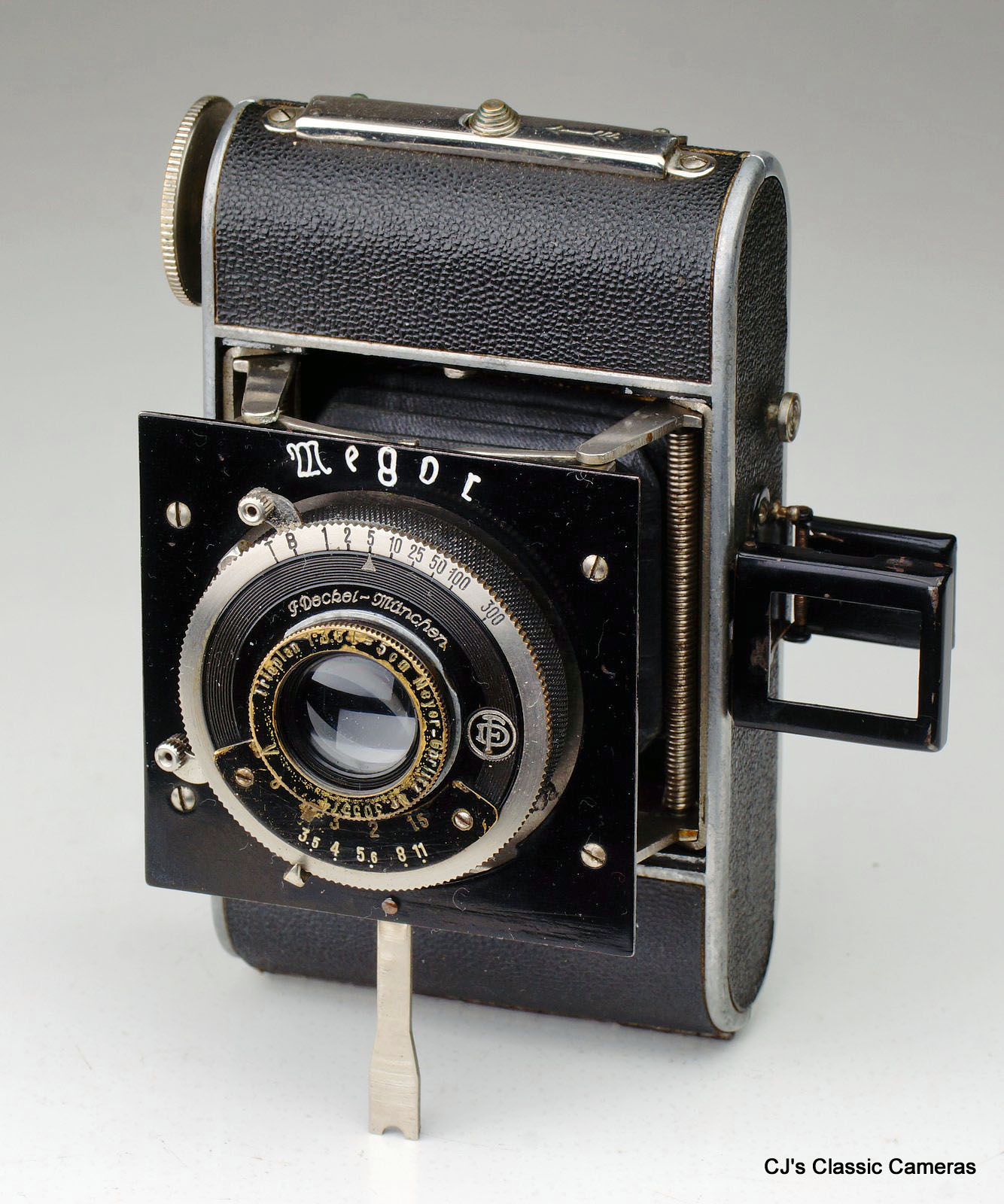
|
A 1933 Meyer Megor (Kochmann Korelle 3x4) with Meyer Trioplan 50mm f/3.5 lens in Compur shutter.
|
According sources on the internet there was a second version of the Megor, which was a rebadged Merkel Metharette (see above). This is not a surprise, the Metharette appeared under many different names. However, the examples I have seen on the internet do not have Meyer lenses (e.g., here), so I suspect these were incorrectly identified as being Megors. In fact, a search for Metharette (or any of its rebranded versions) with Meyer Trioplan gives no results, so in my opinion the existence of this second Megor version is uncertain.
It appears the Megor was the only camera sold by Meyer. Like so many east-German companies, Meyer Optik was after WWII taken up in VEB Pentacon/Carl Zeiss. However, the name has recently be revived by a Görlitz-based company producing modern versions of the classic lenses.

|
A different view of the same Meyer Megor.
|
Rodenstock Rodinett (Glunz Ingo)
Glunz was a now fairly obscure camera maker from Hannover, Germany, mainly known for the medium and large format plate and folding cameras that it made during the 1920s to early 1930s. However, it had one surprise on its sleeve: the Glunz Ingo. This was a small folding camera for 127 rollfilm with a pop-up strut mechanism, not unlike the Merkel Metharette and Meyer Megor above. Indeed, the popularity of these models may well have been the inspiration for Glunz to build the Ingo and get a share of this presumably lucrative market.
In many respects the Glunz Ingo was very similar to its contemporaries mentioned earlier (including the 3x4cm frame size), but it did have one feature that set it apart: its double (or barn) door strut mechanism. This was a very elegant solution to protect the lens and shutter when folded up, unlike other folding cameras of similar size that often left the lens exposed. It also made for a very sturdy platform for the lens itself. I am only aware of one other camera with a similar mechanism, which was of course no other than the Voigtländer Vitessa.
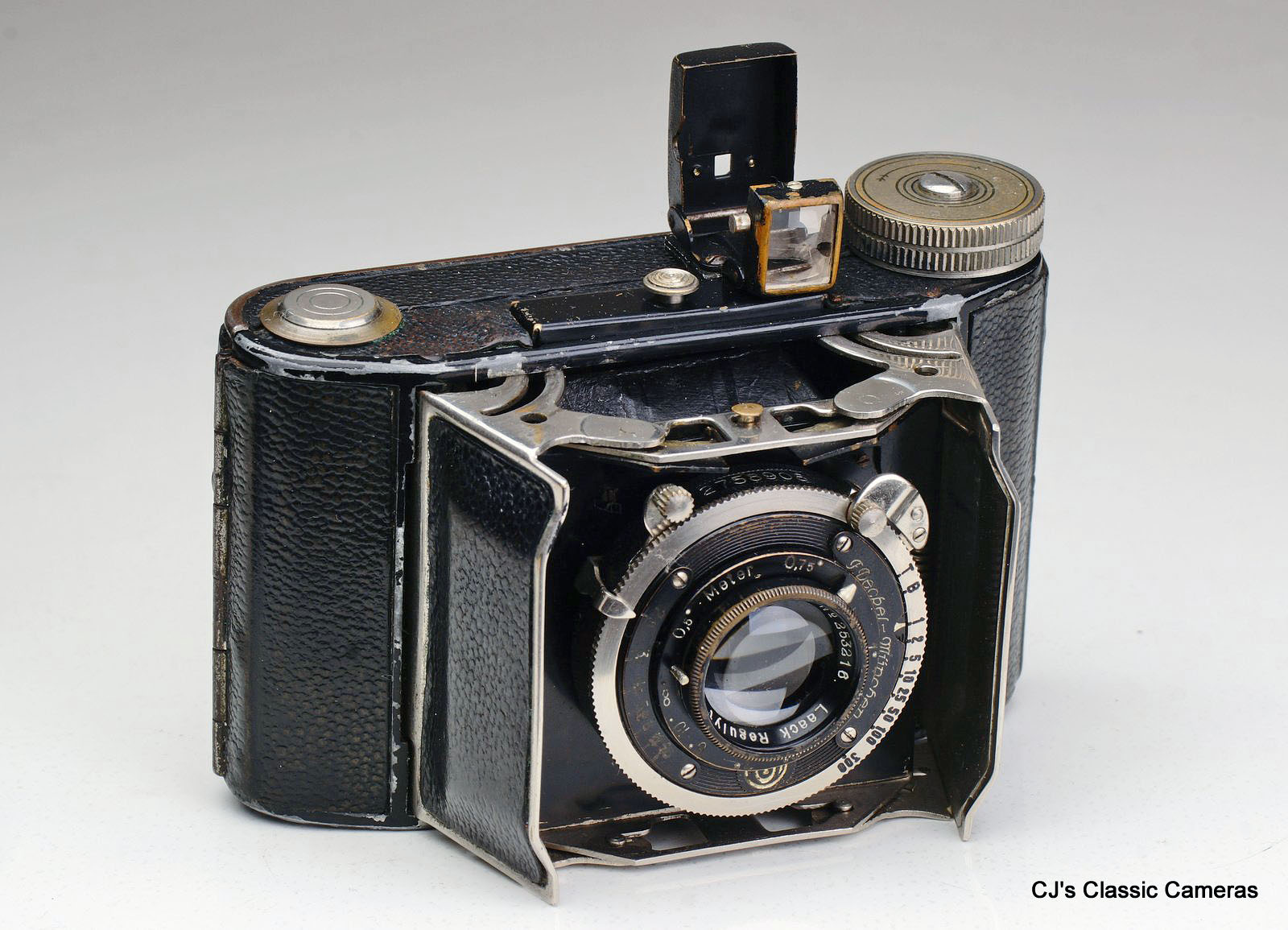
An unbranded (copy of?) Rodenstock Rodinett/Glunz Ingo with Laack Regulyt 50mm f/2.9 lens in Compur shutter. Note the curved doors, typically found on the Rodinett. The Regulyt is quite an unusual lens, especially in this focal length, but I have found no info about it that might help finding out which company sold this camera.
The Glunz Ingo was typically equipped with a Rodenstock f/4.5 or f/2.9 Trinar-Anastigmat lens in Compur shutter, and it is therefore perhaps no surprise that Rodenstock sold a rebadged version of the Ingo as the Rodinett. However, there were some differences, which I have not seen documented anywhere else before: whereas the Ingo had straight doors, those of the Rodinett were curved, and the Rodinett had a helical focus mechanism, whereas the Ingo had a front-cell focussing lens. The helical focus is probably the reason behind the curved doors, as it allowed more space and one did not need to set the lens to infinity to be able to close the doors. Somewhat curiously, the Rodinett did come with a different Rodenstock lens than the Ingo: a 50mm f3/.5 Ysar.
To confuse matters, another variant of the Ingo could be found, which had curved doors like the Rodinett but with a front-cell focussing Laack lens, and which did not bear the name Glunz or Rodenstock (or any other, see photos). Was this perhaps another rebranded version?
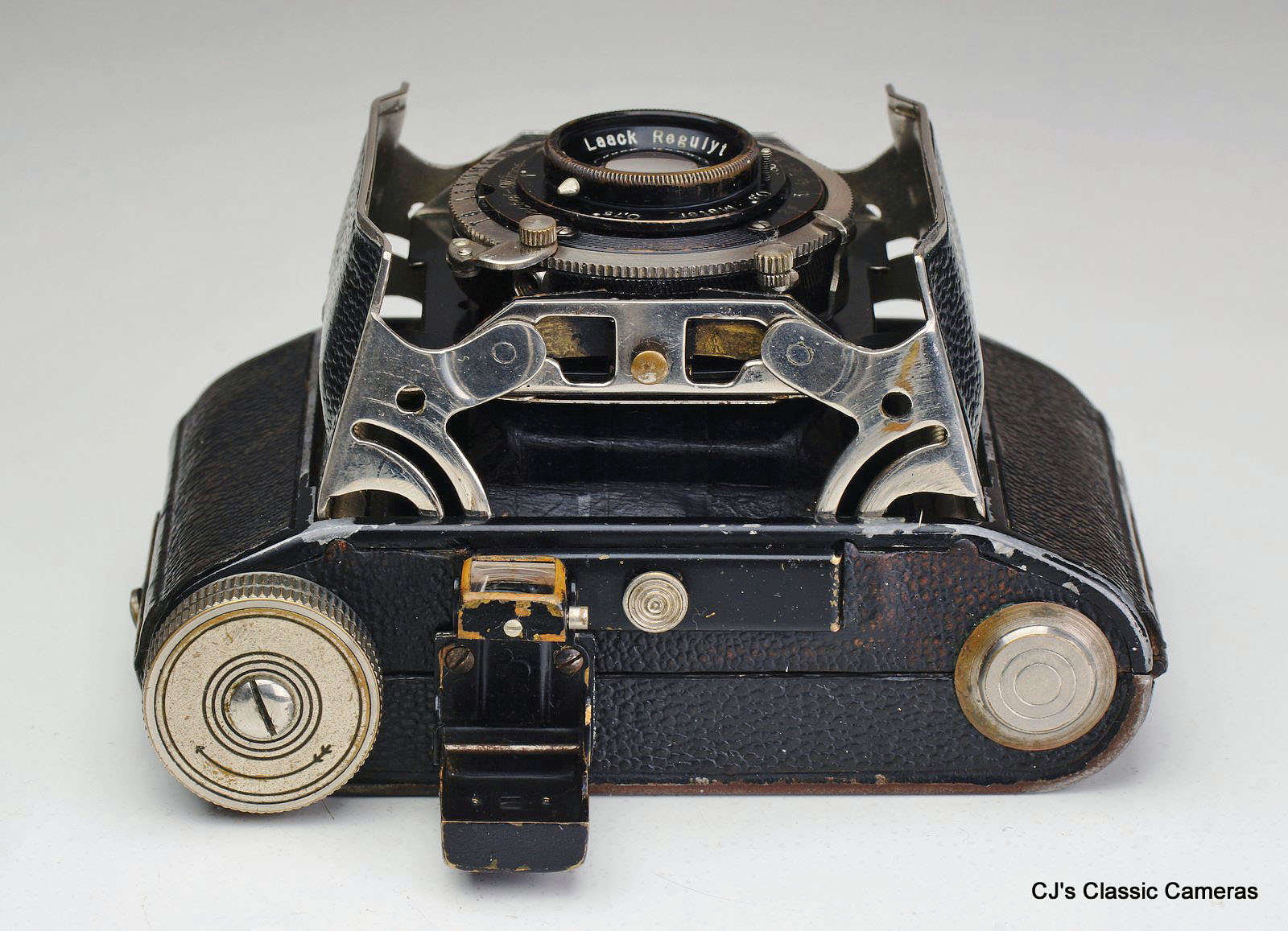
Top view of the Rodenstock Rodinett/Glunz Ingo showing its strut mechanism.
Rodenstock Citonette (Welta Perle)
Welta Perle was the name for a range of pre-WWII folding cameras with different film formats, from 4.5x6 to 9x6 cm. They were quite similar to cameras of other makers from that era such as Balda and Zeiss Ikon, but were characterised by having the wind knob (or key on earlier models) at the bottom of the camera and by having a rather large shutter size typically reserved for larger-format cameras. The Welta Perle had fold-up viewfinders except for the very latest production, which had a Galilean viewfinder with a basic (near vs. far) parallax correction. After WWII the Welta Perle was replaced by the Welta Weltax, which looked very similar but had the viewfinder in the middle of the top plate instead of to the left on the Perle.
The Welta Perle was also sold by Rodenstock under the name Citonette, an example of which can be seen below. Rodenstock was a well-known lens maker, but did sell rebranded cameras with, naturally, their own lenses. They are relatively rare, some of the better known ones are the Ysella (Zeca Goldi), Rodella (Metharette) and Robra (Baldax), but information on these models is sparse. As a sidenote, Rodenstock still exists, focussing on eyewear (which was one of their key products from the start), whilst its photographic lens division was sold off but still sells high-quality large format optics under the name Rodenstock.

|
A Welta Perle rebranded as Rodenstock Citonette with Rodenstock-Trinar-Anastigmat 75mm f/2.9 lens in Compur shutter. The shutter serial nr. dates this camera to near the beginning of WWII. This example is a 4.5x6 format camera for 16 exposures on 120 rollfilm.
|
Welta Trio
The Welta Trio was a for its time affordable 6x9 rollfilm camera with relatively simple specifications. It was equipped with a framefinder as well as a small brightfinder. I am not quite sure how the Trio differed from the 6x9 Perle (see above), most likely it was just a slightly cheaper, less well constructed version of the latter. Nevertheless, the Trio came with a similar range of high-quality shutters and lenses.
|
A Welta Trio with Steinheil Cassar 105mm f/3.8 lens in Compur shutter.
|

|
Welta (?) 9x12 plate camera
In the early 1900s box and simpler rollfilm cameras were the equivalent of today's point and shoot cameras, whereas large format plate cameras were the equivalent of advanced SLRs. They were highly versatile cameras, with a ground glass at the back of the camera showing the exact composition and focus of the scene, and extendable bellows suitable for landscape as well as portrait and close-up photography. They were slow to handle, as the ground glass needed to be replaced with a glass film plate for each exposure, but the quality of the photos more than made up for it. Naturally, these were expensive cameras only affordable by few people, generally professional photographers.
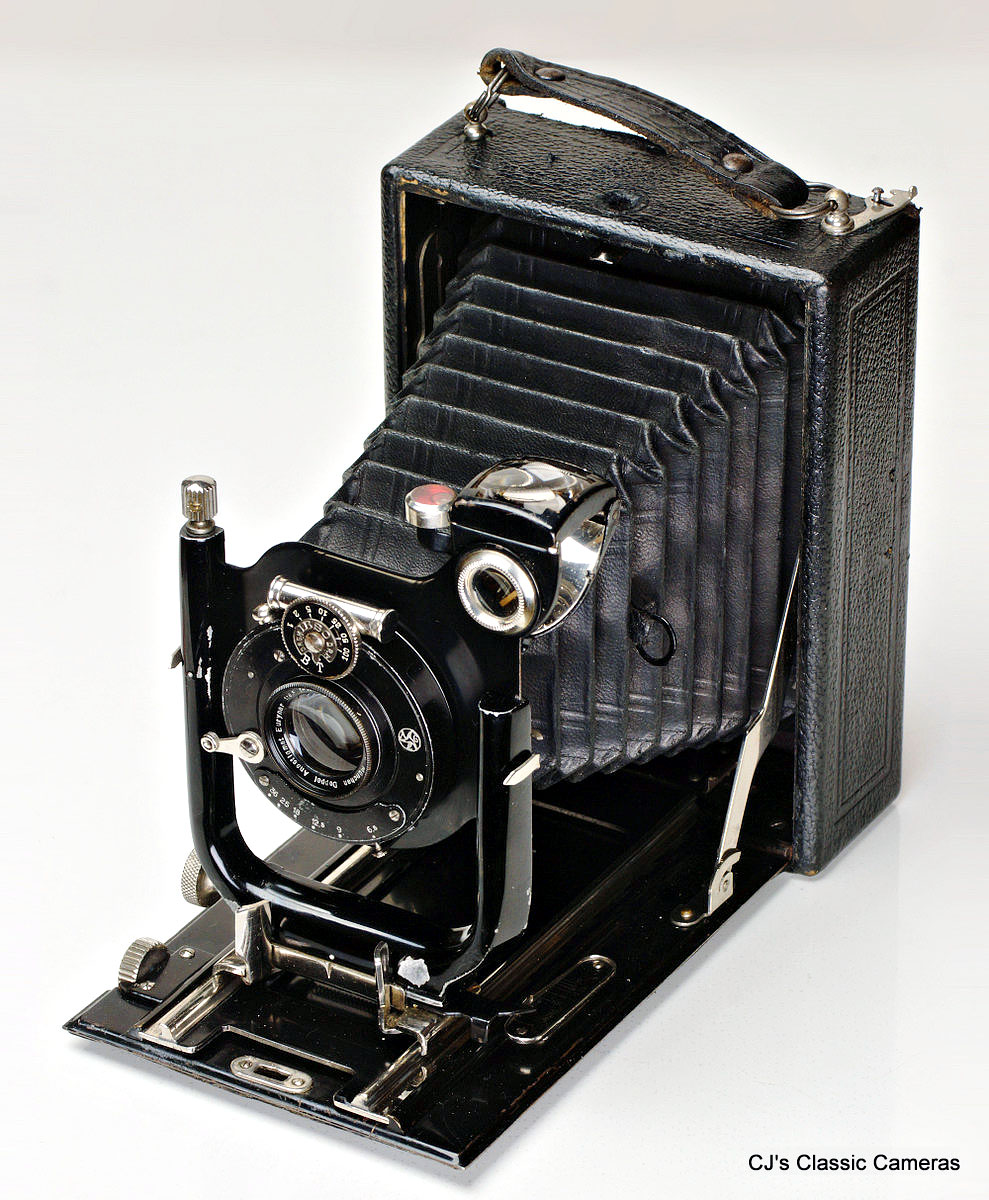
|
An unmarked (Welta?) 9x12 plate camera with Rodenstock Munchen Doppel Anastigmat Eurynar 135mm f/6.5 lens in IBSO shutter. Based on the serial# of the lens the camera dates from around 1918. The IBSO shutter had a pneumatic shutter speed adjustment (the little piston on top of the shutter), as at the time geared speedcams, like in the later IBSOR, were not yet introduced.
|
The example shown here is typical of the plate cameras of that era. The lens was a Rodenstock Eurynar, which was a common lens at the time that could be found on plate cameras by Ihagee, Certo, Glunz and Welta amongst others. In fact, this example was quite likely made the latter; the struts match those of the Weltas I have seen and also the red spirit level appears typical of Weltas. However, the name Welta did not appear until 1919 while this example is possibly from 1918, when the company was still known as Weeka-Kamera-Werk. As this example unfortunately has a non-original ill-fitting back plate it is hard to be certain.
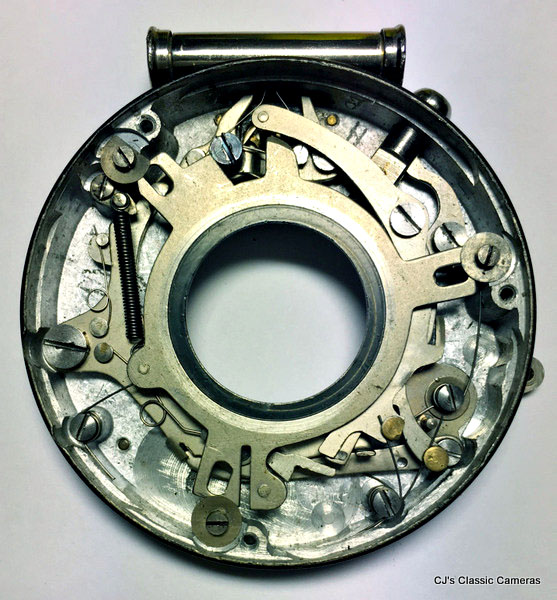
|
Partially dismantled IBSO shutter with shutter blades removed to show the internal mechanism. The IBSO shutter had a pneumatic shutter speed adjustment (the little tube on top of the shutter, which contains two pistons), as at the time geared speedcams, like in the later IBSOR, had not yet been introduced.
|
In terms of features, the camera had double extension bellows with a rising and falling front with side swing adjustment, i.e., the lens could be moved sideways and up and down relative to the film plane. This way one could adjust compositions without the need to point the camera up or down, thus avoiding distortion of the scene. The double extension below allowed focussing down to about 50cm from the film plane.
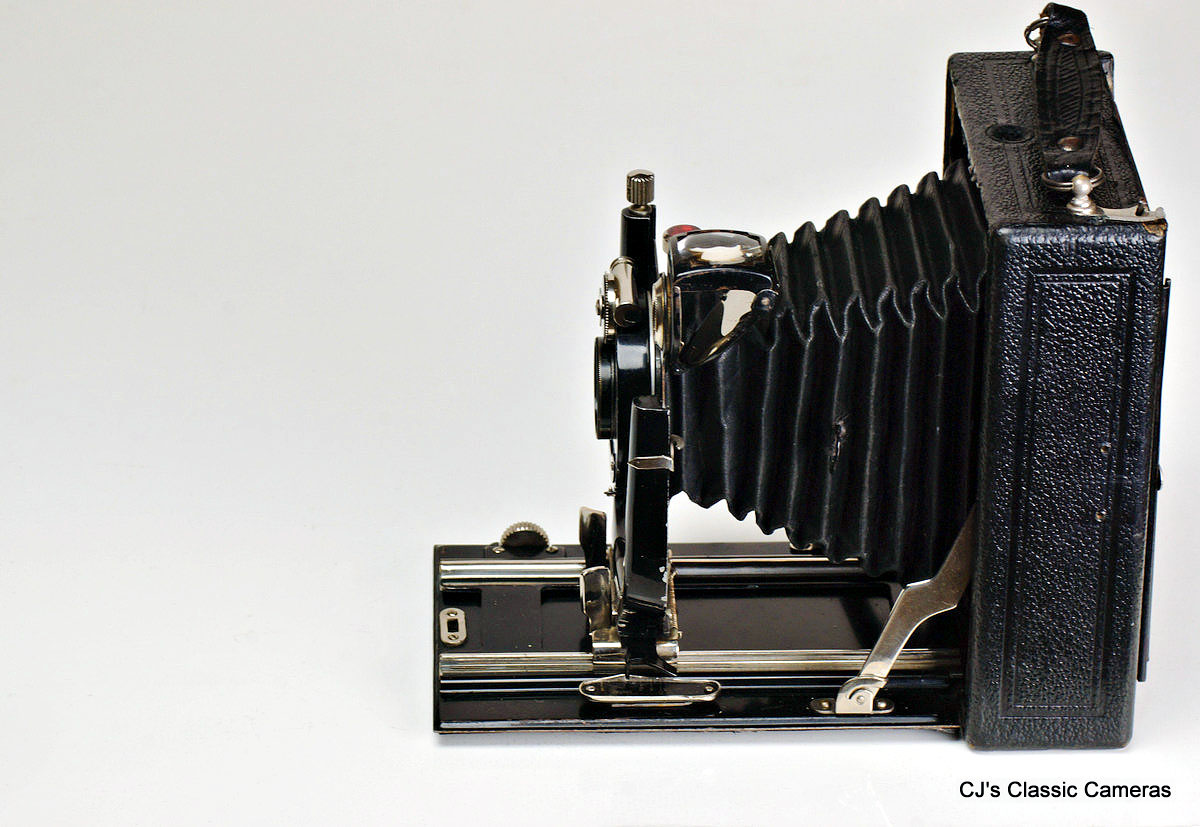
Side view of the Welta plate camera focussed at infinity. Move your mouse over the photo to see the bellows at full extension.
Welta Perfekta
This model could as easily have featured under the TLR cameras, as it is a rather rare breed: a folding TLR, by Welta. Not many of this type of camera were made, the KW Pilot Reflex and Zeca Zecaflex are the main ones I can think of, so the concept clearly did not catch on. In principle the idea seemed to have merit. TLR (twin lens reflex) cameras like the Rolleiflex were quite bulky, so the ability to fold them so they would fit in a (admittedly large) pocket seemed a step forward. However, there were flaws. In the case of the Perfekta, there were considerable light leaks around the ground glass, so the image wasn't as clear as it could be. Also, the camera was complex to build, which made it expensive for the manufacturer as well as the client. So in the end the concept didn't last.
|
That does not mean it was a bad camera, in fact I think it was a marvel full of clever engineering. The folding strut mechanism was sturdy and secure, and the viewfinder hood moved forward when the camera was folded to make it as compact as possible. The mirror would swing into place when the camera was opened. The taking lens sat on a helical focus mechanism operated by a lever on the left-hand side (from the user's perspective) and the viewing lens focus was coupled to the taking lens by a shaft. The camera was also equipped by an automatic frame counter.
Welta produced an even more elaborate model, the Super- fekta. This was a 6x9 version which had a body that could be rotated relative to its front, allowing landscape as well as portrait style photography which would have been difficult to achieve otherwise.
| |
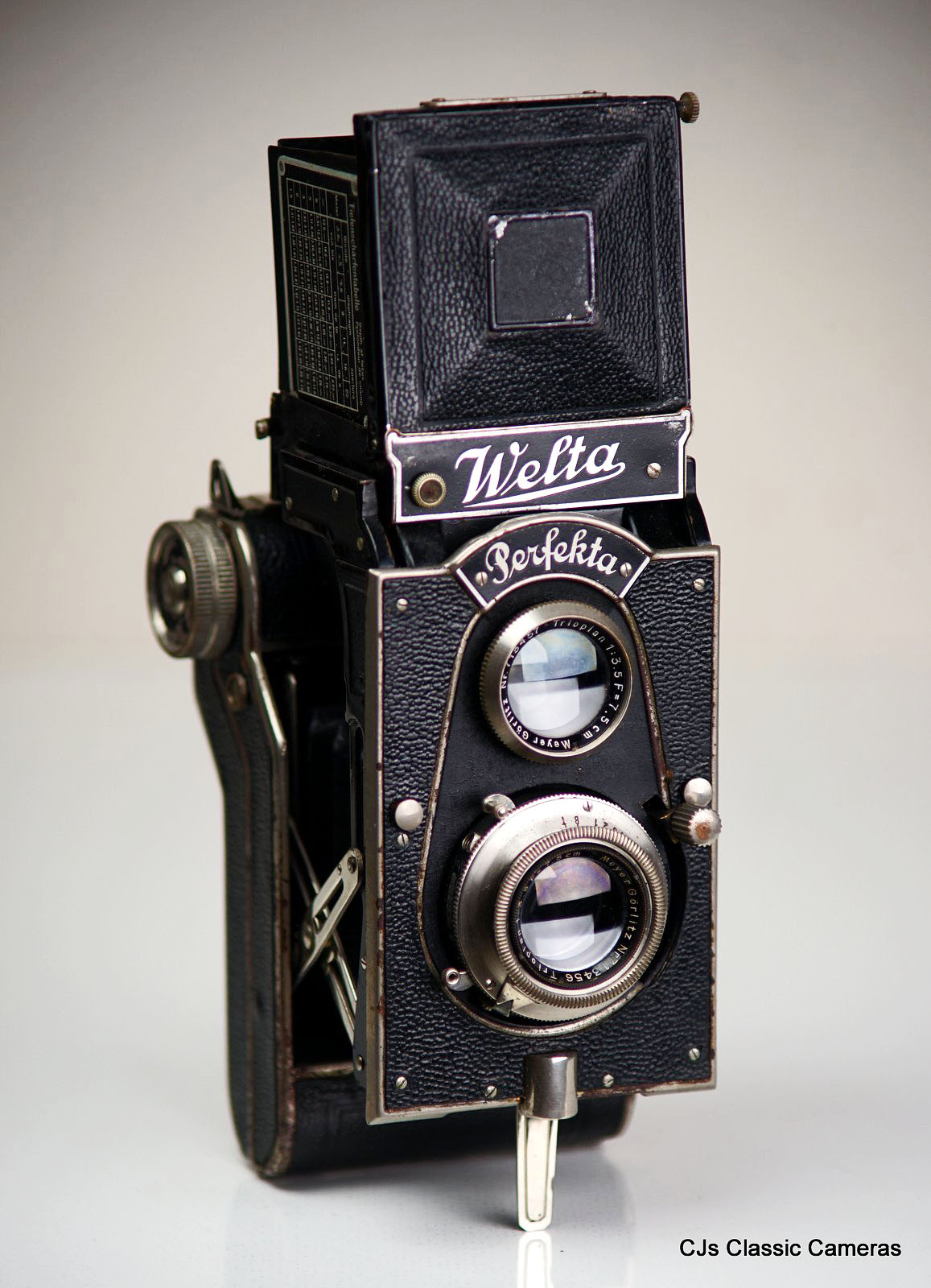
|
(Above) A Welta Perfekta with Meyer Gorlitz Trioplan 75mm f/3.5 lens in Compur shutter. This example was in poor shape when I got it: focus nearly frozen, impact damage, dirty lenses, and so on, but some TLC returned it to working order. When cleaning the mirror I noticed a date written at the back of 11/9.35, presumably the date it was installed in the camera. Similar markings can be found on early Rolleiflex mirrors.
(left) Side view of a Welta Perfekta showing the strut mechanism and the fold-up mirror assembly; (top right) A folded up Perfekta was clearly more compact than regular 'box' TLRs; (bottom right) The inside of the Perfekta was very much like any other 6x6 folding camera, except for the position of the wind spool, which was moved across the film plane to make space for the mirror.
Welta Welti
The Welta Welti was clearly inspired by the Kodak Retinas and built to similar specification, with high-quality lenses and shutters, helical focussing and body-mounted shutter release. It also had a switch in the viewfinder for nearby and far subjects. A cheaper variant was the Weltix with front-cell focussing. There is also a variant with black enamal instead of chrome top plate.
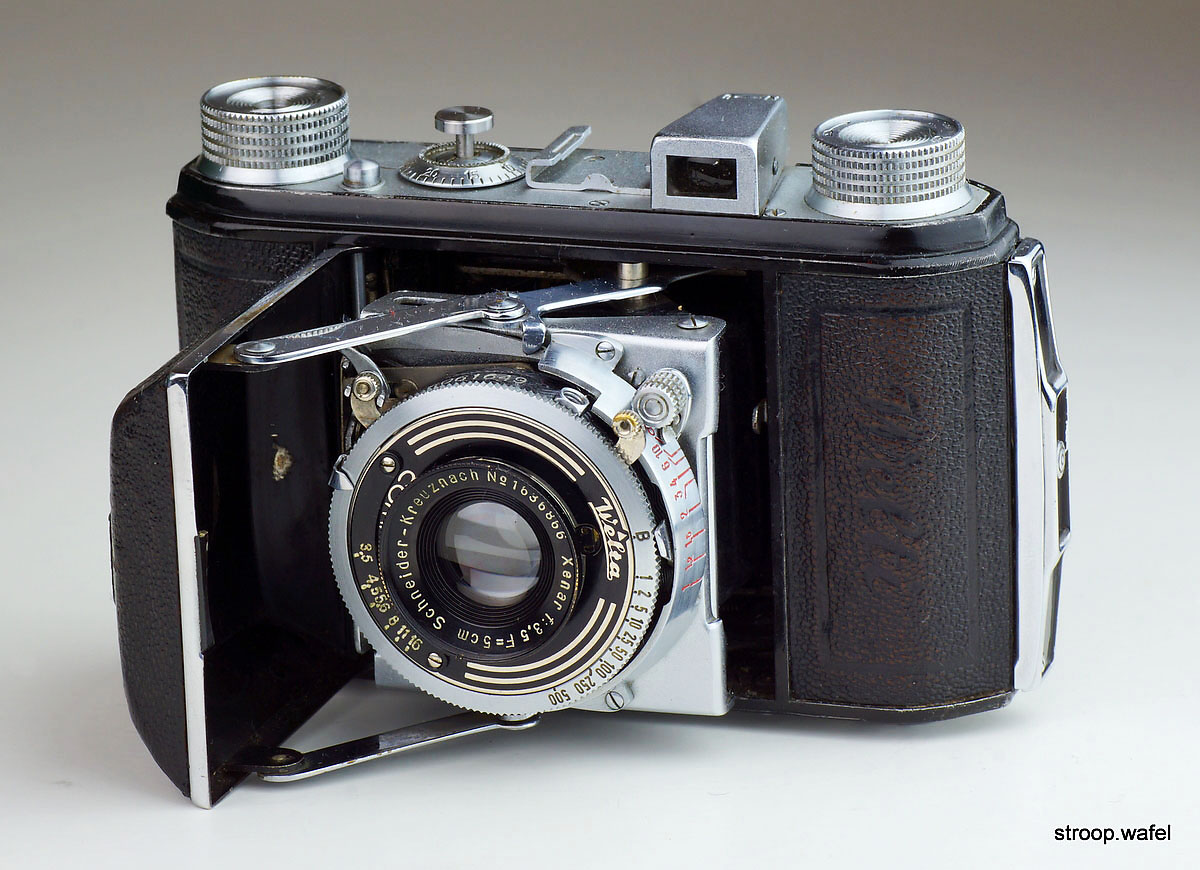
A Welta Welti with Schneider Xenar lens in a Compur-Rapid shutter. The lens serial nr. dates this camera to late 1939. As Welta was based in East-Germany, post-war models would have CZJ Tessar or Meyer Trioplan lenses.
Note the funky piston-shaped release button integrated with the frame counter.
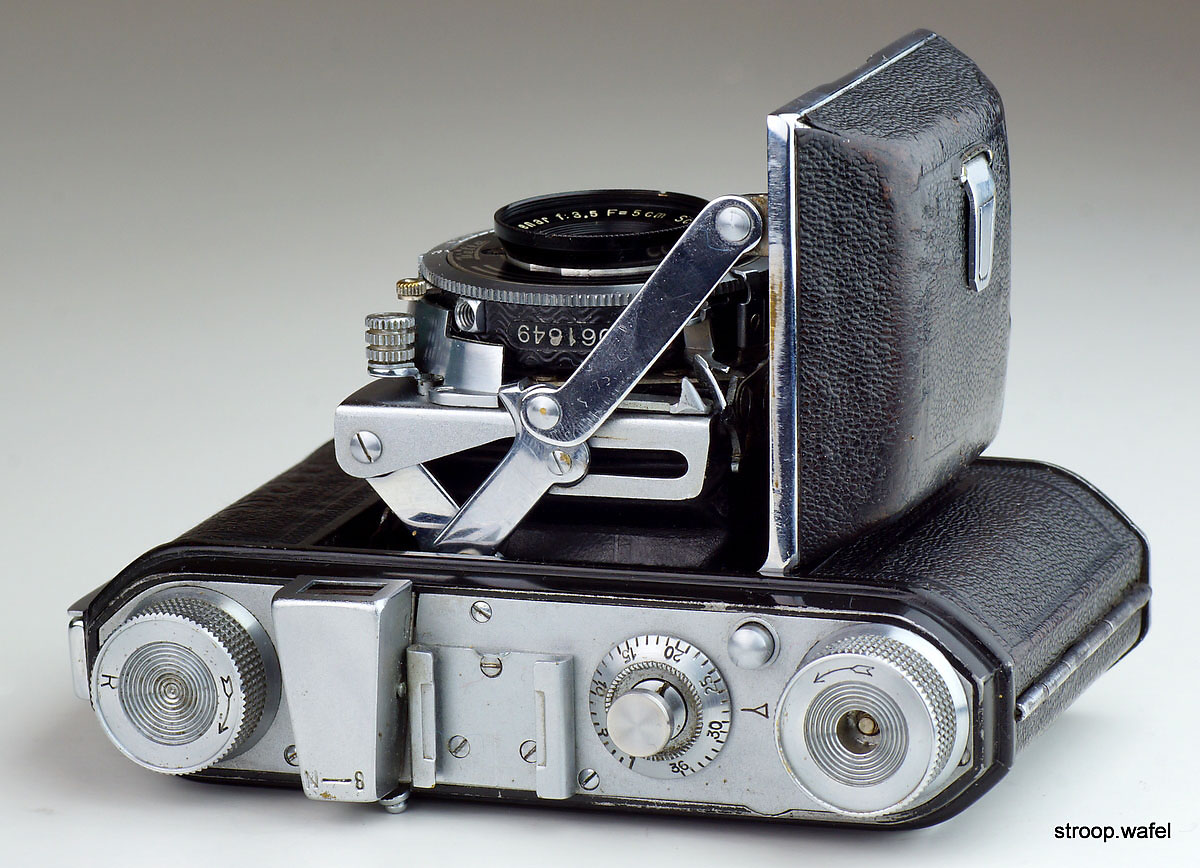
Top view of a Welta Welti.
Welta Weltini II
Like the Welti above, the Welta Weltini was clearly inspired by the Kodak Retinas, in this case the rangefinder models, with features such as high-quality lenses and shutters, helical focussing and body-mounted shutter release. It was solidly made and very heavy. However, the Weltini had a few tricks on its sleeve that even the Retinas could not match. For instance, when closing the front door the lens focus would automatically reset to infinity (whereas on the Retina one needed to do that manually first to be able to close the door) and the shutter button was retracted. A superb little camera.
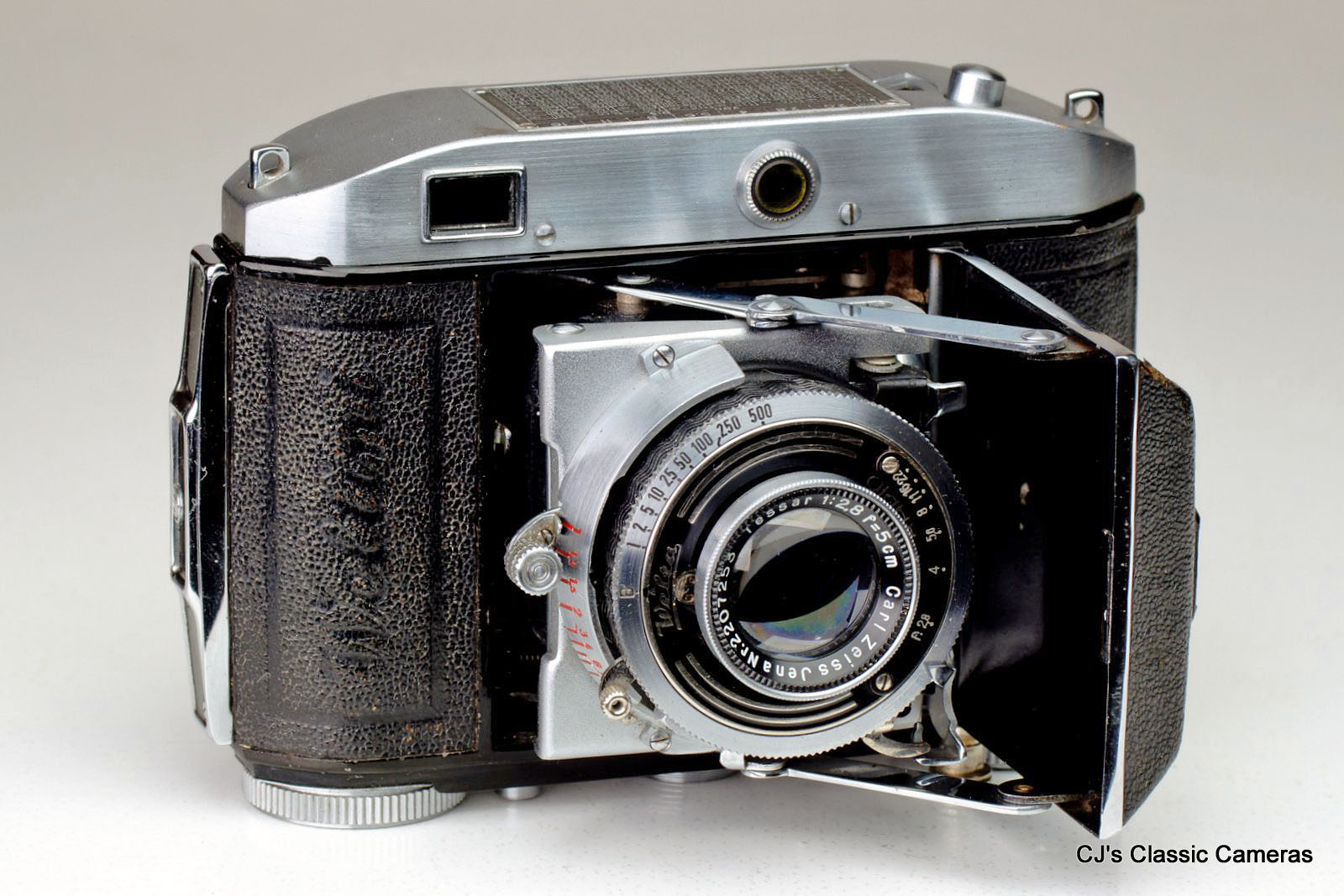
A 1938 Welta Weltini II with Carl Zeiss Jena Tessar 50mm f/2.8 lens in Compur-Rapid shutter. The Weltini I had a more rectaungular top housing that did not cover the whole camera.
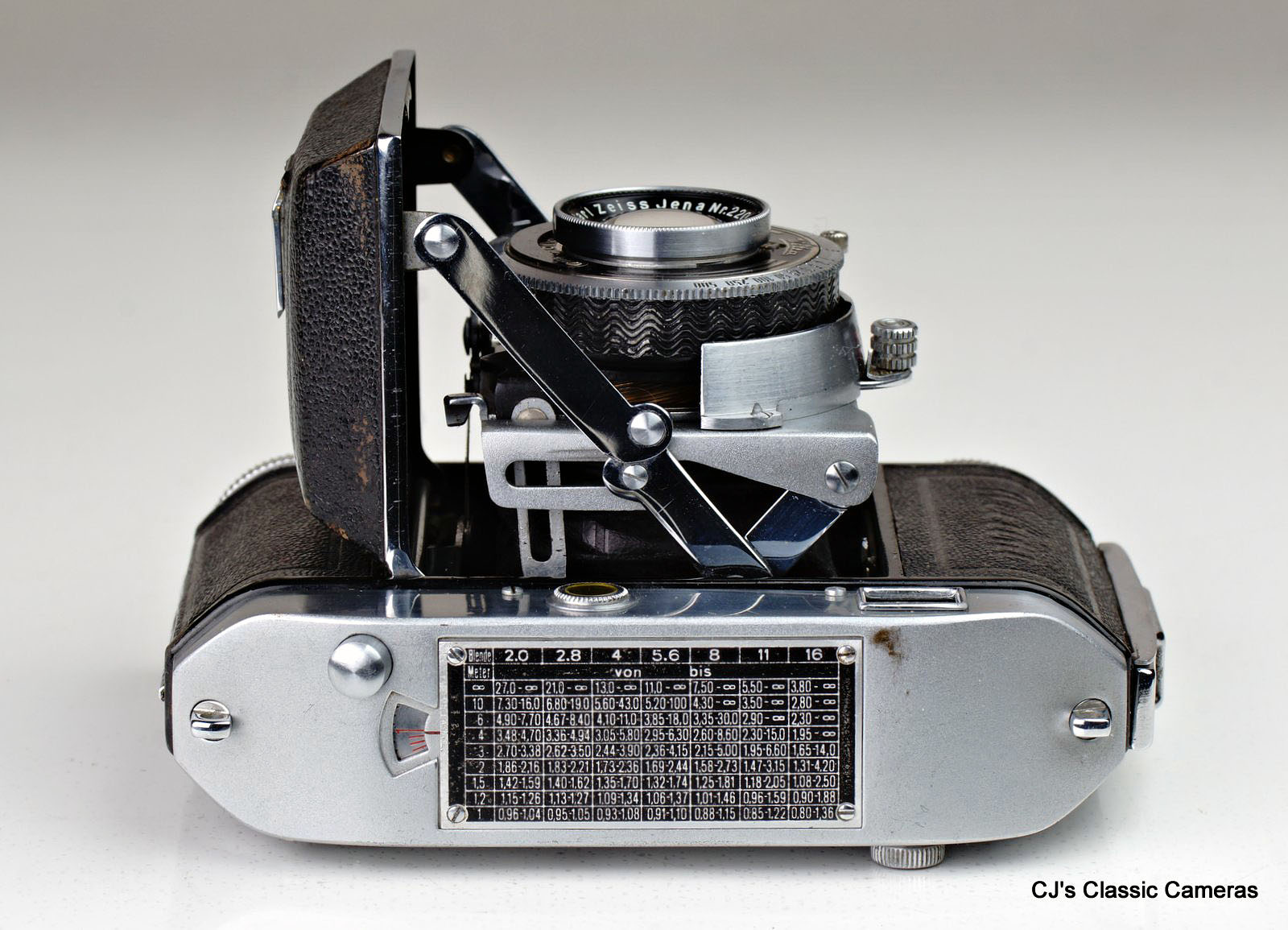
Top view of a Welta Weltini. The depth of field table includes settings for a f/2 aperture, even though this example has an f/2.8 lens, as the Weltini was also available with a fast f/2 Xenon lens.
Certo Super Dollina II
Certo was perhaps one of the lesser known Dresdner camera manufacturers, but its cameras had a good reputation. The Dollina range was a series of 35mm folding cameras first produced in 1935, about the same time Kodak introduced their first Retina. The Super Dollina II was first introduced in 1951 and featured a coupled rangefinder and a rather unusual focussing mechanism: a knob on the top housing would move the lens base forwards and backwards as well as move the rangefinder. The magnified coincidence rangefinder was separate from the viewfinder. One could also read the distance at the top of the camera but this was not needed for the camera to function.
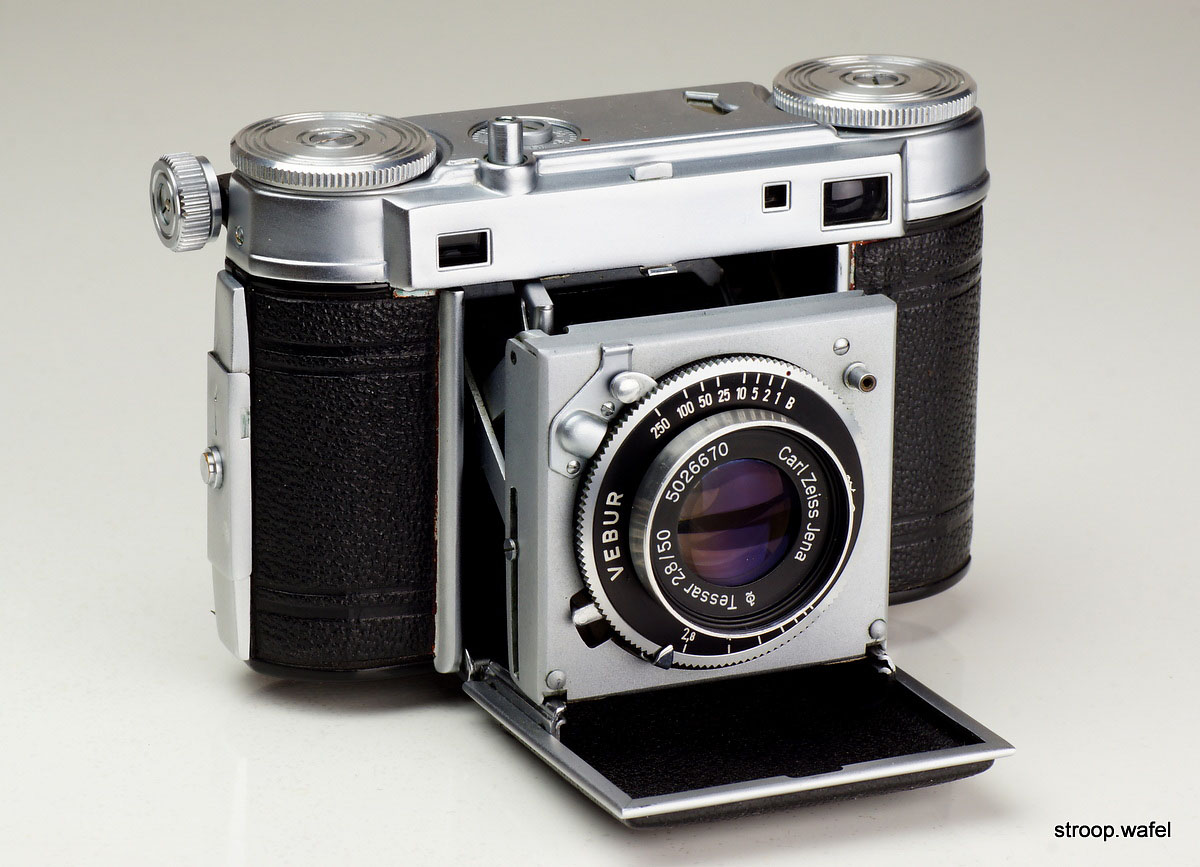
A Certo Super Dollina II with Carl Zeiss Jena Tessar lens in Vebur shutter. The lens serial number suggests this particular camera was produced in 1958. It was a well-made camera and would have been a joy to use, but the rangefinder adjustment is unfortunately rather tricky, so if it is off (like on this one) it will be hard to turn it into a usable camera again.
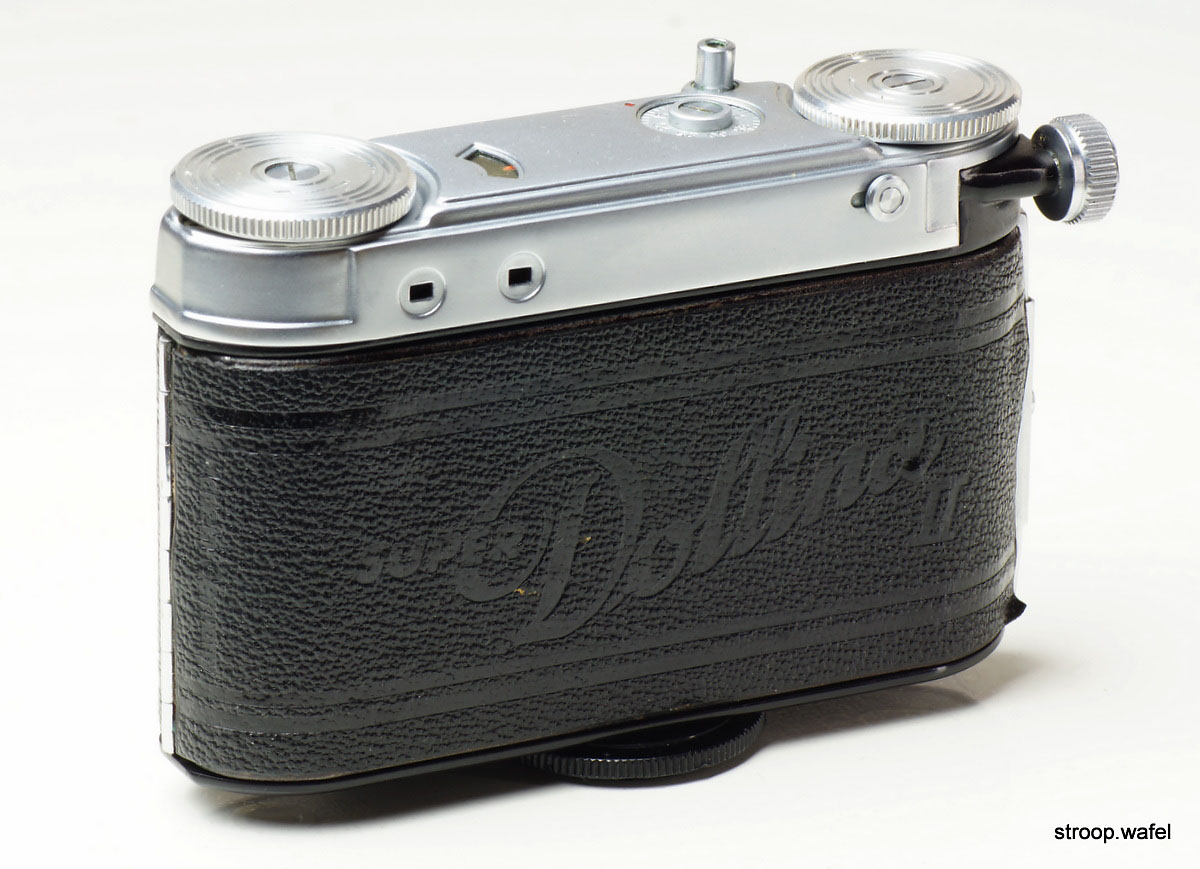
Rear view of the Dollina showing its name in the embossed leather. The small knob on the far right is the focussing knob which moves the rangefinder and the lens.
Certo Durata
The Certo Durata was a simpler and very compact 35mm camera compared to the Dollina above, and was introduced a few years after the end of WWII. Although based on the same body, including front door and strut mechanism, the Duratas lacked rangefinders and had front-cell focussing mechanisms instead of unit cell focussing. The first model, simply named Durata, was a small camera with a pop-up viewfinder. It could be found with Prontor II, Compur-Rapid or Ovus shutter, and a variety of lenses such as a Rodenstock Trinar, Meyer Trioplan of CZJ Tessar. The Durata II looked very similar to the Super Dollina II above, with a viewfinder build into a chrome-plated top housing, but was functionally not much different than its predecessor.

A Certo Durata with Carl Zeiss JenaT Tessar 50mm f/3.5 lens in Compur-Rapid shutter. It looks a little like the Voigtlander Vito II when closed, but the front door opens downwards instead of sidewards.
Certo Six
The Certo Six was a 6x6 camera for 120 rollfilm with some quirky features that clearly set it apart from contemporary folders like the Ikonta and Baldix ranges. First, it had a wind lever, a very welcome feature although unfortunately it did not cock the shutter, which still needed to be done by hand. Second, it had a focus lever at the bottom of the camera (when unfolded) which was best operated by one's thumb. Finally, it was parallax corrected by moving the lens closer to the viewfinder during close-focusing instead of the other way around like most cameras. It was a very well-build and sturdy camera although there are many reports of the rangefinder semi-transparent mirror fading with time. It was the last great camera build by Certo, which for unclear reasons moved to producing cheap plastic cameras instead.

A Certo Six with Carl Zeiss Jena Tessar 80mm f/2.8 lens in Tempor shutter. It was also available with a Meyer-Optik f/3.5 lens and Synchro-Compur or Prontor-SVS shutter.
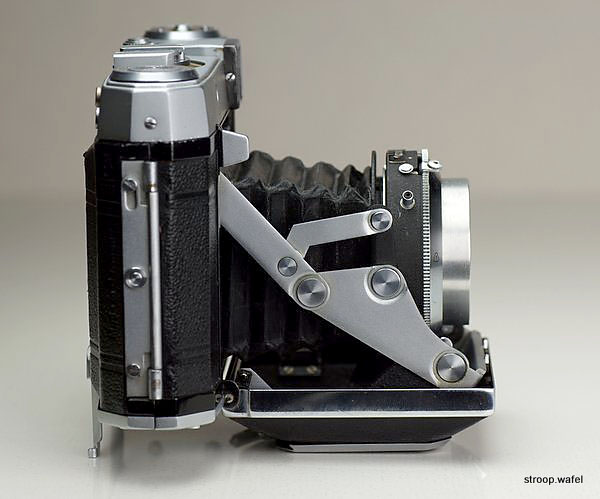
The Certo Six had a parallax corrected rangefinder, but instead of moving the viewing frame it was the lens itself that moved relative to the centre of the film frame. Move the mouse over the photo to see the difference between infinity and closest focus (1.5 m). The focus lever is visible at the bottom of the lens door in close focus position.
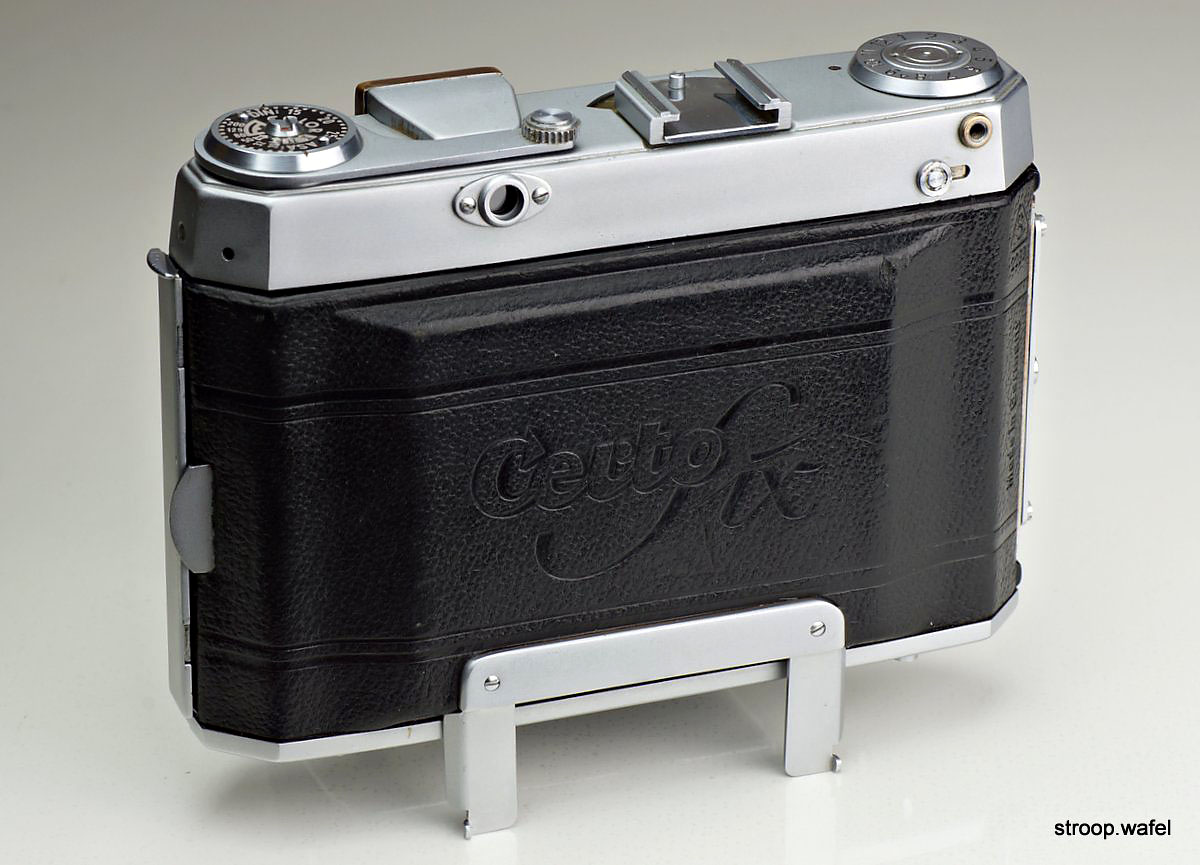
Rear view of the Certo Six. A nice feature was the build-in folding stand. The small button on the top right is the double-exposure lock reset, right above it is the remote release socket - perhaps not the most obvious location.
Franka Solida IIIE
The Franka Solida IIIE was a 6x6 rollfilm camera with uncoupled rangefinder that bore some resemblance to the Balda Mess-Baldix. The Solida I, II and III mainly differed in lens speeds, f/4.5, f/3.5 and f/2.9, respectively. The E version had uncoupled rangefinders (E = 'Entfernungsmesser'), whereas L versions with light meter were also available (see below for an example). Several versions existed, e.g., early Solidas had separate rangefinder and viewfinder windows, and the location of the distance dial of the uncoupled rangefinder changed.
Franka Kamerawerk was based in Bayreuth and a rather small player in the German camera production. Nevertheless, it did produce a wide range of cameras, like the above-mentioned Solida folding camera range as well as the fixed-lens Franka and Frankarette. The company was in 1962 taken over by Wirgin.
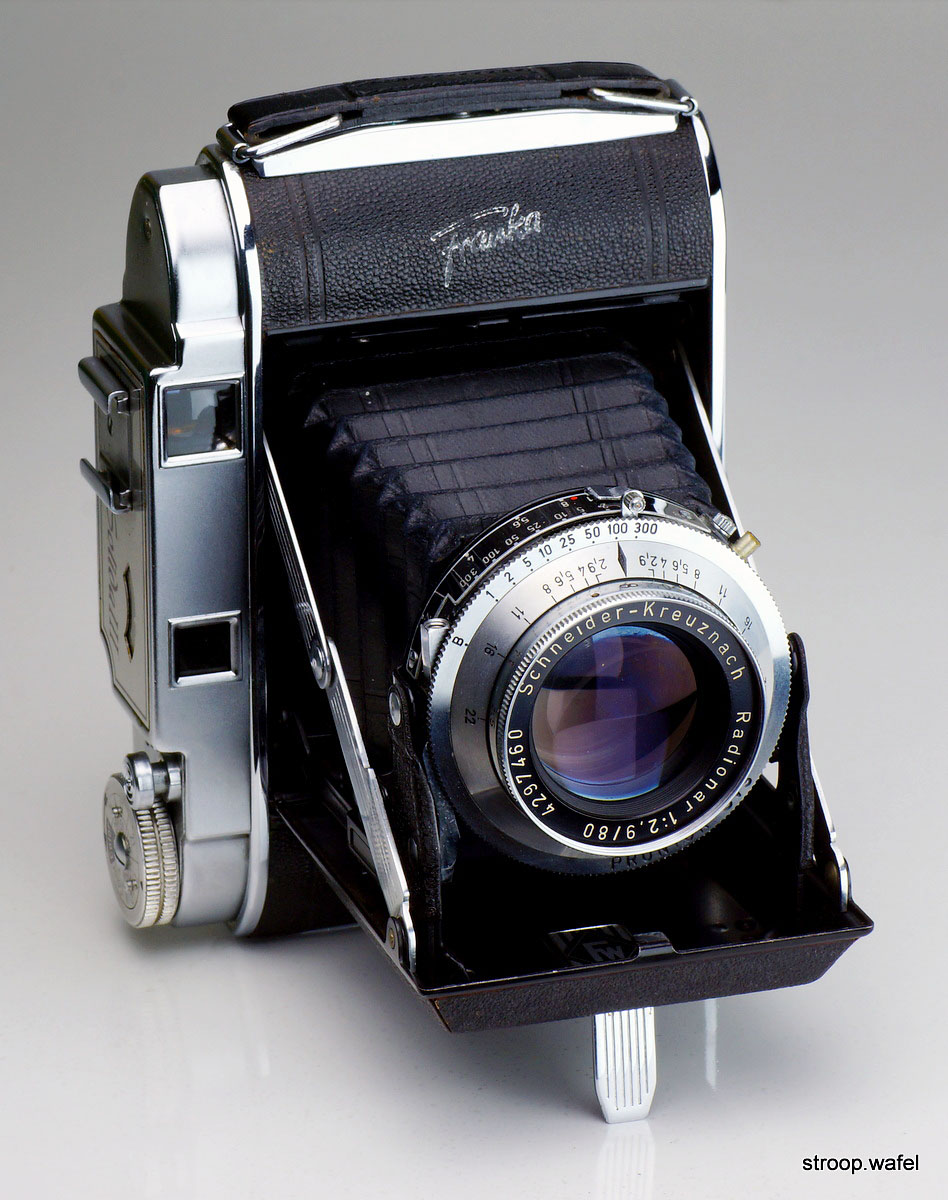 |
A late Franka Solida IIIE from 1955 with Schneider Radionar 80mm f/2.9 lens. |
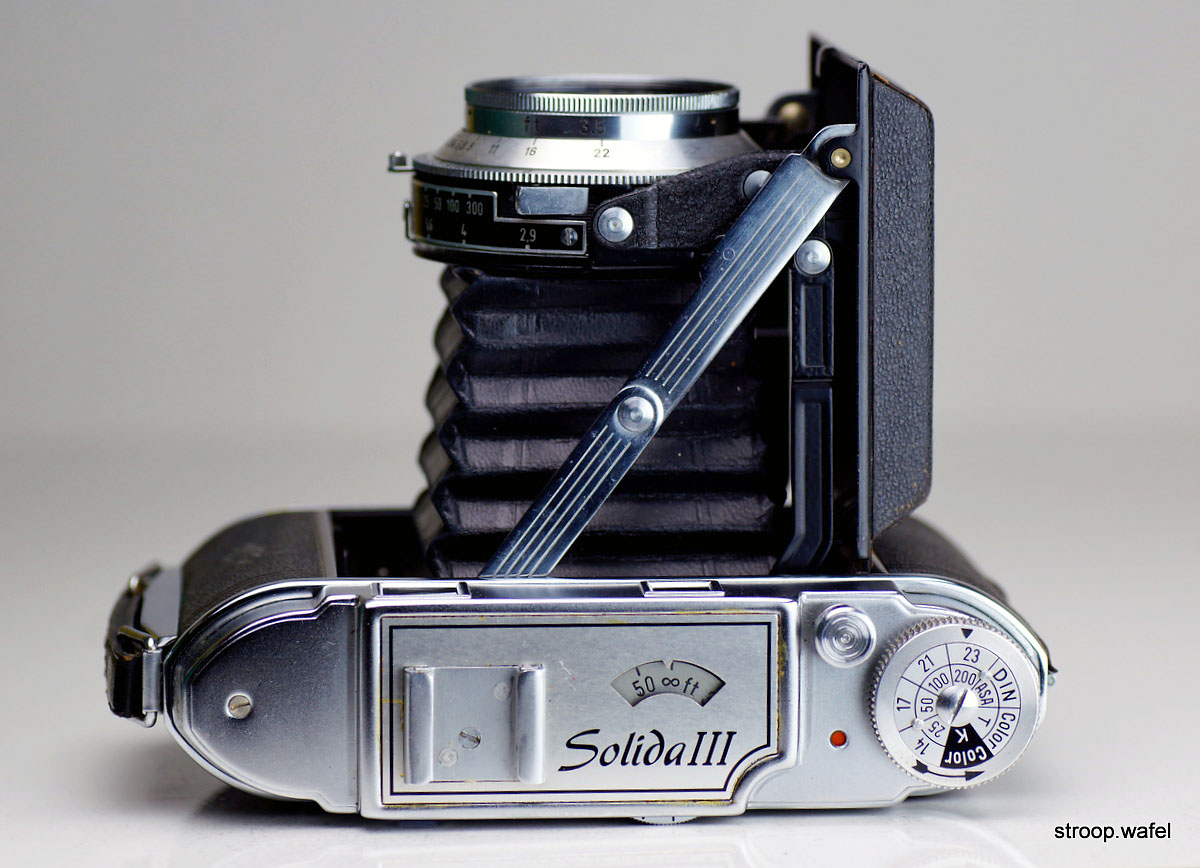
Top view of a Franka Solida IIIE showing the rangefinder distance indicator and wind knob with double exposure prevention.
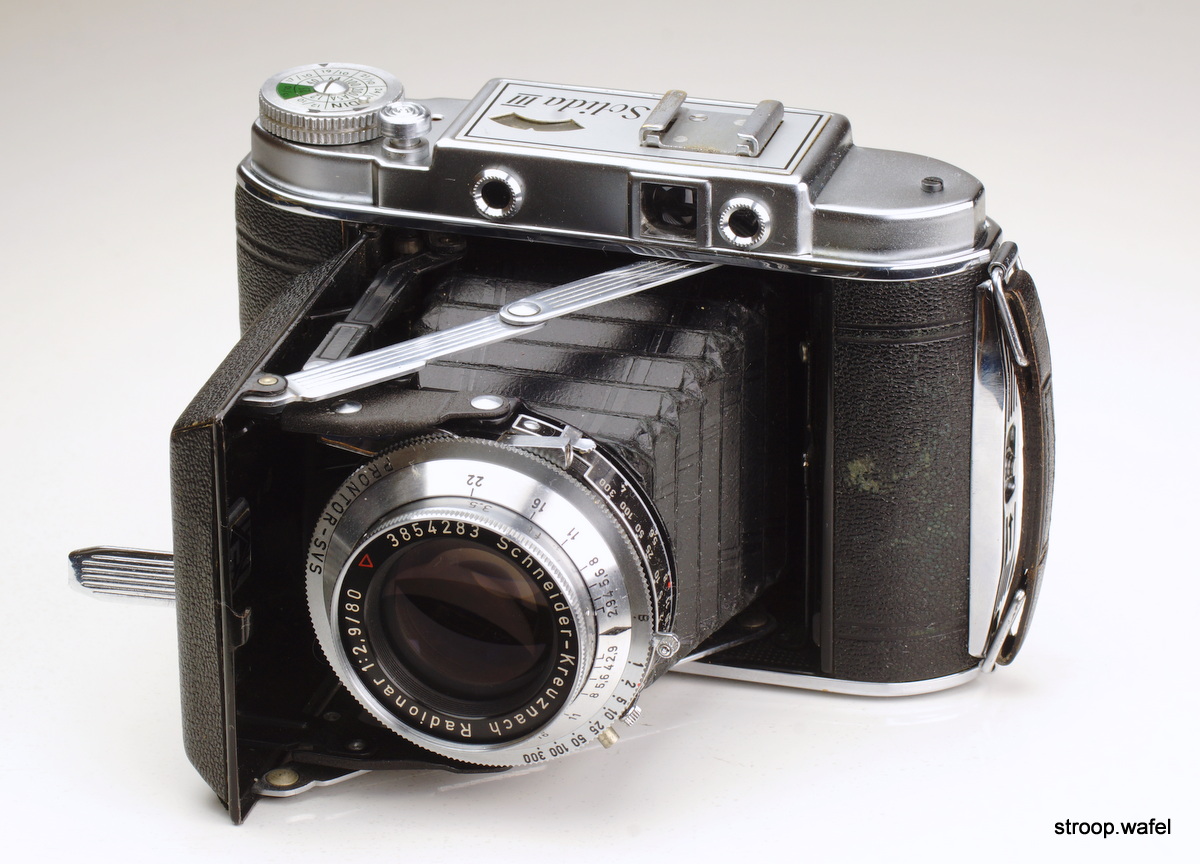
Early version of the Franka Solida IIIE with separate viewfinder and rangefinder windows. The back of the camera is marked 'Made in Germany US Zone'.
Franka Solida IIL
As one can infer from the name (see above under Solida IIIE), the Franka Solida IIL was a 6x6 rollfilm camera with uncoupled lightmeter. To fit the lightmeter the top housing needed to be enlarged compared to the non-lightmeter models, which is why this model looks a little more square than the Solida IIIE above. In addition, the front door would open downwards rather than sideways, as was also the case on the Solida IIE, and I never quite understood why this was. From most angles the Solida II and II look nearly identical, yet they have a different door mechanism. All I can think is that it must have been cheaper to produce, and worth making a different body.
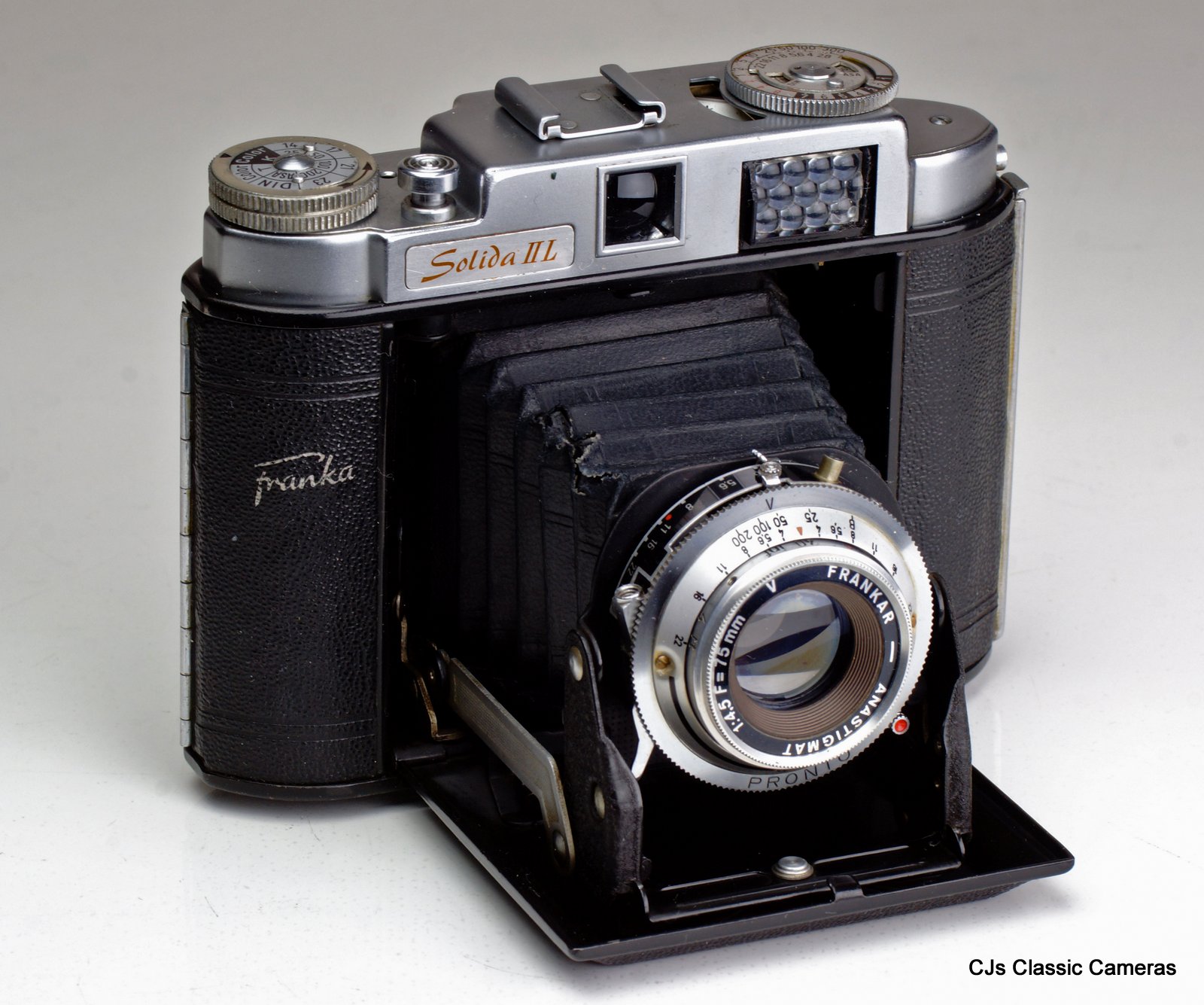
|
Franka Solida IIL with, somewhat surprisingly, a 75mm f/4.5 lens. I say surprisingly because Solida II models generally had f/3.5 lenses, whereas the slower f/4.5 lenses could be found on the Solida I models. Note that on this example the flap of the lightmeter has broken off.
|
Franka Rolfix IIE
The Franka Rolfix II was the big brother of the early Solida IIIE above. It was essentially the 6x9 rollfilm version of that camera, but it could also be used for 6x6 photos by means of frame on the film gate. To assist this there was a switch on the top housing to switch the viewfinder between and on the back of the camera there were two separate red spy windows, one for 6x9 and one for 6x6 exposures. The Rolfix had a body mounted shutter release and a double exposure prevention mechanism.
The Franka Rollfix II came with a 105mm f.3.5 lens. I have never seen a Rolfix I, but if the naming system was the same as for the Solida, it would have been similar to the Rolfix II but with a slower f/4.5 lens. Likewise, the E version would have had an uncoupled rangefinder (E = 'Entfernungsmesser'), like the example below. Older versions of the camera with a fold-up viewfinder were also produced.
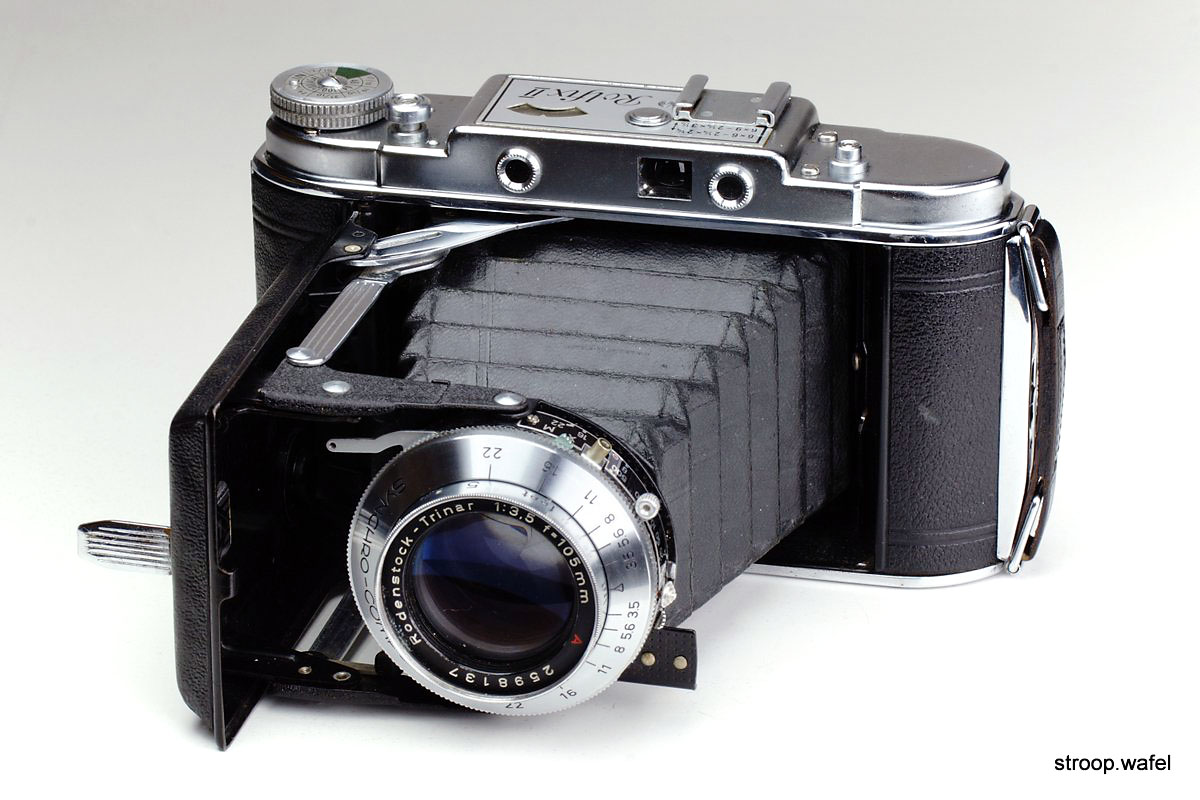
Franka Rolfix IIE with Rodenstock-Trinar 105mm f/3.5 lens in Synchro-Compur shutter. The serial# of the lens dates this camera to around 1952. Like the early production Franka Solida IIIE above, it had separate viewfinder and rangefinder windows and the back was marked 'Made in Germany US Zone'.
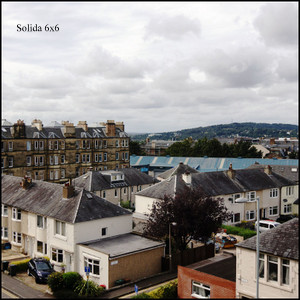
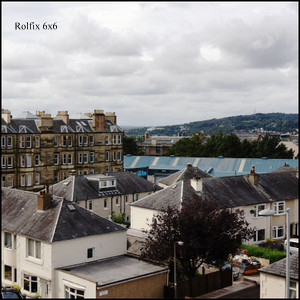
The Rolfix has a 6x6 mode but that does not give the same result as a 'native' 6x6 camera like the Franka Solida, as shown by this comparison of fields of view of the Rollfix II with its 6x6 mask and 105mm lens, and the 6x6 Solida with 80 mm lens. The Solida field of view is clearly 'wider' than the Rolfix.

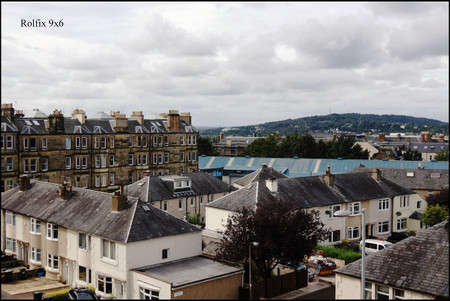
Comparison of fields of view of the Rolfix II 9x6 camera with 105mm lens and the Solida 6x6 camera with 80 mm lens. Due to the smaller focal length of the Solida, its field of view is not much narrower than the Rolfix with its wider frame size, but shows more at the top and bottom of the frame. The Rolfix 9x6 field of view is equivalent to that of a 45mm lens on a 35mm film.

A Franka Rolfix IIE 9x6 and its smaller sibbling Solida IIIE 6x6 side by side.
Dacora Royal
Dacora was mostly known as a company producing cameras for others (see Ilford Sportsman) and was certainly not known for its innovative designs. However, the Dacora Royal was a bit of an exception, as it was one of the few 6x6 folding cameras to sport a windlever for film transport and shutter cocking. Although this feature was common on 35mm cameras, it had been difficult to implement on rollfilm cameras. The camera also featured an uncoupled rangefinder and was otherwise fairly unremarkable.

Dacora Royal with Subita 75mm f/4.5 lens, a lens I have otherwise never heard of, and Pronto shutter. The Royal was also available with better speficied lens and shutter, e.g, Enna Ennagon lens and Prontor-SVS shutter like found on the Balda Baldix.
Most cameras on this site had leaf shutters, like the various Compurs and Prontors, which were usually mounted between the lens elements or, in case of interchangeable lens mounts, just behind the lens. As the name indicates, leaf shutters are build of 2 or more leafs, which rotate away and back when the shutter fires.
Another type of shutter was the focal plane shutter, usually mounted just in front of the film plane. It consisted of a moving piece of cloth, commonly called the curtain, with a gap that allowed light to reach the film. The shutter speed increases with the width of the gap, or, in case of longer shutter speeds, the time difference between the opening and closing curtains.
The advantage of the focal plane shutter was that it was relatively easy to reach higher shutter speeds like 1/1000 second. The drawback is that with speeds faster than ca. 1/30 s, the film is not exposed as a whole, so fast-moving objects can cause problems. Also, flash sync speeds were slow.
The most famous member of the focal plane shutter cameras is undoubtedly the Leica, plus all its various copies. Other ones are the Exakta range, the Finetta 99, the Foth Derby and the Contax/Kiev range. Examples of the Exakta, Contax and Finetta are detailed elsewhere on this site, so only the Leica features below.
Leica IIIa, IIIc, IIIf
Many books have been written about the Leitz company and its cameras and lenses, and there is little point in repeating much here. Leitz invented the 35mm camera (Leica A) in the 1920s as a small and convenient alternative to the larger box, folding and TLR rollfilm cameras. Soon after Leitz developed the interchangeable lens mount, which allowed the use of different lenses as well as various accessories for macrophotography, copying etc. The increasing popularity of the 35mm format led Kodak to invent the 135 film cartridge, which quickly became the dominant film format for the next 70 years and undoubtedly helped the popularity of the Leicas also.
Leicas have always been expensive, top-of-the-range cameras and are even more so these days, now that Leitz seems to focus more on exclusive collector's items than cameras that are meant to be used. Prices have more to do with collectability than anything else and are much inflated over what they used to cost compared to other cameras at the time. From that perspective Leicas are an excellent investment, but expect to pay through the nose for the simplest accessories!
The Leica III series was introduced in 1933 and featured a 39mm screw mount (a.k.a. LTM or L39 mount), a rangefinder with 1.5x magnification and separate viewfinder plus a slow speed dial at the front of the camera in addition to the regular speed dial on top. The Leica II series lack the slow speed option, whereas the Leica I series had no rangefinder. For all lenses other than the standard one one would need separate viewfinders.
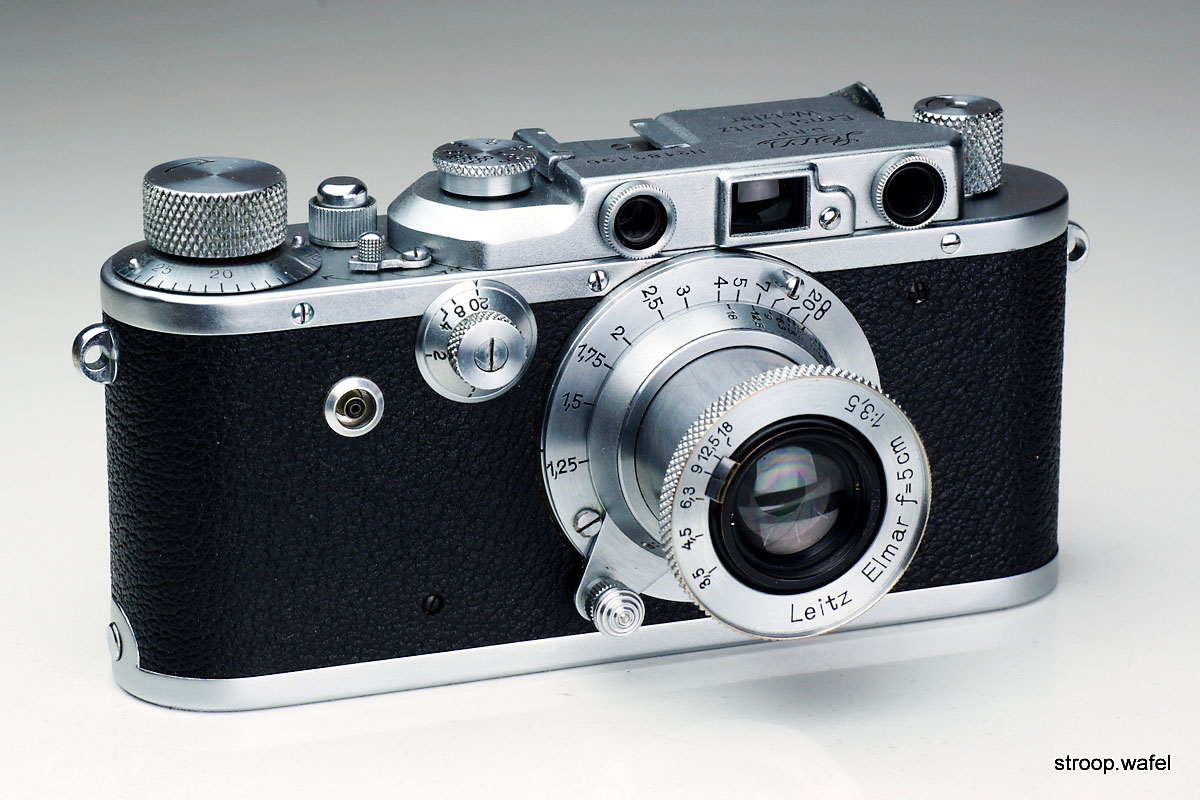
A 1935 Leica IIIa (ser. 183196) with uncoated Leitz Elmar 50mm f/3.5 collapsible lens. The flash sync must have been a later addition but has been very professionally done. There is no flash synchroniser dial like on the later Leica IIIf, so I suspect the flash only synchronises at very slow speeds of about 1/20s in which case the shutter curtains are far enough apart to expose to whole film at once. This was a drawback of focal plane shutters compared to leaf shutters, which would sync at all speeds.
The Leica IIIc was the first with a diecast body, which made the body more rigid, and had an integrated top housing with rangefinder cover as well as better shielding around the film gate which reduced fogging of film left in the camera for longer periods of time. Another change was the rangefinder magnifier, which was moved from behind the eye piece to beneath the rewind knob. Furthermore the 1/30s speed moved to the slow speed dial.
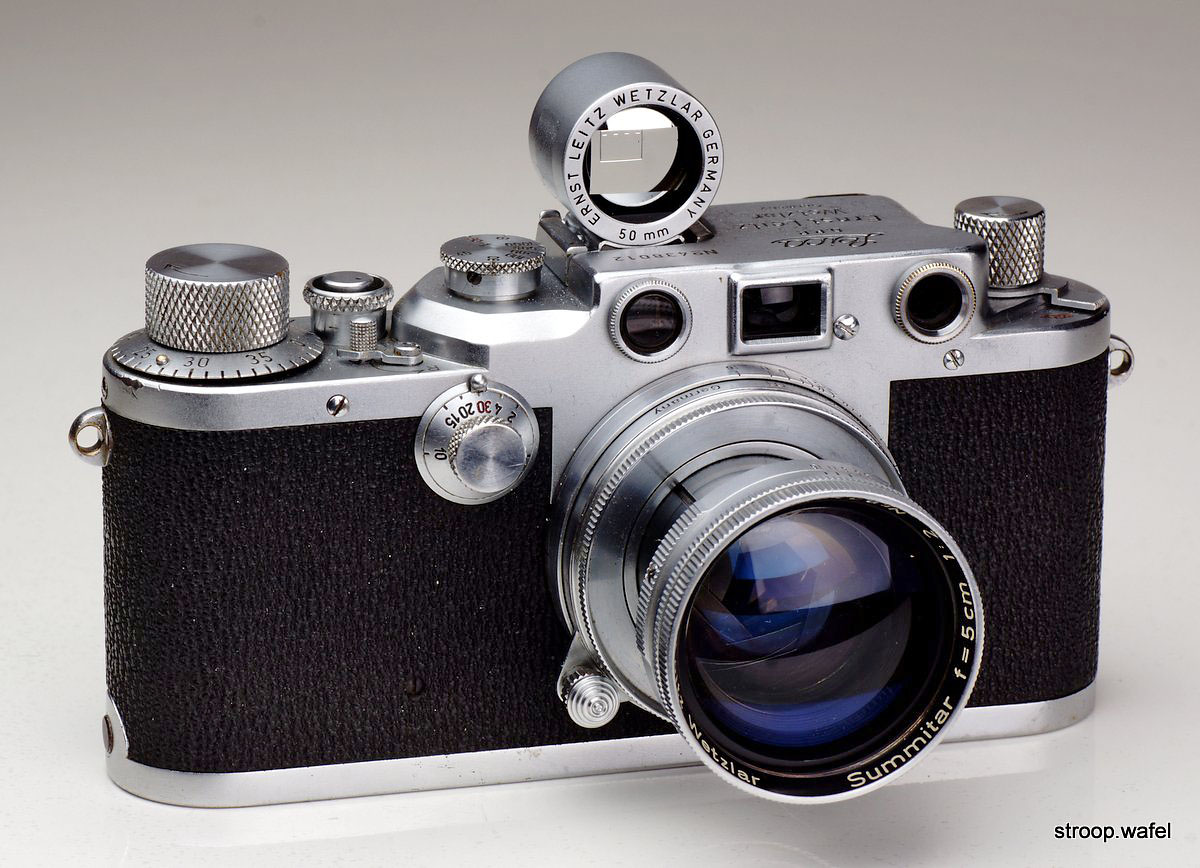
A 1947 Leica IIIc with Leitz Summitar 50mm f/2 lens. A somewhat disappointing aspect of using screwmount Leicas up till the IIIg was the underwhelming viewfinder. However, Leica did, however, produce a separate 50mm viewfinder, named SBOOI, and this is simply the best viewfinder I have ever used. Its view exactly 1:1 so one can keep both eyes open whilst looking through the viewfinder and see a frame projected in your field of vision. It works in near darkness and is exceptionally clear. These are not cheap but definitively worth it. The one pictured here is a later version (ca. 1958) with markings in capitals letters and focal length in mm.
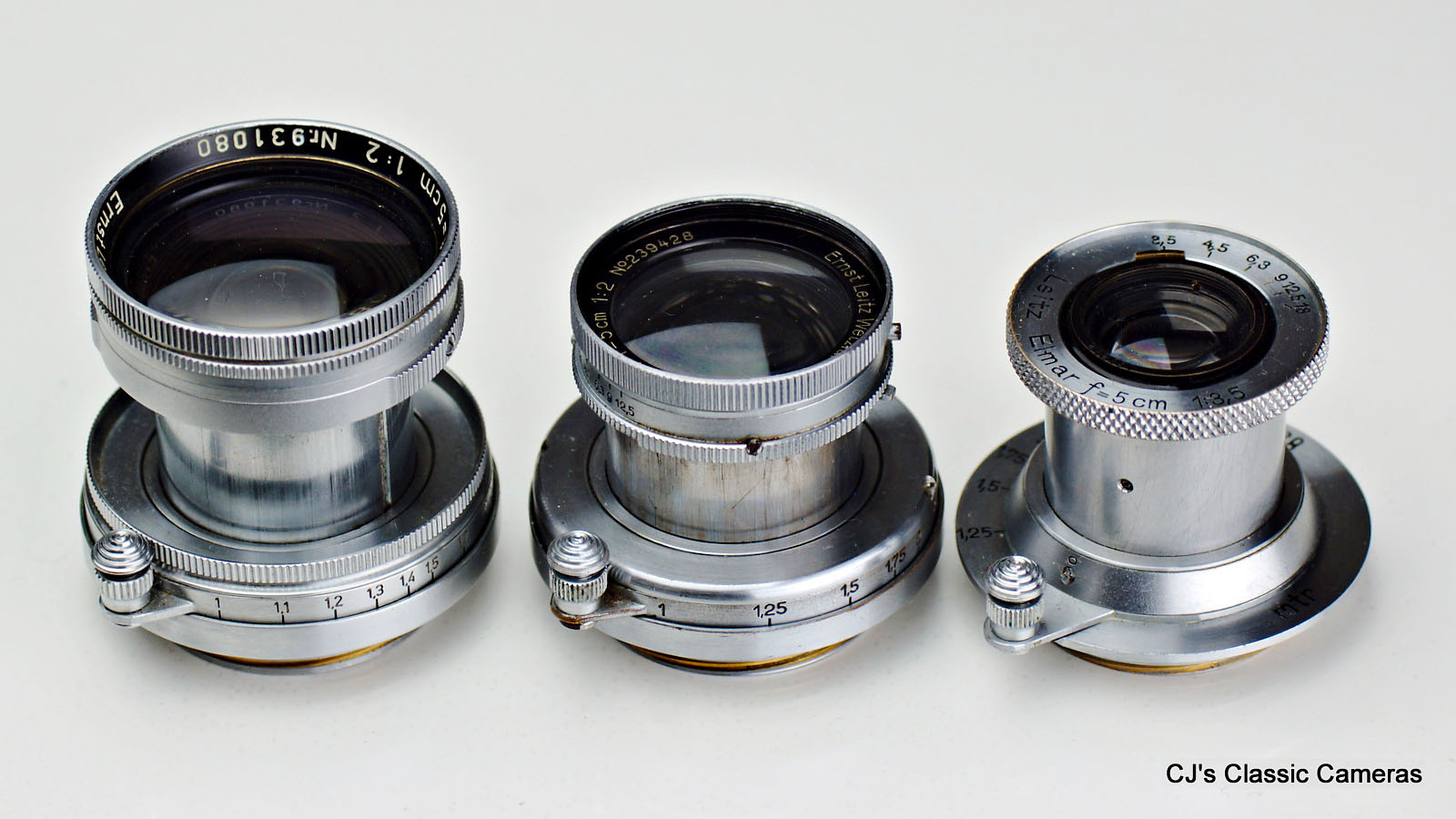
Three different standard lenses were available in Leica screw mount, from left to right the f/2 Summitar, the f/2 Summar and the f3.5 Elmar (later updated to f/2.8), ignoring the f/2 Summicron which was introduced near the end of the screwmount era. Although the Elmar f/3.5 is an excellent lens, I prefer the larger aperture of the Summitar and the associated shallower depth-of-field. It is also an extremely sharp lens, it being a seven-element lens with large front element, at smaller apertures easily outresolving the 24 MP APS-C sized sensor on my DSLR camera. That said, I find the Summar the best looking lens of the three, preferring its rounded base and smaller front element over the Summitar on screwmount Leicas.
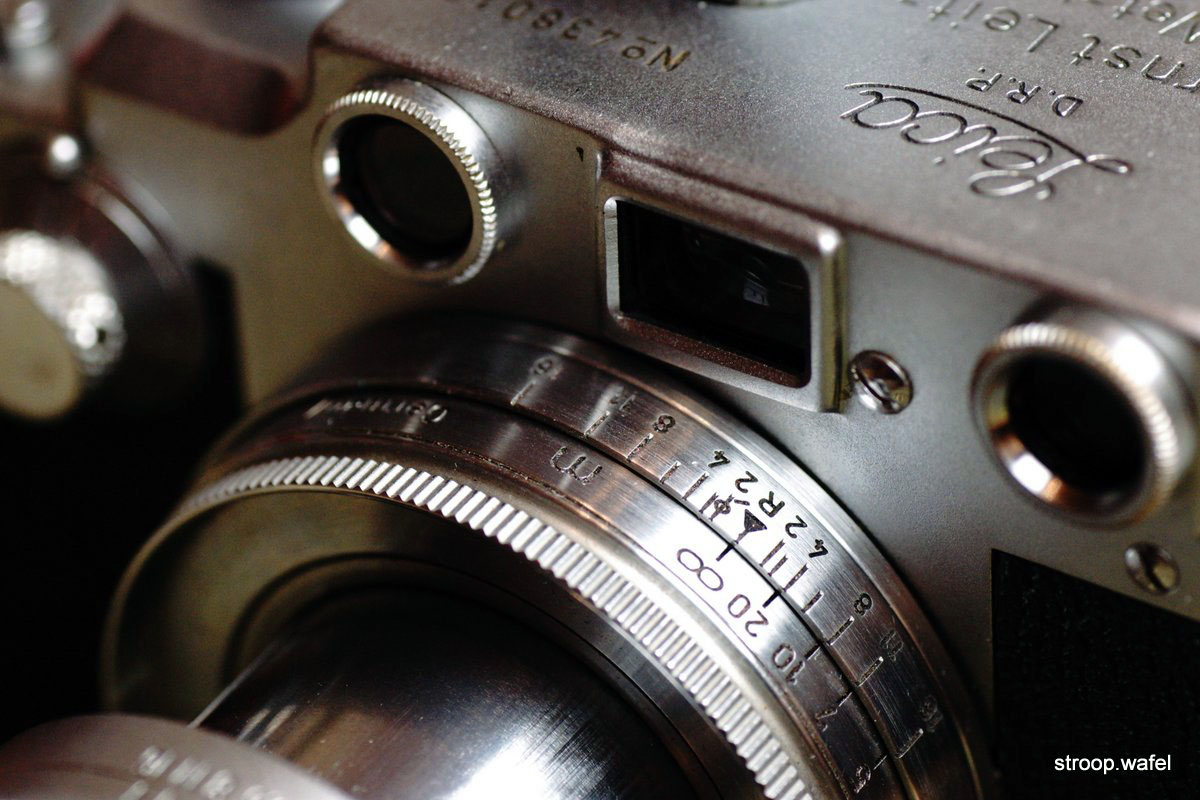
Detail of the Leica rangefinder windows and Summitar lens base taken with the Elmar mounted on a Sony A77 DSLR. As the register distance of the Sony is much larger than that of the Leica screw mount, the Leitz lenses make great macro lenses. As they can be partially collapsed the maximum focus distance is about 4 ft.
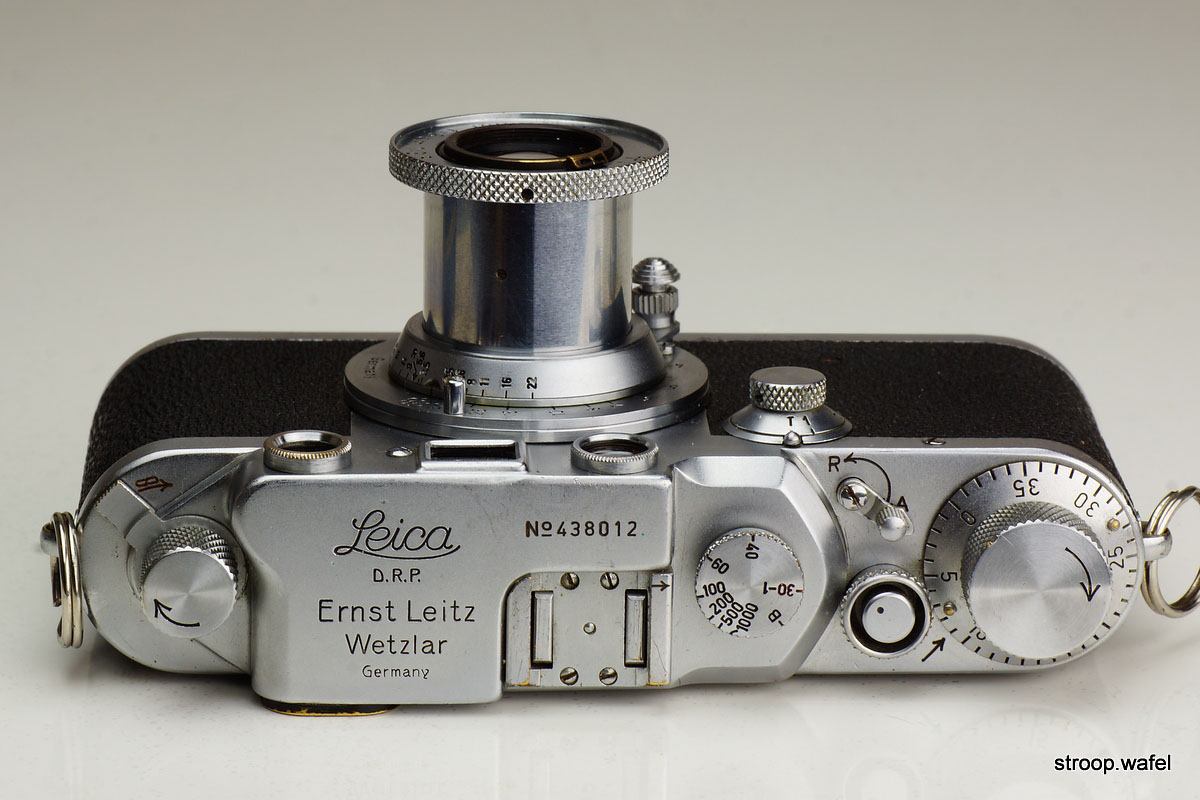
Top view of a Leica IIIc with the collapsible lens extended.

The screw-mount Leicas are bottom loading cameras and rather inconvenient to load as the film leader needs to be cut to slide properly over the sprocket wheels. Luckily Leica provided a little diagram at the bottom of the camera to remind people of this, a feature that other bottom loaders should perhaps have thought of (Iloca!).
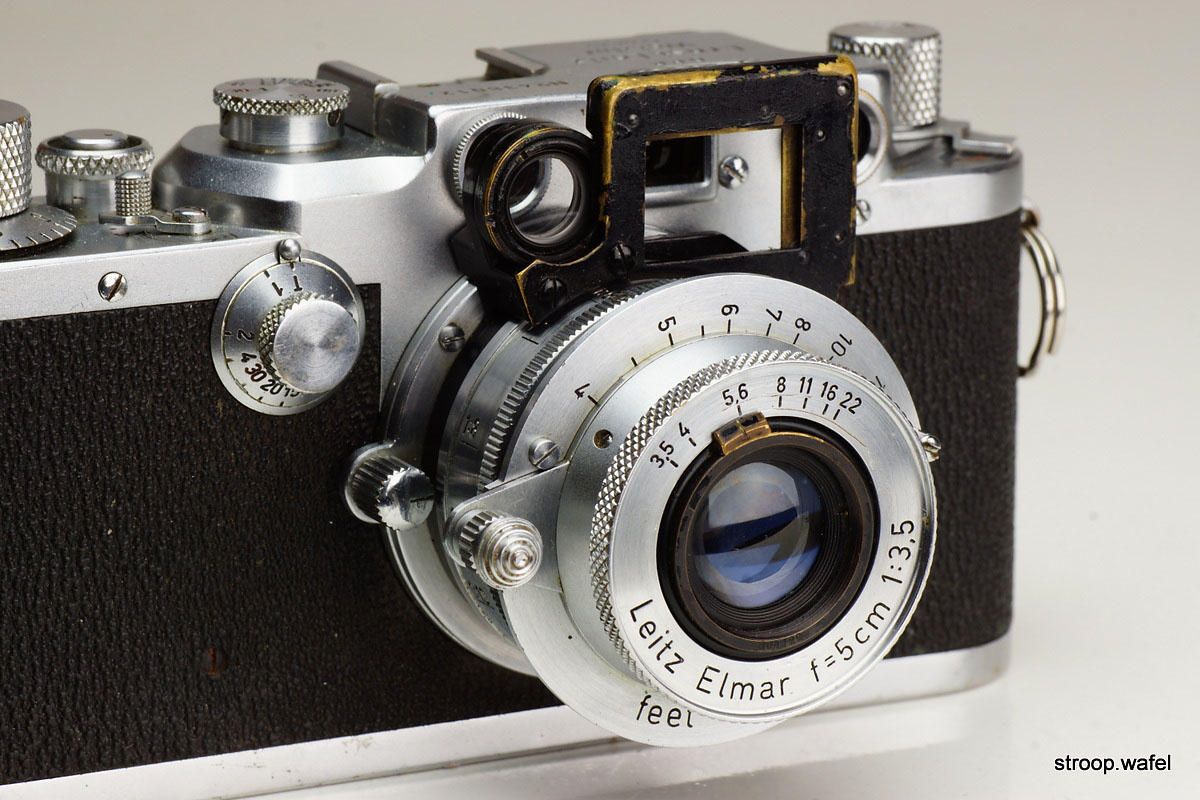
One of the fun but frustratingly expensive things about Leicas is that there are so many accessories available. Many had funny five-letter acronyms, this close-up attachment had the unfortunate name NOOKY. It screws on the lens mount and the collapsible Elmar is then inserted, its own focussing mount still attached. It allows near-macro photographs with a maximum enlargement of 1:6.5.
The Leica IIIf was very similar to the Leica IIIc and the two were in fact hard to distinguish when viewed from the front. The main new features were a flash sync, which was located at the back of the camera next to the eye piece of the viewfinder, and a film reminder dial integrated in the wind knob. The speed dial was also slightly larger than the one on the IIIf and contained a synchro-dial to adjust the flash exposure settings.
Three different versions of the IIIf were produced in about equal numbers, the first had black synchro-dial numbers (hence called 'black dial' or BD), the second version had red numbers (i.e., red dial or RD), whereas the last version added a selftimer to the slow speed dial (hence RD ST).
The flash settings were a little idiosyncratic to say the least, but the system was designed to make high-speed flash synchronisation up to 1/1000th of a second possible. Some sources on the internet claim that the flash only worked at 1/30s, but that is only true when using electronic flash. Of course not many people use flash bulbs these days, so these sites have a point, but with the right flash bulbs high-speed synchronisation was possible.
The synchro-dial setting was dependent on the shutter speed with higher values for slower shutter speeds. The values were provided as a table which also listed the effective guide number from which the aperture setting could be calculated.
(Top) Rear view of a 1951 Leica IIIf BD showing the flash sync next to the viewfinder eye piece and the flash synchro dial beneath the speed dial. The black numbers of the synchro dial indentify this IIIf as a 'Black Dial'. Leitz provided a special flash sync plug (shown in the image) which would not poke into your eye when using the viewfinder.
(Bottom left) Detail showing the film reminder dial integrated with the wind knob. (Bottom right) The lens mounted on the camera is a red scale Elmar f/3.5, the last Elmar f/3.5 of the many incarnations produced by Leica. Earlier Elmars had the focus scale on the bottom ring and DOF scale on the barrel, so the other way around compared to the red scale Elmars.
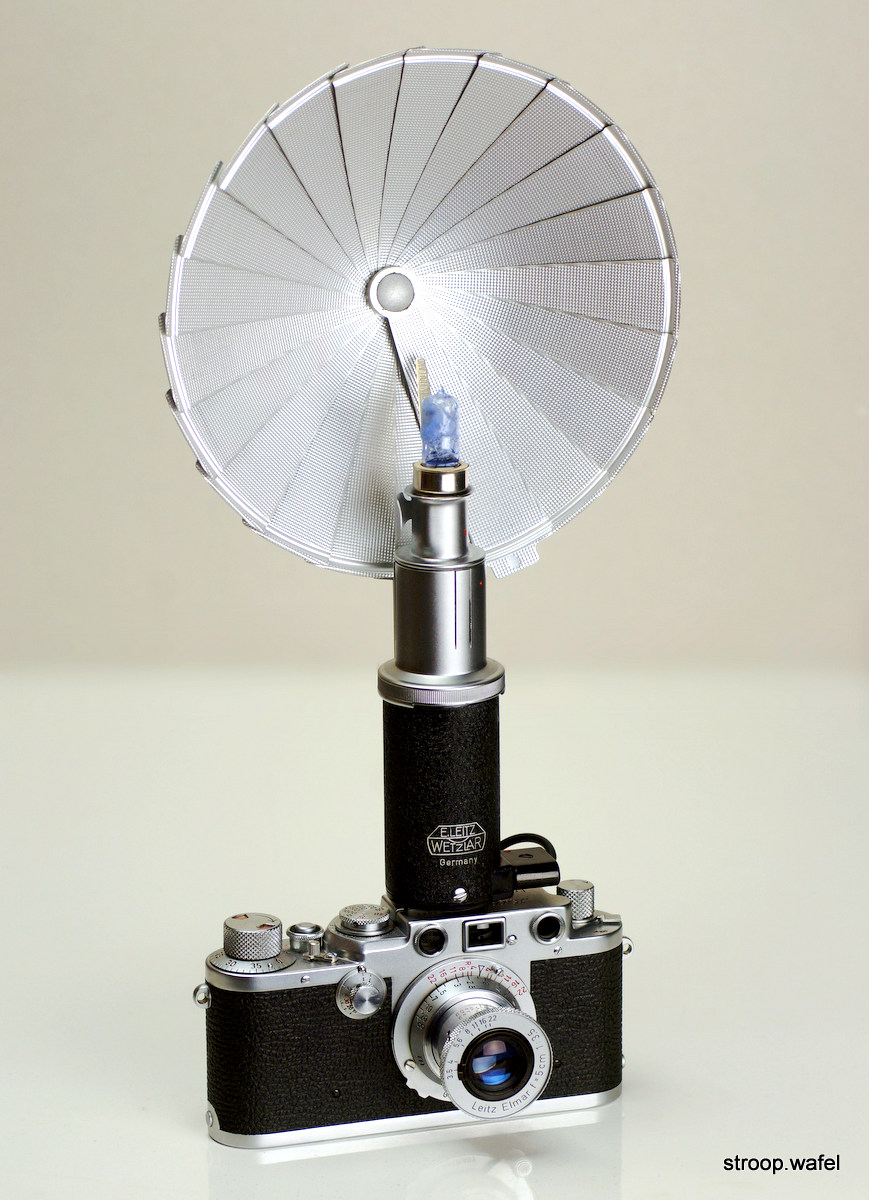 |
Leica IIIf with the rather large, dedicated Leica flash unit 'Synchronblitzer' a.k.a. CEYOO, which fitted onto the camera's accessory shoe. |
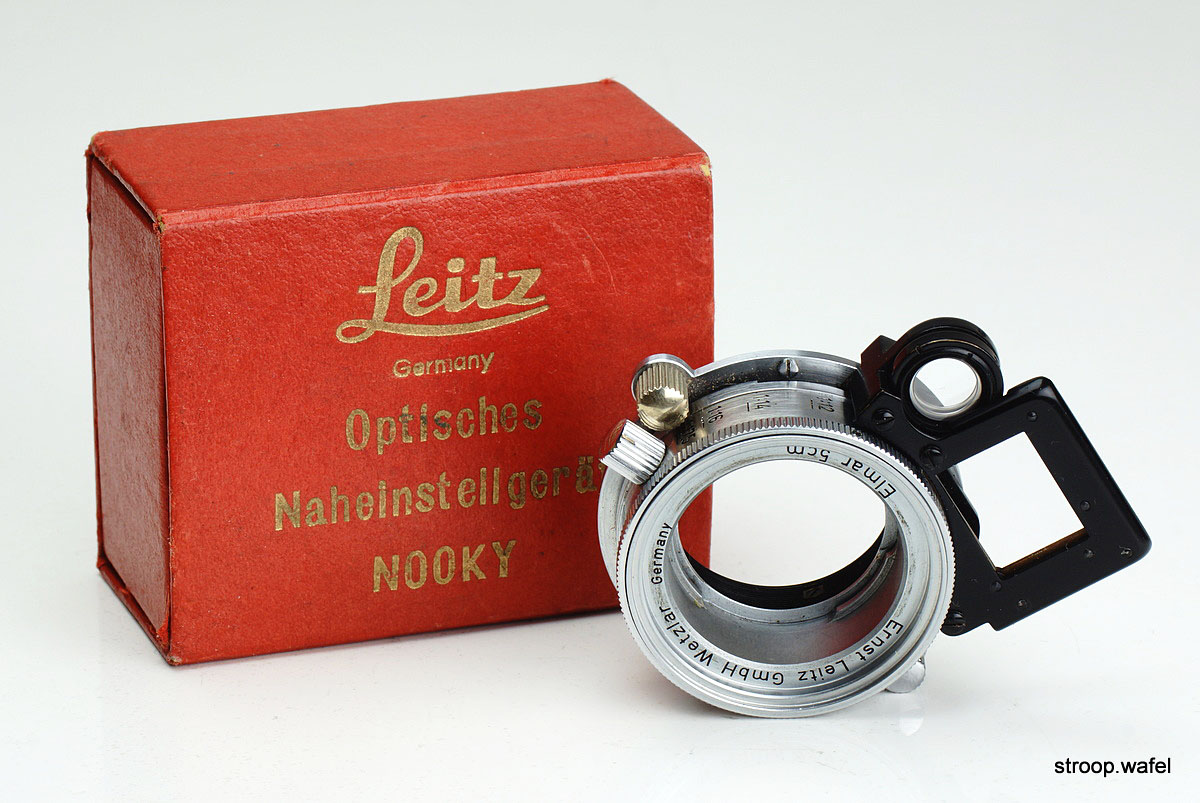
Here is a NOOKY close-up attachment with its original box. This one is for the Elmar, other versions were available for the Hektor, Summar and Summitar lenses (the NOOKY-HESUM) as well as the Summicron (the SOOKY).
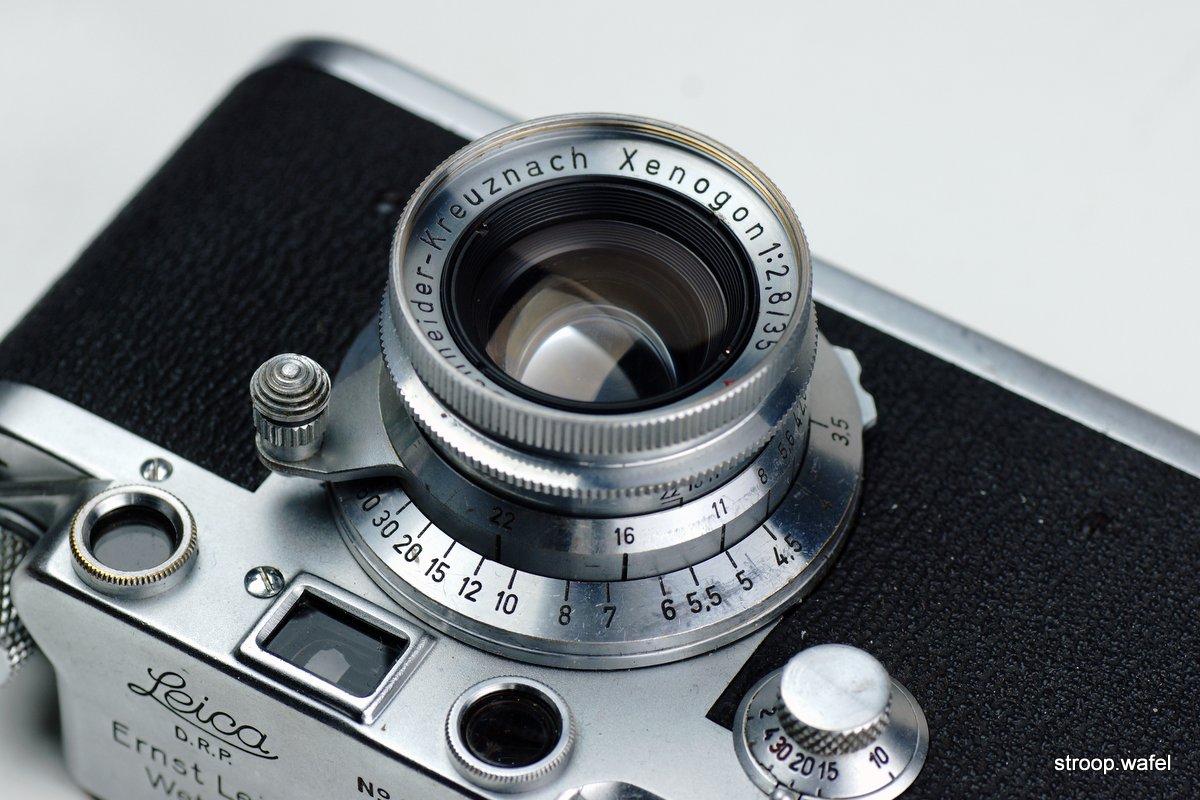
A rather uncommon wide angle lens in Leica screw mount was the Schneider Kreuznach Xenogon 35mm f/2.8. It was introduced around 1952 at a time when the fastest Leitz 35mm lens was the f/3.5 Summaron. It was presumably intended to compete with similarly fast Canon Serenar and Nikon W-Nikkor 35mm lenses. Leitz did not introduce a f/2.8 35mm lens until 1958.
Based on the serial numbers the Xenogon was produced until about 1957. As the serial numbers cluster strongly it appears they were made in small batches of a few 100 at a time, in total probably less than 2000 were made, most of them in 1952 and 1953.
The name Xenogon was probably derived from Xenon, as it had a similar optical formula of 6 elements in 4 groups in a symmetrical configuration, just like the Seranars, W-Nikkors and Summarons of the time. Note that this lens was different from the more common Xenagon, which was a 4-element lens derived from the Xenar, and as far as I am aware not available in Leica screw mount.

No Leica collection is complete without one of the telelenses. The 90mm f/4 Elmar had the best reputation, at least in the screwmount. This is a simple lens to clean and maintain; the front part of the lens simply unscrews from the focussing tube to provide easy access to the lens elements.
By lack of the proper Leitz 90mm viewfinder I mounted one from a neighbouring company in Wetzlar, Leidolf.
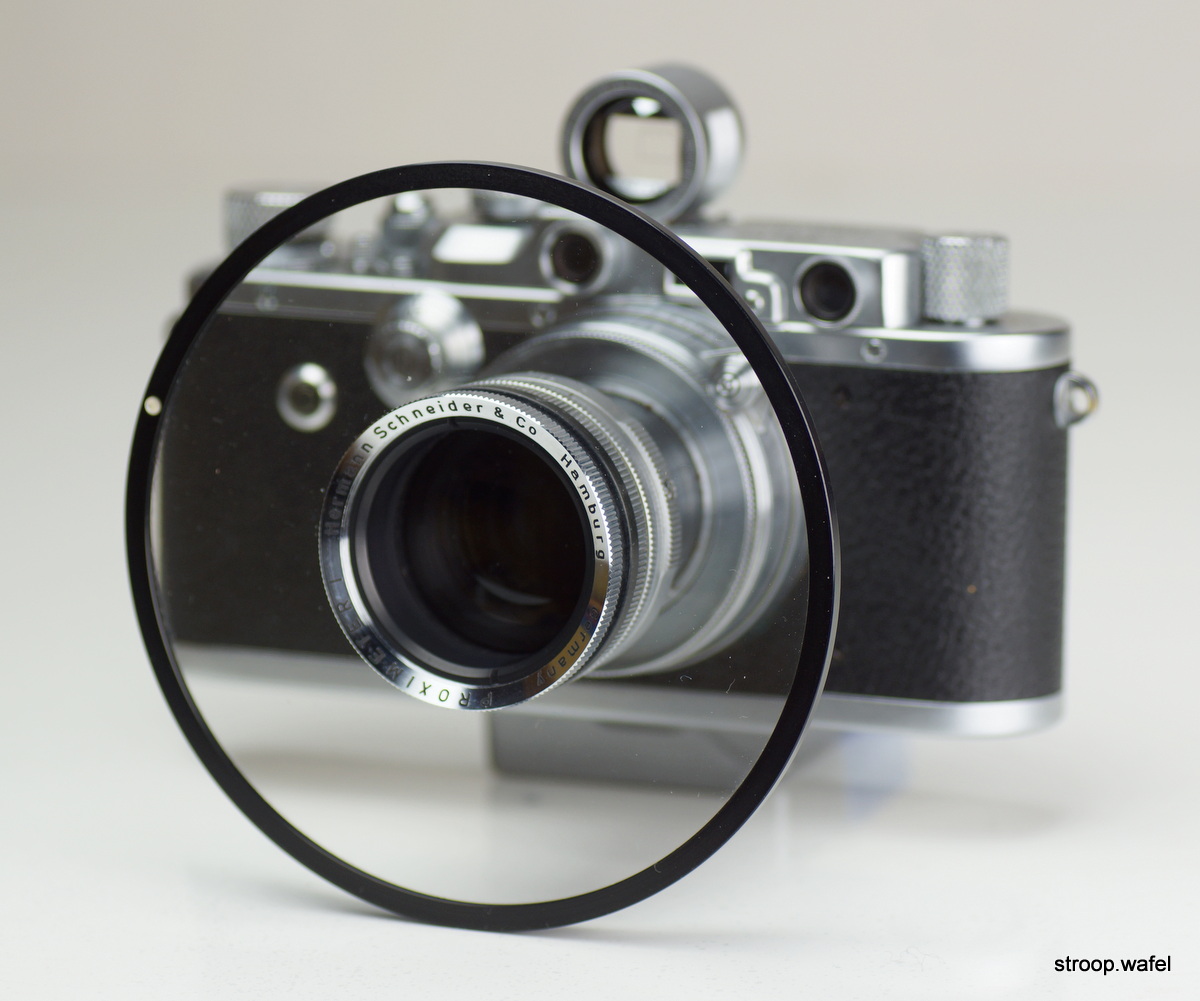
A rather unusual accessory for the Leica was the Proximeter. Proximeters were available for many cameras and usually included a close-up lens to mount on the camera lens as well an additional lens in front of the rangefinder which would compensate for distance and parallax. This particular one was a large round disc that contained both lenses. I actually had no idea these were made for Leica also, as there already was the NOOKY range of close-up attachments. I had seen one of these large round ones on a King Regula, so expected it to fit to Cassar lenses. However, it did not fit any of my cameras until I, mostly out of desperation, finally tried it on the Summitar. It fitted! Then I noticed in the included instructions that Leica was indeed listed. I have not yet tried how well it works. Advantage compared to the NOOKY is that one does not need to remove and remount the lens, potential drawback is that the close-up lens may degrade image quality.
Fed-1 G
In the 1930s FED was the first company (or rather labour commune) to produce a 35 mm camera in Communist Russia. They chose their example (the Leica I!) wisely, although admittedly at that time the choice was limited. Initially based on the Leica I and II, the FED range slowly evolved into a range of increasingly different cameras. It became a hugely popular range with many million cameras produced. Many subtypes of each model existed, so a bewildering range of these cameras was available.
The first type, simply designated FED but now called Fed-1 to distinguish from later models, kept its clear Leica II heritage until the last version, the 1953 Fed-1 G. Enterprising individuals have used this similarity to convert FEDs to fake Leicas, but these are usually easy to spot due to several small design differences. That said, early FEDs may fetch prices comparable to Leicas in their own right.

A 1956 Fed-1 G (#561825) with collapsible Fed 50/3.5 lens, the latter clearly a copy of the Leitz Elmar although the optical formula was different and more similar to a Tessar design. The 'G' was the last Fed-1 model, the following Fed-2 no longer looked like the original Leica II although it would still take the same 39mm screwmount lenses.
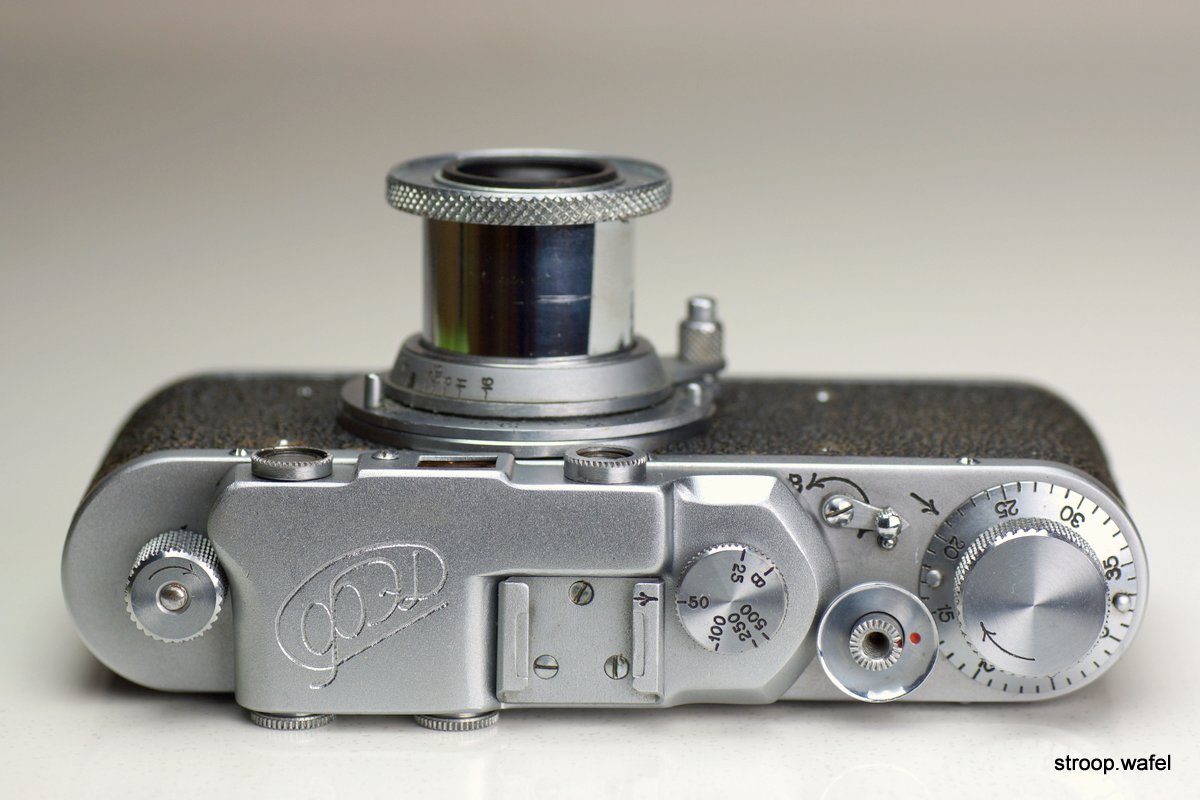
Top view of the same camera. Compare this with the same view of the Leica IIIc above and try to spot the differences! One give-away is the collar around the shutter release, which on the FED rotates during winding the shutter.
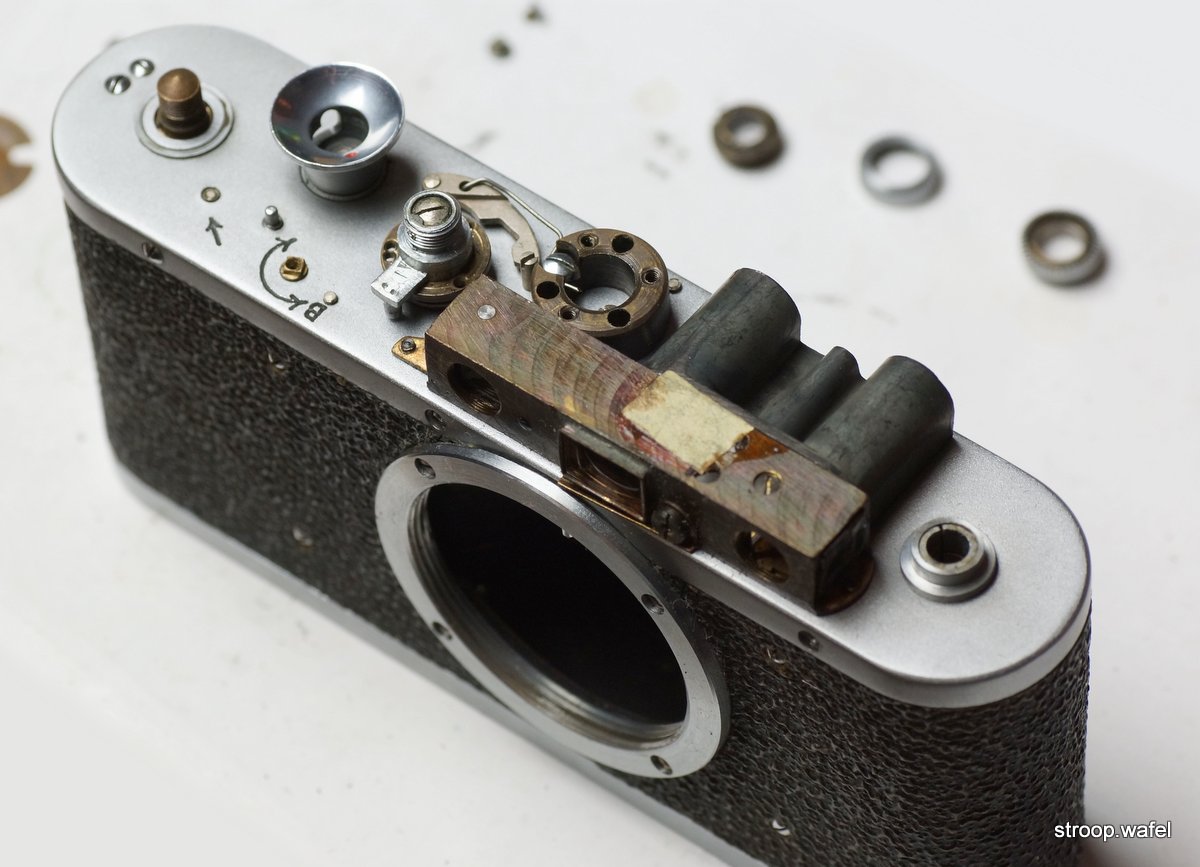
Opening up a FED seemed more sensible than doing the same to a working Leica...
Fed-4
The Fed-4 was the first Fed camera with a built-in selenium light meter. Fed was rather late to do so; when the Fed-4 was introduced in 1964, German cameras had these light meters for about 10 years and in fact, selenium cells already started to be phased out in favour of CdS cells on many Japanese cameras. Even then the light meter on the Fed-4 was uncoupled, so settings had to be transferred manually to the shutter. On the other hand, Leica itself did not introduce metering until the M5 in the early 70s.
The first Fed-4 model looked a lot like the Fed-3, with a large chrome top housing and small rangefinder windows. Its most peculiar feature was the lack of rewind knob, which had made way for the light meter unit and was therefore replaced by a rewind wheel at the side of the camera. Had the wheel been larger like on the Ferrania Lince it would have been all right, but unfortunately it was cumbersome to use. Around 1969 the Fed-4 was updated with a more modern-looking viewfinder frame and a wind lever, although the rewind wheel stayed. Despite the niggles it was a well-functioning and successful camera with a long production run of about 15 years and over 1 million units being build.
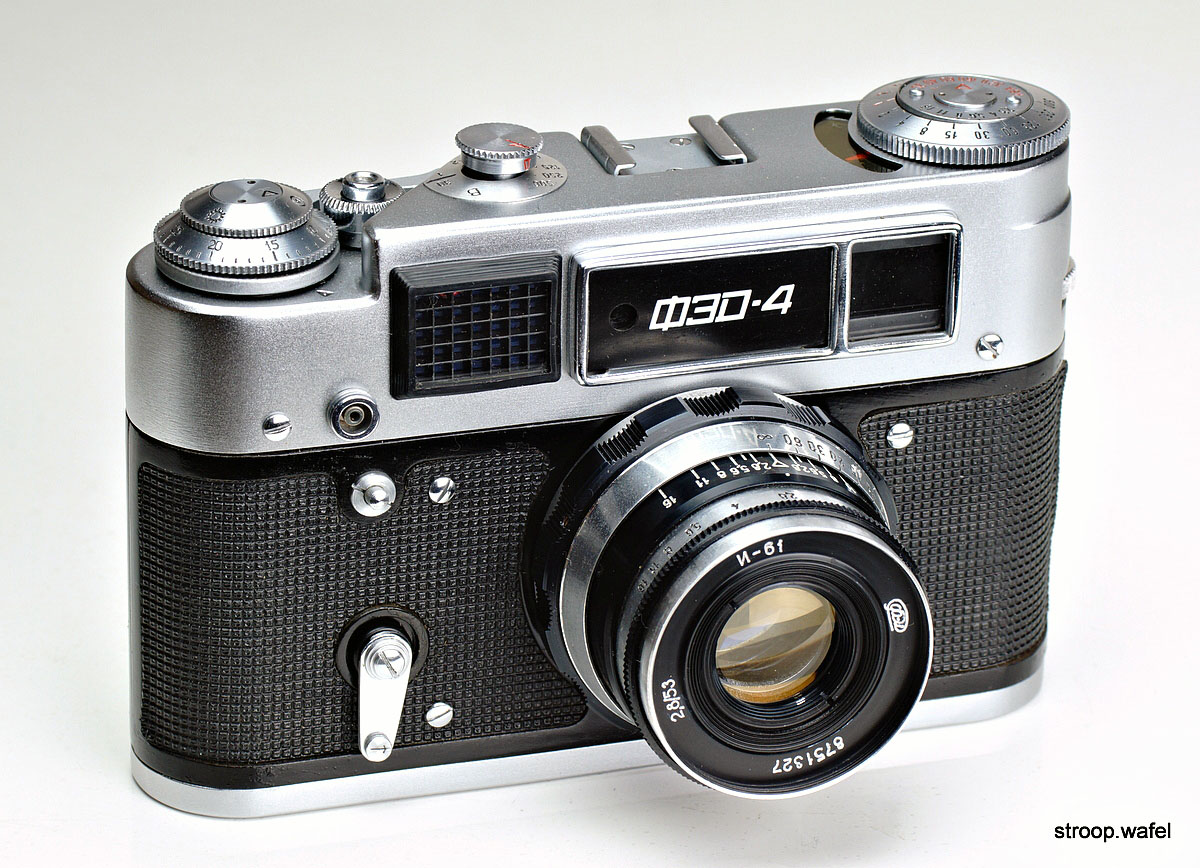
Late version of the Fed-4 with amber-coated Industar-61 53mm f/2.8 lens. All Fed-4 had this model lens but quite a few different versions existed, with various focal lengths (52mm, 53mm and 55mm) and body types (chrome, zebra chrome and black, or mostly black). Later versions had the suffix L/D (in cyrillic), the L apparently referring to lanthanum, a heavy element added to glass to increase its refractive index while keeping dispersion low.
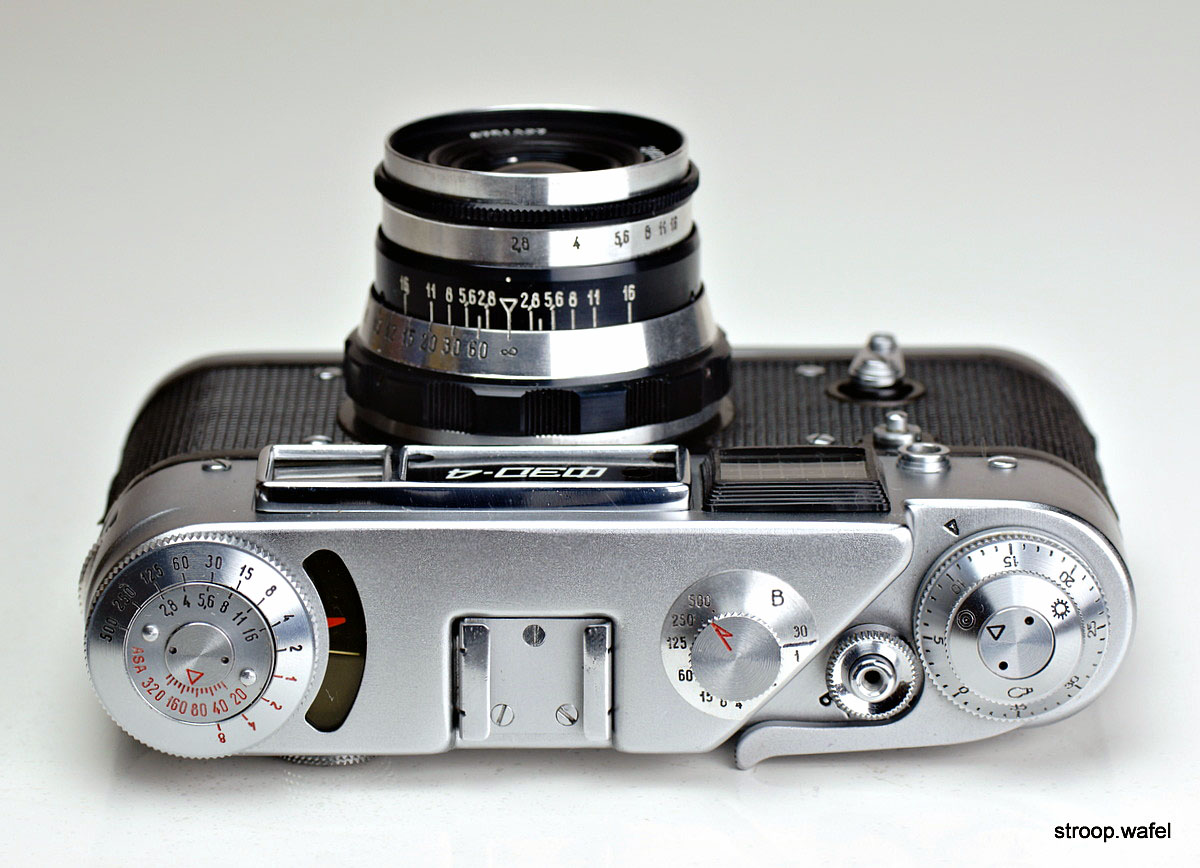
Top view of a Fed-4 showing the peculiar slanted edge of the op housing to make room for the wind lever. Note the simple uncoupled light meter on the left. Also note the range peculiar order of shutter speeds, with 1/30 in-between B and 1s. Like most Russian 'Leica copies', the shutter speed of this model can only be set after cocking the shutter and one should also not move the shutter speed dial from 1/30 to 1/s or vice versa, I drew a small line as a reminder.
Zorki 4K
The other Russian Leica copy one may come across is the Zorki. These were produced after the war, mainly for export. The first model again appeared to be based on the Leica II, but in fact it was a copy of the original FED. The FED factory had been destroyed during WWII and was having trouble getting production started after the war had finished. Therefore, production was moved to a different factory and early cameras were called Fed-Zorki. Later on the two brands diverged and produced their own camera ranges.
The Zorki 4K, first produced in 1972, was the first model with rapid wind lever and looked little like a Leica copy anymore. It came with flash sync, time delay and large viewfinder window. About half a million of these were made. Somewhat ironically, at a time when the SLR camera had made the rangefinder system camera nearly obsolete in the West, Soviet copies like the FED, Zorki and Kiev kept the tradition alive.
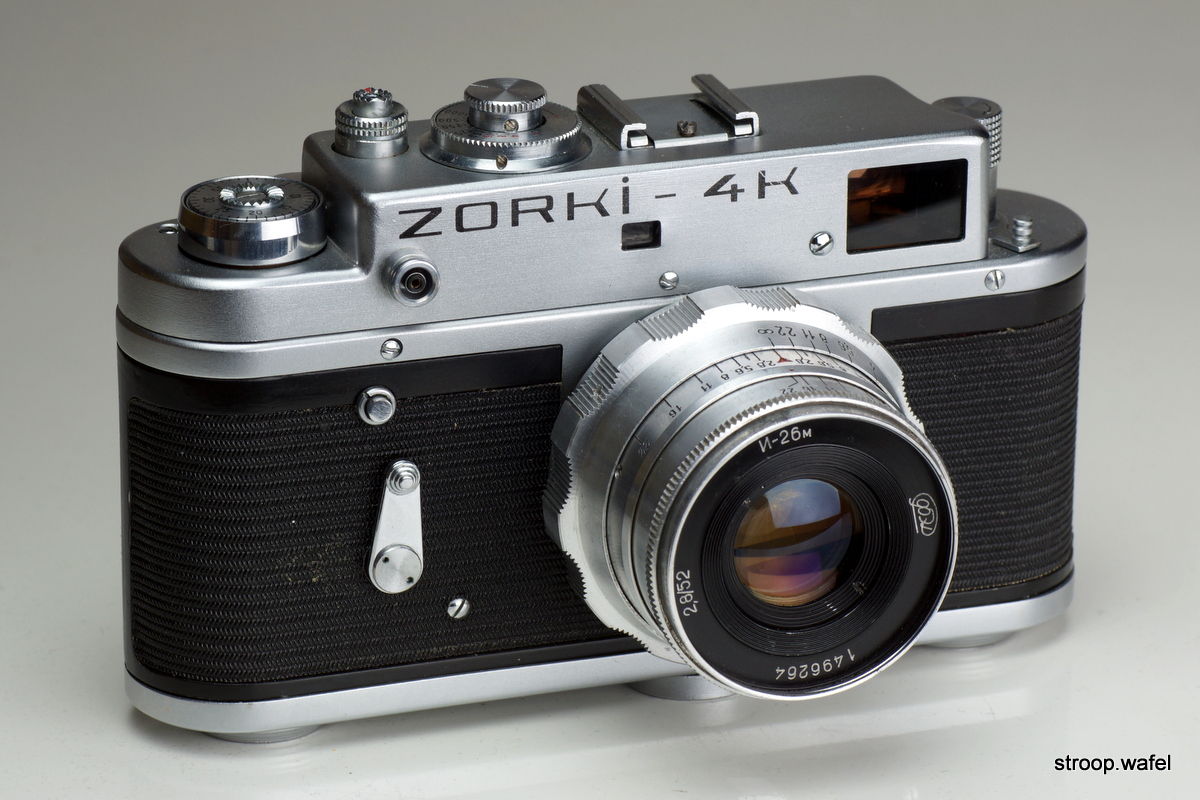
A Zorki 4K, which normally came with Jupiter 50mm f/2 lens but here with an older FED-branded Industar 26M lens. One drawback of most Russian Leica copies was that the shutter speed dial should only be set after the shutter was cocked, failure to do so could jam the shutter mechanism.

A Zorki 4K with top and front removed to provide access to rangefinder and shutter mechanism.
GOMZ Leningrad
A lesser known Russian Leica copy was the 1956 GOMZ Leningrad, although calling it a Leica copy does not do it justice. It had little more in common with the original Leicas than the screw mount, and in contrast to Fed and Zorki cameras the Leningrad was designed from the ground up. Its most distinguishing feature was the spring motor, which allowed taking many photos in rapid succession. It was very well-build but expensive and heavy camera that won in fact a reward at the 1958 World Exhibition in Brussels. It was only produced in (for Russian standards) small numbers (<100,000).
Despite its new design the camera did have some features reminiscent of other cameras. It feels more like a Kiev (Contax copy) than other Russian Leica copies and in fact the bottom plate is very similar to Kiev ones. In addition, the large spring motor wind knob and speed selector are reminiscent of the Finetta 99. Also the spring motor release for rewinding film at the bottom of the camera is the same as on the Finetta. Whatever its inspiration, the Leningrad designers took this camera much further and is probably the most impressive camera to come out of the former USSR.

A GOMZ Leningrad with Jupiter 50mm f/2 lens. This example was an export model as the name Leningrad is written in Roman script, not Cyrillic. It is missing the rewind knob as well as the speed dial, which I to my shame only noticed after buying the camera.
Canon II-F
Canon will need little introduction as it is still the largest camera maker in the world. The company was founded in the 1930 under the name Precision Optical Instruments Laboratory (POIL), it's first product being the Hanso Canon, a high-quality rangefinder largely based on the Leica II with some modifications. Interestingly, POIL lacked the expertise for making optics and therefore obtained the support from Nippon Kogaku, a company that later would turn into Nikon. So thus the first Canon had a Nikkor lens. More Canon models were soon to follow and Canon started designing its own lenses, initially branded 'Serenar'.
After WWII Canon grew rapidly as a company and introduced several new rangefinder models in the early 1950s, all of which used the Leica screw mount. However, soon after it moved towards SLR cameras, apparently after realising that following the introduction of the Leica M3, it would take too much effort to keep up with rangefinder technology. That this was a wise decision needs little explanation, considering the dominance of Canon on the camera market ever since.
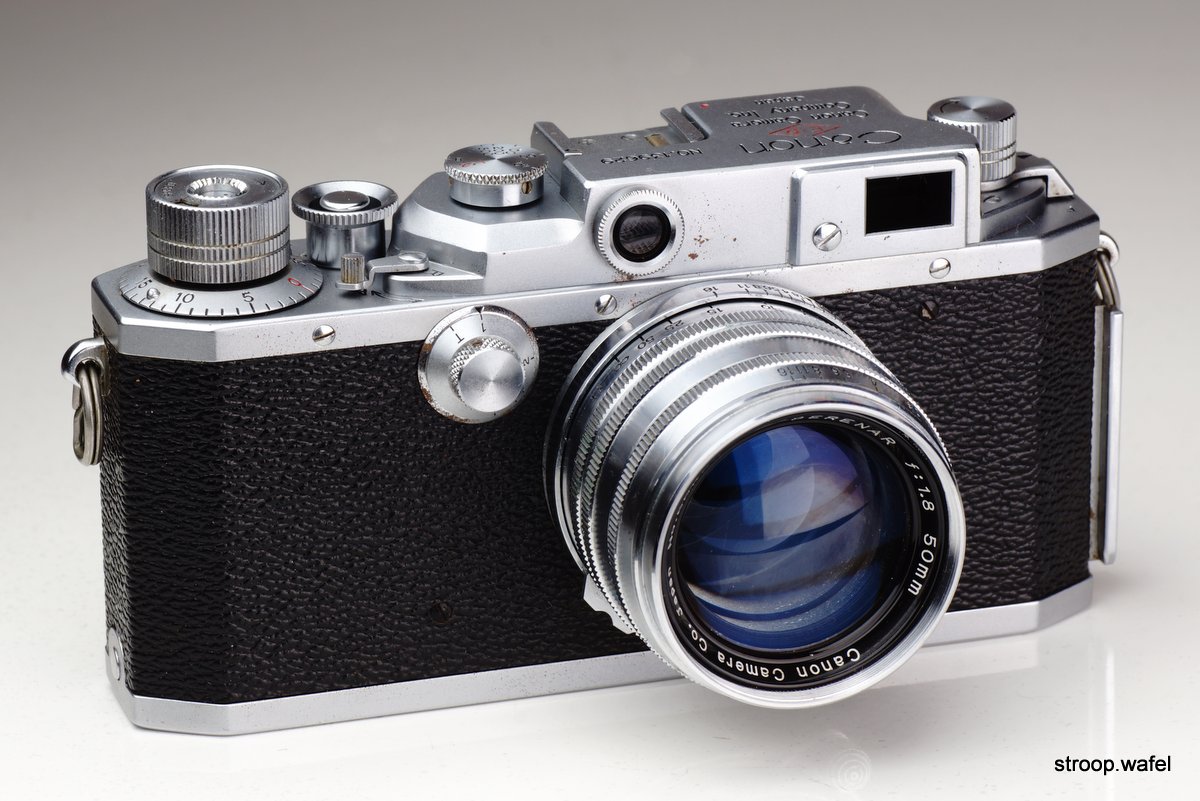
A Canon II-F from around 1953 with Canon Serenar 50mm f/1.8 lens. This lens had an optical design more similar to the Steinheil Xenon and the Zeiss Biotar than to the Leitz Summitar, but had an equally good reputation. I got a bargain on this one as it had a problem with one of its inner rear elements. It turned out to be a fine mist of oil droplets, which was easy to clean and now the lens is back up to its old tricks.

Top and rear view of the Canon II-F. Compared to screw-mount Leicas it benefited from having a single rangefinder/viewfinder window with adjustable magnification for ease of focussing, as well as a film reminder dial in the wind knob. It also featured a slow speed dial, a top shutter speed of 1/500s and a flash sync rail.
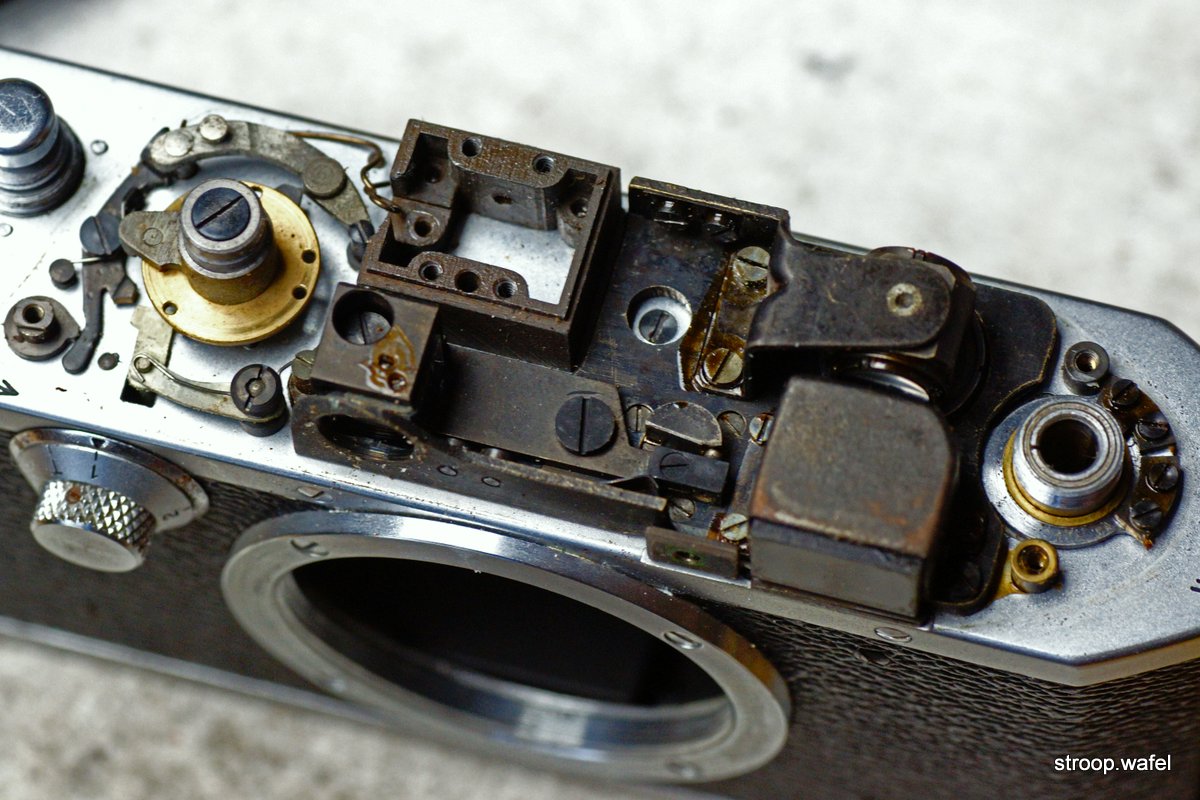
Canon IIF with top housing removed, showing speed dial (left) and rangefinder unit (right). The adjustable magnification of the rangefinder functioned by rotating the small lens unit near the eye piece by 90 or 180 degrees, respectively.
Stripping the camera this far to adjust the rangefinder would be unnecessary: the large screw next to the front viewfinder window hides a horizontal adjustment screw, whereas the vertical alignment could be adjusted by unscrewing the round cover ring of the rangefinder window and rotating the thus exposed glass element (not visible in this photo as it needed to be removed to disassemble the top housing).

As an encore, a Canon II-F shown with a collapsible Canon Serenar 50mm f/3.5 lens, giving it a more classic Leica look. Clearly based on the Leitz Elmar, the Serenar lens is constructed somewhat differently, but does have the aperture directly behind the front element, which is typical of the Elmar design.
Canon P
Although Canon decided after the introduction of the Leica M3 that they couldn't really follow suit and therefore shifted their focus to the development of SLR cameras, this did not mean that Canon stopped producing rangefinders. In fact, they brought out quite number of slightly different models with a confusing range of names. The 1959 Canon P was one of these. It was a simplified and thus cheaper version of the Canon VI L. The P missed the switchable optical viewfinder for use with wide angle lenses and to get rangefinder magnification. Canon introduced two more rangefinders after the P, the 7 and the 7S, which were equipped with build-in lightmeters.
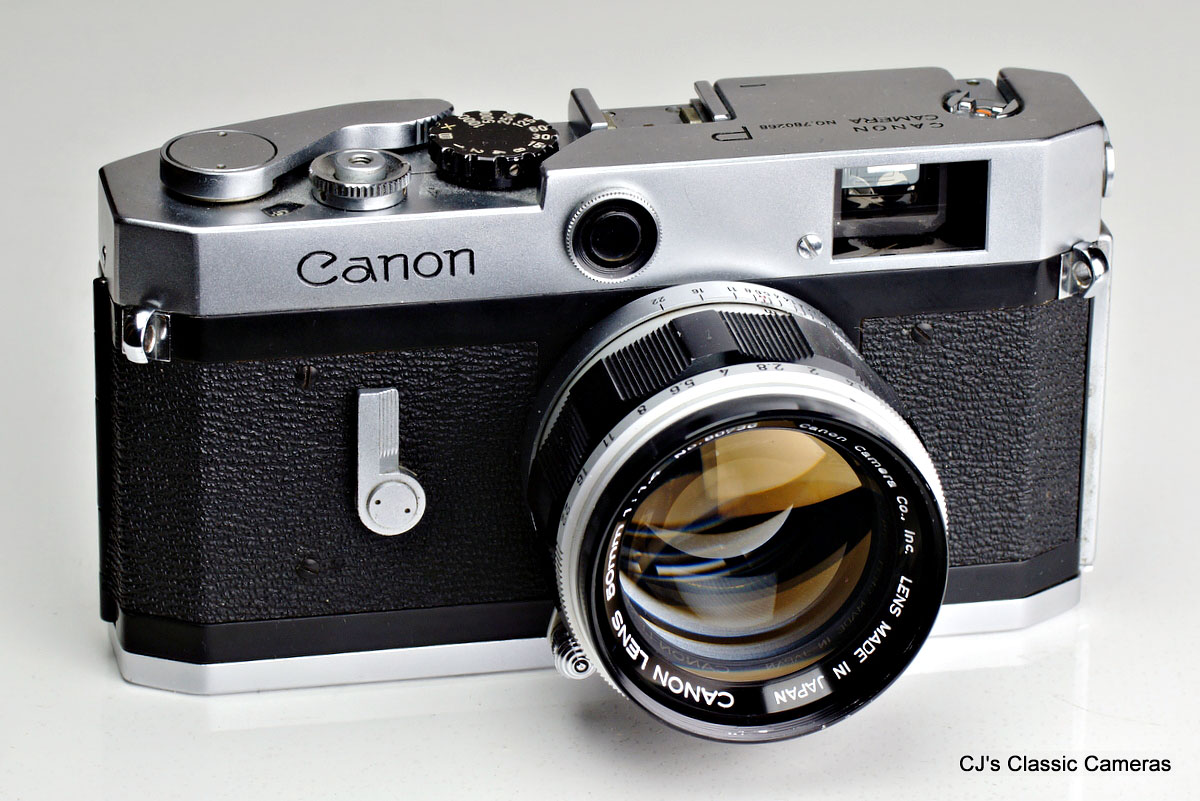
A Canon P with Canon 50mm f/1.4 lens, a wonderful piece of glass developed from the Serenar f/1.8 described above with the Canon II-F, having a similar optical design with 6 elements in 4 groups.
Steinheil Casca
Although Steinheil München has a great reputation as a lens manufacturer, it is not very well known that for a short while the company also tried to gain ground as camera maker. In the late 1940s Steinheil produced two rather remarkable and unique cameras, the Casca I and Casca II. They were focal plane cameras, like Leicas, and perhaps this became the cameras downfall as the rumour goes that their production was halted due to infringements of Leitz patents. True or not, Leitz probably would not have cared so much if these cameras would not have been so far ahead of their time. Particularly the Casca II was a bit of a marvel, with a large brightline viewfinder with projected frame lines for telelenses and a unique bayonet lens mount with a range of lenses of four different focal lengths from 35 to 135 mm.
The Casca I pictured below was more conventional, although it did share its more advanced brother's unique look. However, it missed a rangefinder and slow shutter speeds and the lens bayonet was different so that lenses were not interchangeable between both Casca models.
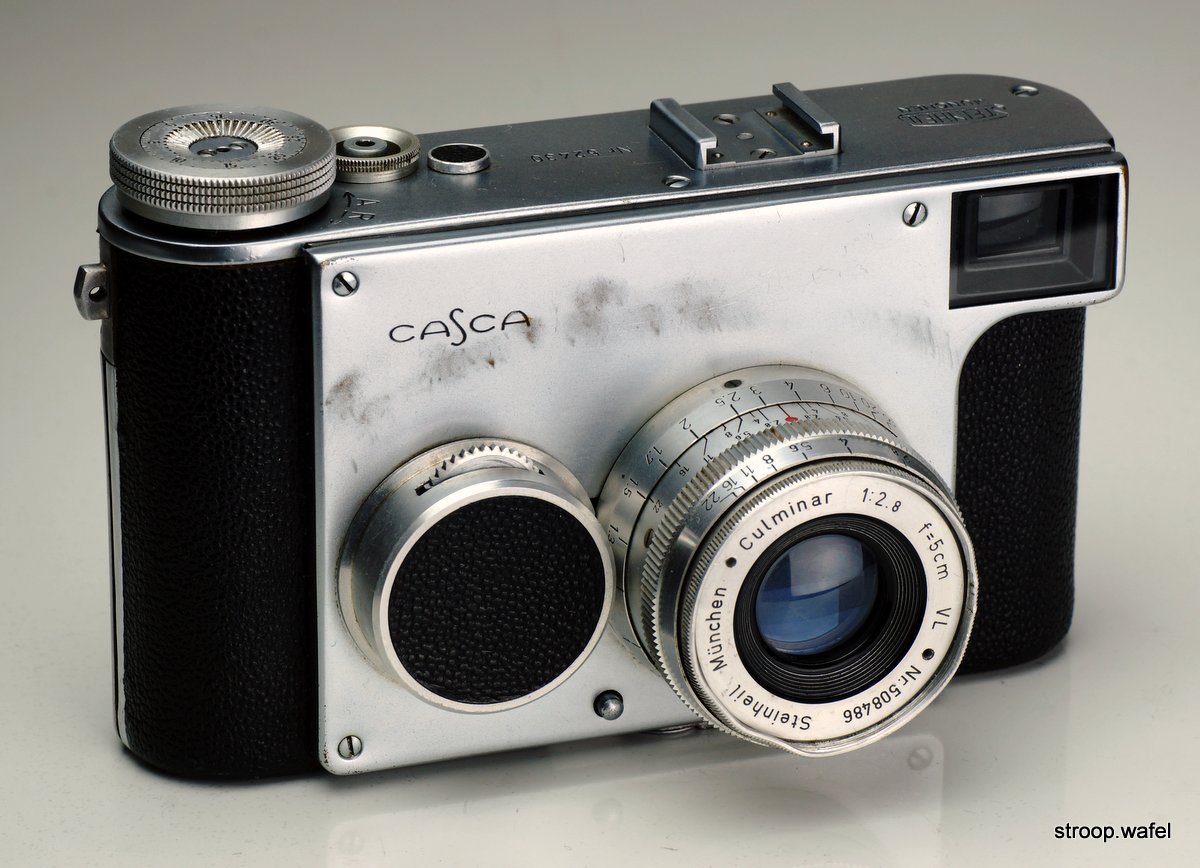
A Steinheil Casca with Culminar 5 cm f/2.8 lens. Perhaps not the prettiest camera but certainly unique. The lens was focussed by rotating the serrated wheel visible on top of the large black knob, but I don't really get the point as the lens was more easily focussed by turning the base of the lens itself. Also one tends to rub one's finder over the front plate, which is perhaps why many Casca's show wear marks there, including this one.
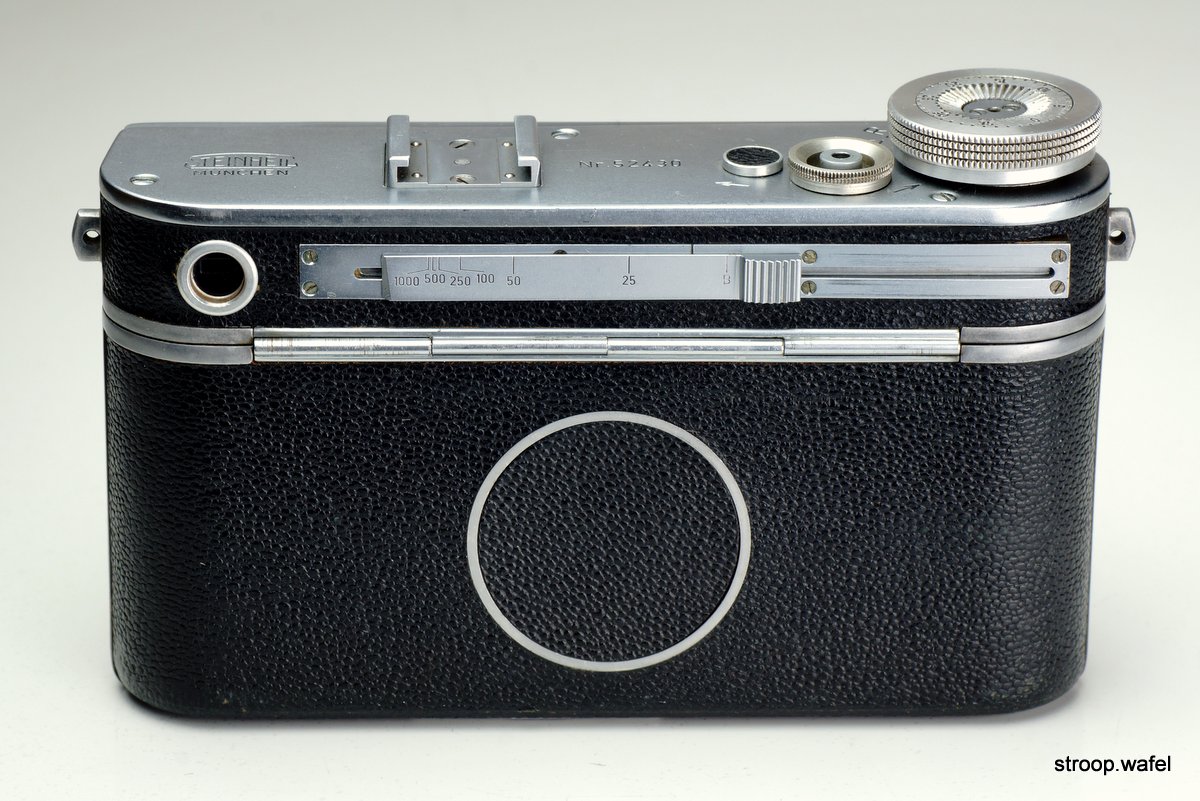
A Steinheil Casca from behind. Note the unique shutter speed selector in the form of a sliding lever at the rear of the top housing. The back of the camera would hinge upwards, making it easy to load film.

Top view of the Steinheil Casca. For those fooled into thinking this was a rollfilm camera due to the lack of a rewind knob, the wind knob also served as a rewind knob. The little black knob on top of the camera switches its function.
My Steinheil Casca came with a non-working shutter, so I made a (so far unsuccessful) attempt at fixing it. The photo on the left shows the body with metal coverings removed, I just re-attached the wind knob for testing the wind mechanism. Note the black paper covering most of the front, including the rangefinder windows for the Casca II.
Top right is the shutter mechanism, which apparently incurred the wrath of Leitz. Only one curtain moves in this example. Bottom right is a top view, which shows the reinforced base plate for the accessory shoe. Also note the viewfinder, just a simple Galilean type not unlike the ones on early folding Retinas and nothing like the one on the Casca II.
INA Navax
Another interesting but less advanced 'Leica copy' was the INA Navax. It was made ca. 1955 by a company which, rather unusually, started with building wooden hand carts (apparently in high demand just after WWII) and then started producing roller bearings. The company still exists. It only ever produced one camera, the Navax, although there is mention that Feinwerktechnik GmbH in Lahr, which made the Mec 16 submini camera, was a subsidiary from INA.
The Navax was a viewfinder camera with a metal focal plane shutter which moved vertically. It used 35mm film but the frame size was only 32x22mm, like the early Minolta 35 and Nikon rangefinders. It featured a wind lever and flash synchronisation, but was let down by its simple viewfinder. It came with a Roeschlein-Kreuznach Pointar 45mm f/2.8 lens, which was decent enough but not of Leica quality (and in fact designed for the Braun Paxette mount, see figure caption). All in all, the Navax was a well-build camera, but rather big and clumsy for its features. It is therefore no surprise that it was only produced in very small quantities.
An INA Navax with Roeschlein-Kreuznach Pointar 45mm f/2.8 lens. This was the standard lens for this camera, but somewhat ironically, it was a lens designed for the Braun Paxette mount (like the Leica, a 39mm screw thread but with a longer register distance) and was fitted onto the Navax by means of an adapter ring, which is visible at the base of the lens.
Leica M3
The Leica M3 was introduced in 1954 to replace the screwmount Leicas, which by then were based on a twenty-year old design. The new camera was revolutionary. It had a bayonet mount for rapid lens changing. It had frame lines for different focal lengths projected in the viewfinder. These frame lines were parallax corrected. The viewfinder was bright with a nearly 1:1 view and a very bright and sharp rangefinder patch. It had all shutter speeds available with a single speed dial. It had a windlever. It had a back that would flip open for easier film loading. And last but not least: it was fully compatible with screw-mount lenses. Some of the features had been introduced before, but the M3 was the complete package and build to an extremely high standard. This was at a time Kodak had just introduced their first rangefinder folding cameras, the IIc and IIIc, Canon still copied Leica III series cameras, and Nikon had barely evolved to models that could match the Contax it was based on. Interchangeable lenses needed additional viewfinders on the camera (as on the Diax range) or as accessories (like the Voigtlander Turnit for the Prominent).
The effect was near immediate. The M3 sold well. Other manufacturers introduced models with multiple framelines. Viewfinders were made larger and brighter. Canon introduced the VT in 1956 as their first rangefinder which no longer emulating the screwmount Leicas. Nikon introduced the superb SP in 1957. And Canon and Nikon started to invest in developing SLR cameras, which would soon take over the world. So perhaps the introduction of the Leica M3, the ultimate rangefinder, started or at least accelerated the demise of that very type of camera.

A Leica M3 with Summicron 50mm f/2 collapsible lens. This example from early 1957 is a double stroke model, later production had a single stroke windlever.
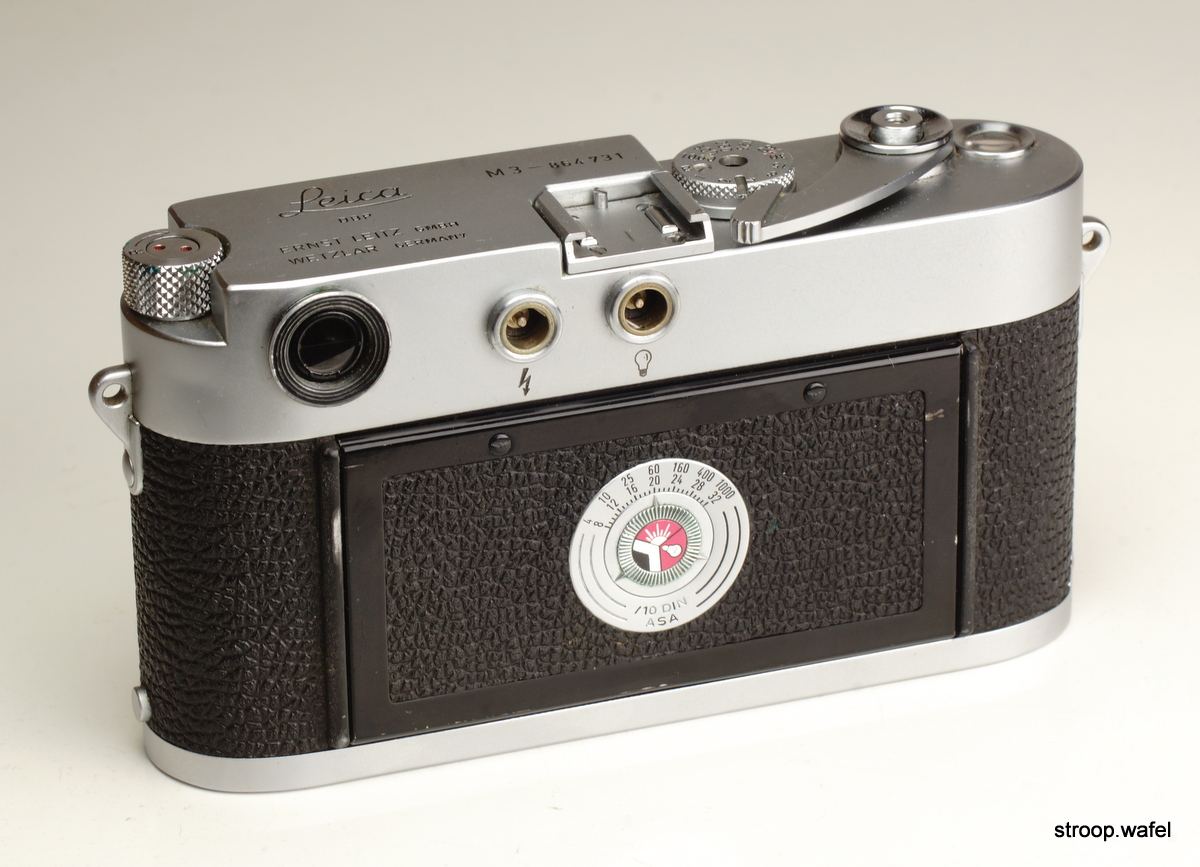
Rear view of a Leica M3, showing two flash connectors and the hinged camera back with film reminder dial.
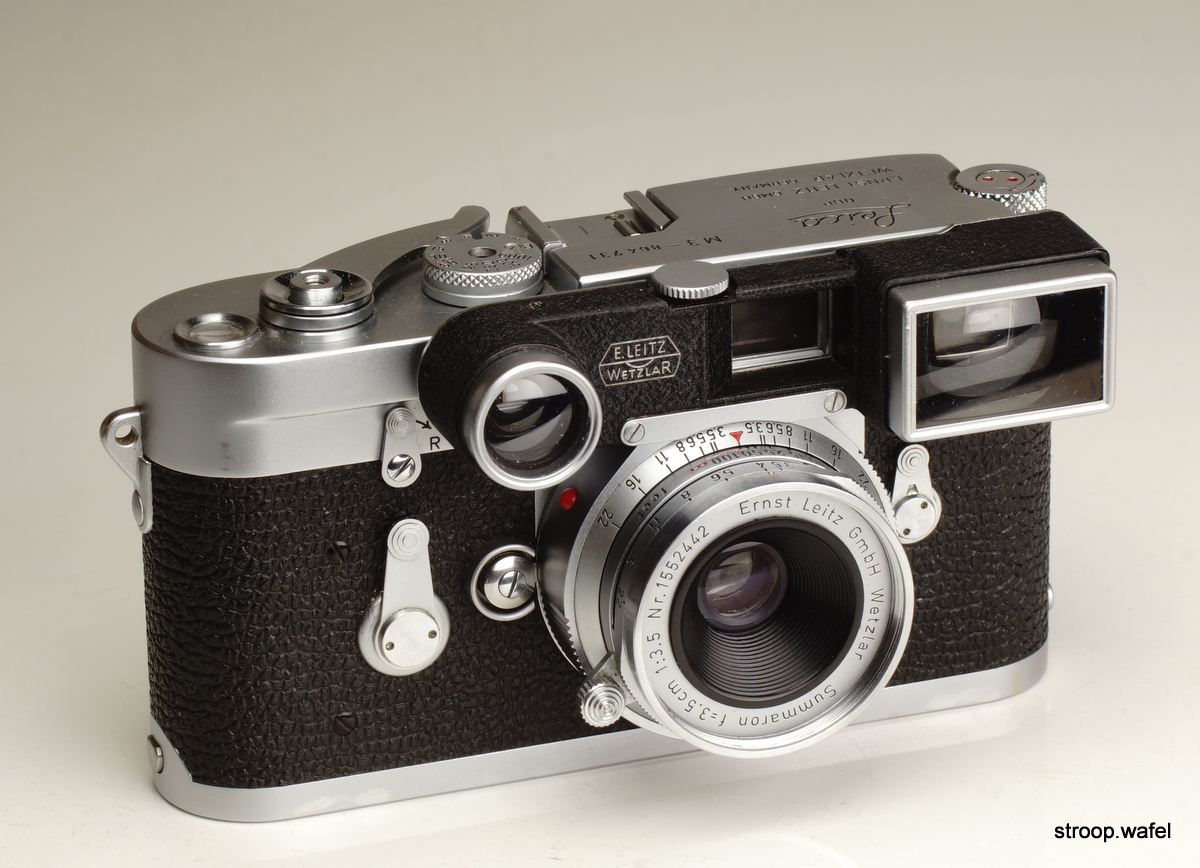
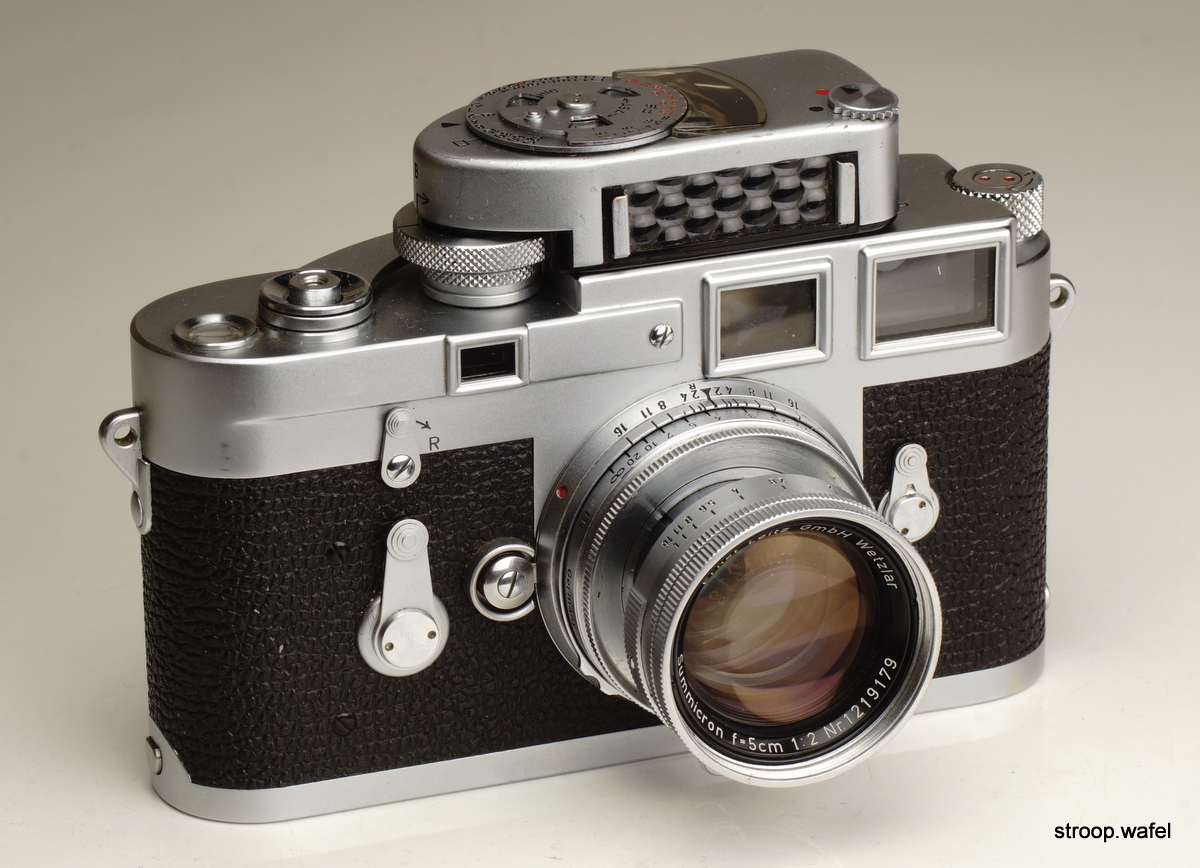
(left) The same Leica M3 with Summaron 35mm f/3.5 lens. As the viewfinder of the M3 had too large a view for 35mm frame lines to be fitted, a set of 'spectacles' was needed which would make the 50mm frame lines appear wider and adjust the focus of the rangefinder patch accordingly. The later M2 had a reduced viewfinder view and therefore a build-in 35mm frame. The spectacles can be removed from the lens by setting the focus to infinity and unscrewing the locking nut on top. A little ball hidden under the spectacles then serves as an infinity lock.
(right) A Leica M3 with Leitz MC meter (by Metrawatt). This light meter coupled to the speed dial, especially useful when working with fixed aperture.
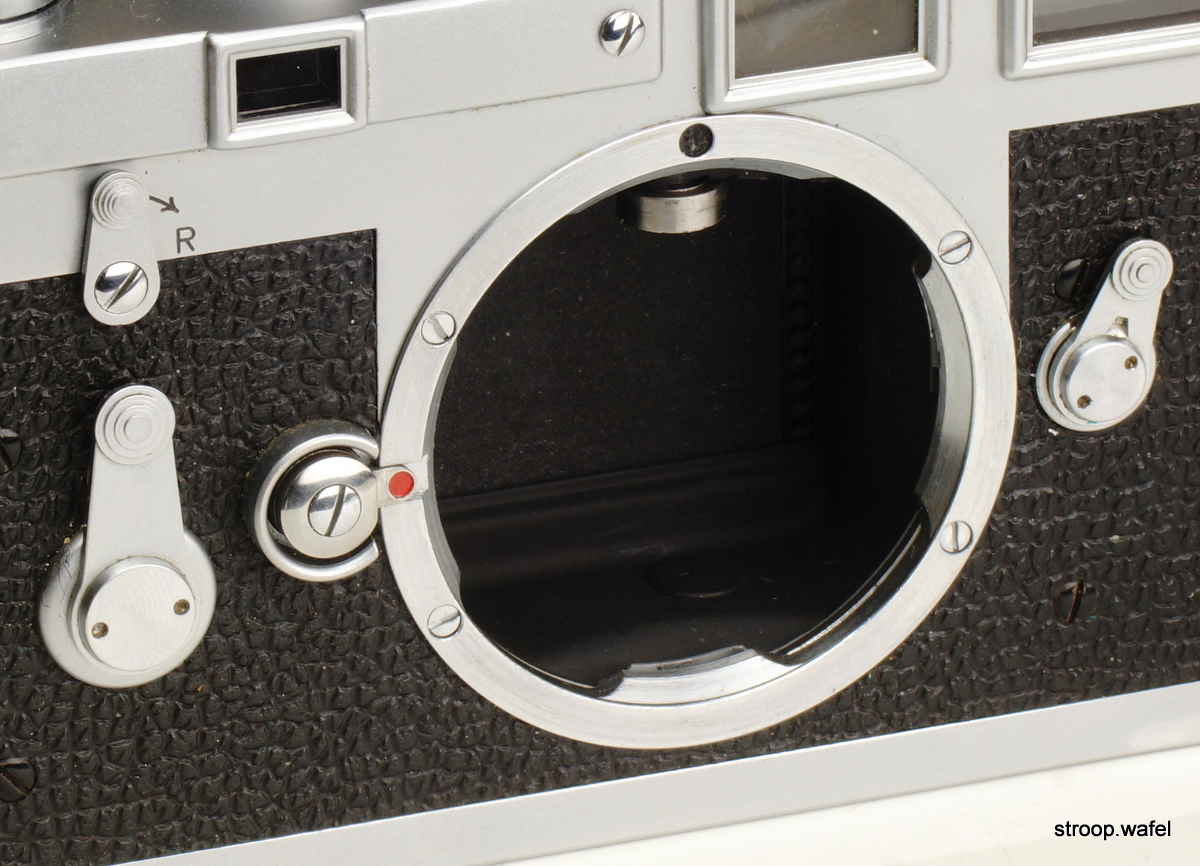
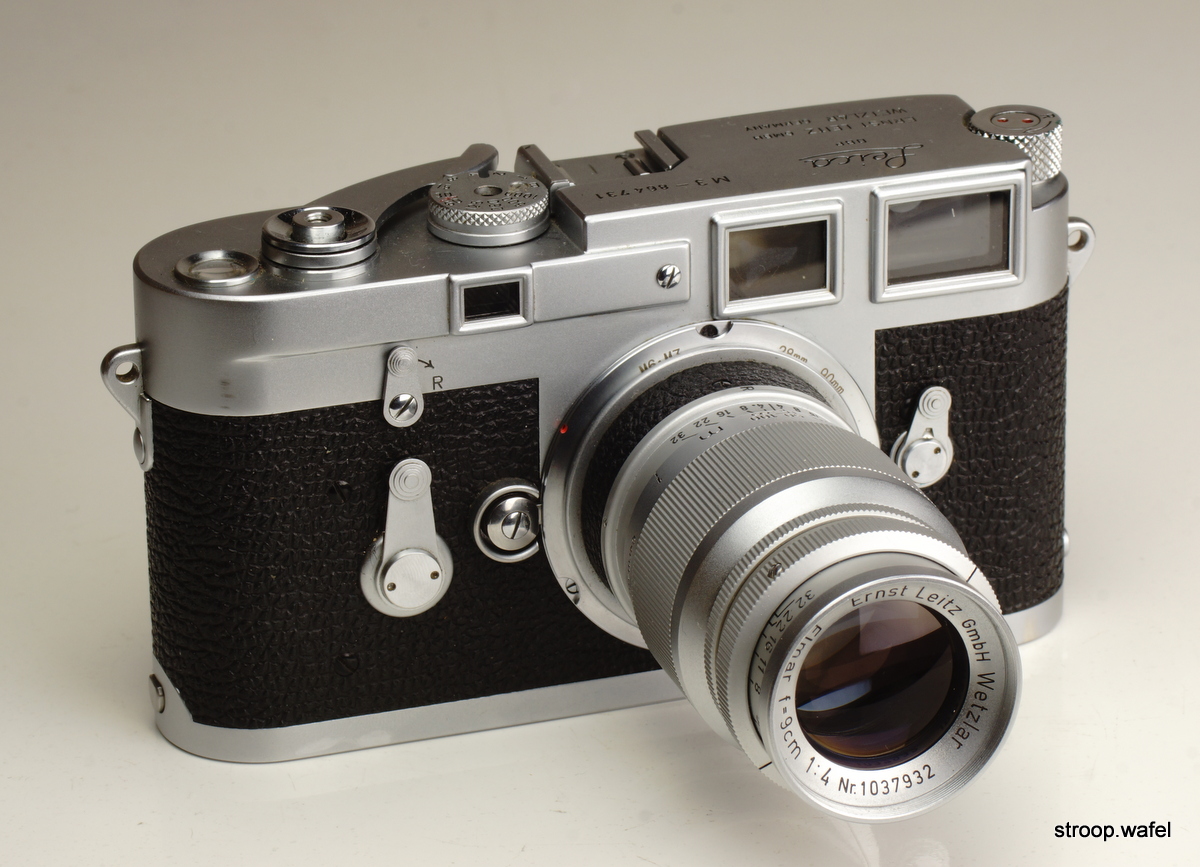
(left) Detail of the M3 bayonet lens mount. The lens was secured by the push button on the left. The lever on the left is the selftimer, the lever on the right determines which frames are visible in the viewfinder. In this position it shows the frame for the 90mm lens, when pushed to the left it shows the 135mm frame, in the middle it shows the 50mm frame only.
(right) Leica M3 with 90mm screwmount Elmar mounted. The M3 was fully backwards compatible with screwmount lenses, including rangefinder coupling, through an adapter ring. Different rings were available for different focal lengths, so that the proper frame lines would be projected. This system was continued with later Leica M models, which had more frame lines available than the M3.
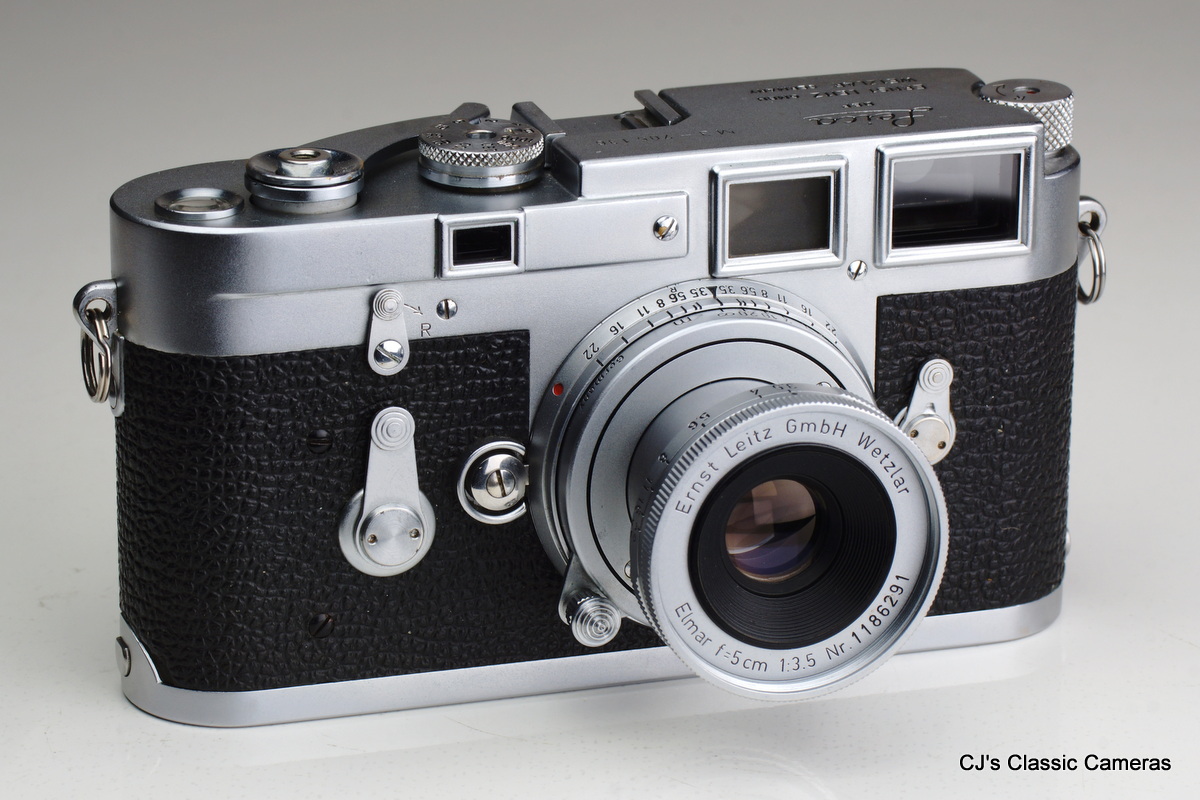
So here is another M3, this is a really early one from 1954 with a serial# in the 705,000 range, whilst the M3 production started with serial# 700,000 with a batch of 10,000 cameras, including this one. The lens is a fairly rare Elmar f/3.5, I didn't even realise this existed in M mount as I had only seen the f/2.8 version. However, the latter was only introduced in 1957, so it makes sense early M3s came with an f/3.5 Elmar. Early M3s did not have the frame line preview lever, whereas it is present on this example and must be a later update.
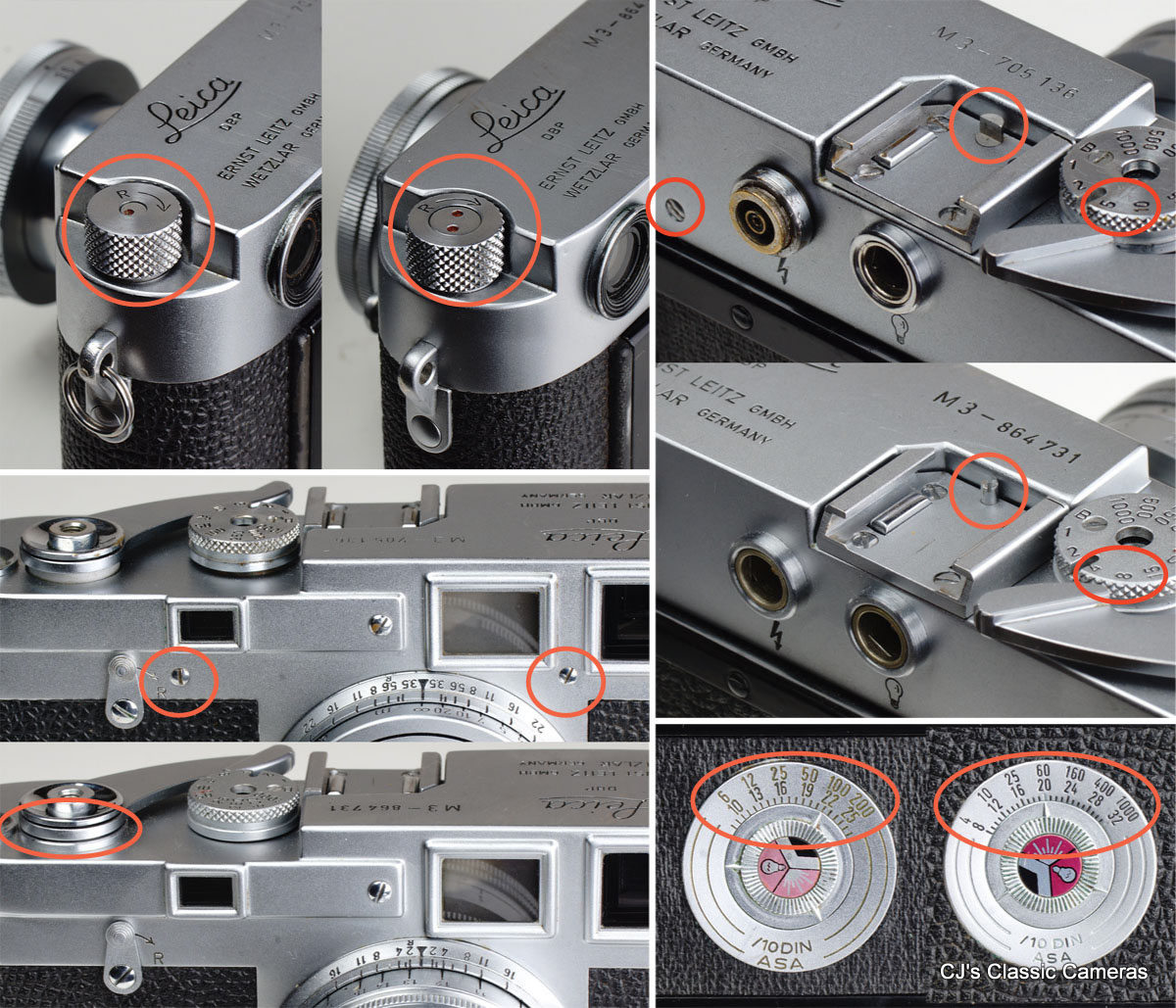
Upon comparing this M3 with the other one above there are quite a few small differences. some documented, some not. I've marked them in the above picture, with the earlier model to the left or at the top of the comparison pictures. The top plate screws disappeared on serial# 728,000, whereas the new shutter speed sequence was introduced on serial# 854,000. Note that the cover material on the back plate on the earlier example (right side bottom right photo) is non-original. Also note the backdoor is slightly smaller on the earlier model.
Nikon S2
The Nikon S2 was introduced in 1955, two years after the Leica M3 and therefore a little too late perhaps. Nevertheless, it was a great and attractive-looking camera that still has a great reputation. It had a 1:1 viewfinder that was nearly as good as the SBOOI Leitz accessory viewfinder, but not quite as good as the one on the Leica M3. It also had a lever wind as well as a lever rewind, much more convenient than the wind knobs on earlier models. Finally, it had a removable back for easy film loading.
What remained compared to earlier Nikons was the camera design itself, which was heavily based on the Zeiss Contax II with a bit of Leica thrown in. This particularly applied to the lens focus design, which was identical to the Contax, with the focussing helicoid built into the camera body. Hence, the standard lenses have no focussing mechanism. Wide and telelenses were mounted on a larger bayonet mount, again similar to the Contax range. The lenses are therefore in principle interchangeable, although there are reports that the focussing helicoid for the standard lens is slightly different, leading to incompatibility problems for fast lenses at close range. In contrast to the Contax the Nikon S2 had a horizontally travelling cloth shutter, similar to the Leicas, and therefore the dials on top of the camera are more Leica than Contax too.
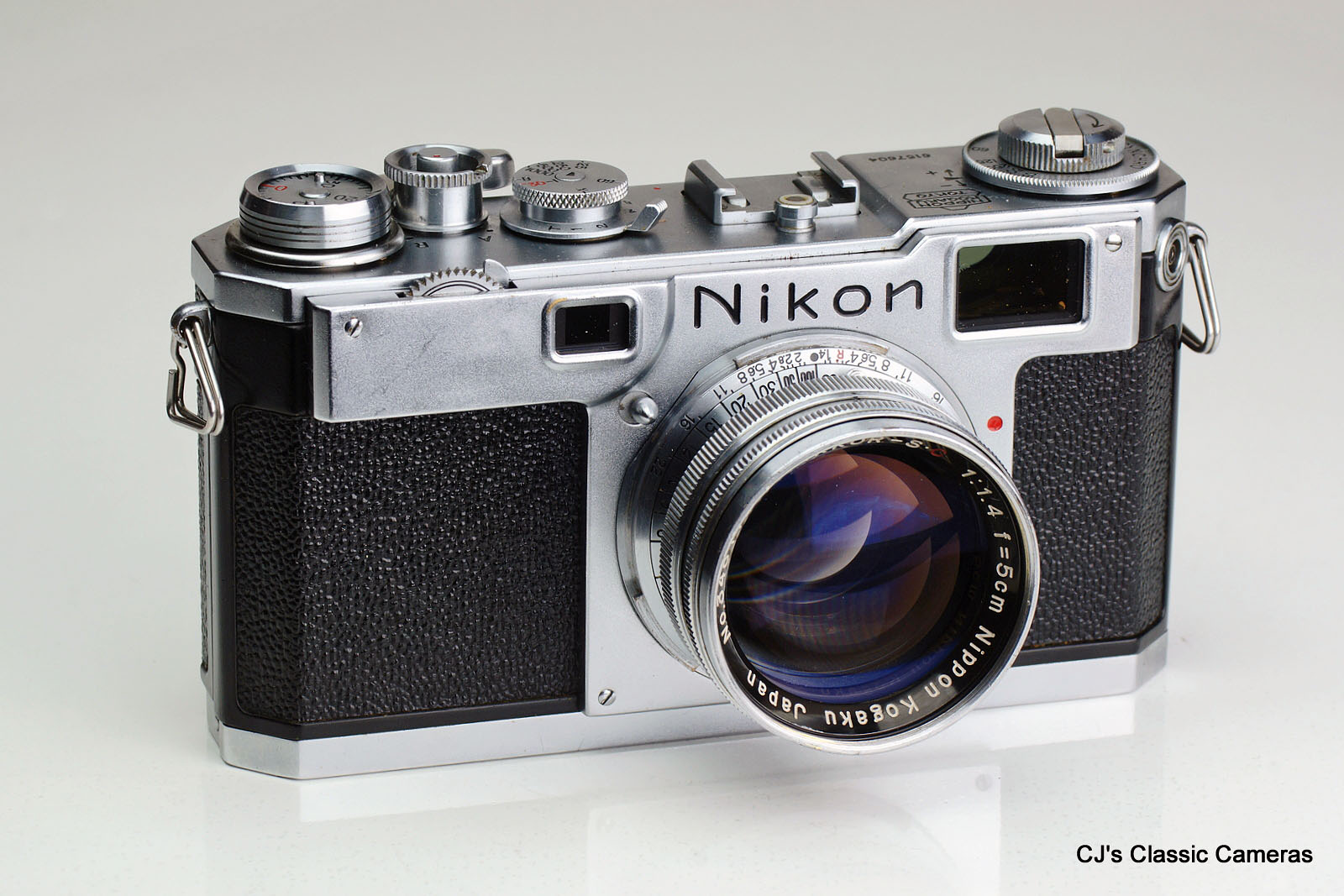
The very handsome Nikon S2, here with Nikkor-S.C 50mm f/1.4 lens. The lens was one of the few advantages Nikon had over Leica, who did not introduce a similarly fast lens until the 1960s.
Who thought Nikon gave up on rangefinders after the S2 would be mistaken, they continued to improve their design and introduced the Nikon SP only two years after the S2. At this moment Nikon had pretty much caught up with Leica and today an SP will fetch more than an M3 (as they are much harder to find). Note that the slightly later Nikon S3 and S4 were cheaper versions of the SP. After this Nikon introduced the F range SLR cameras and their success and ease of use essentially doomed any further development of rangefinder cameras.
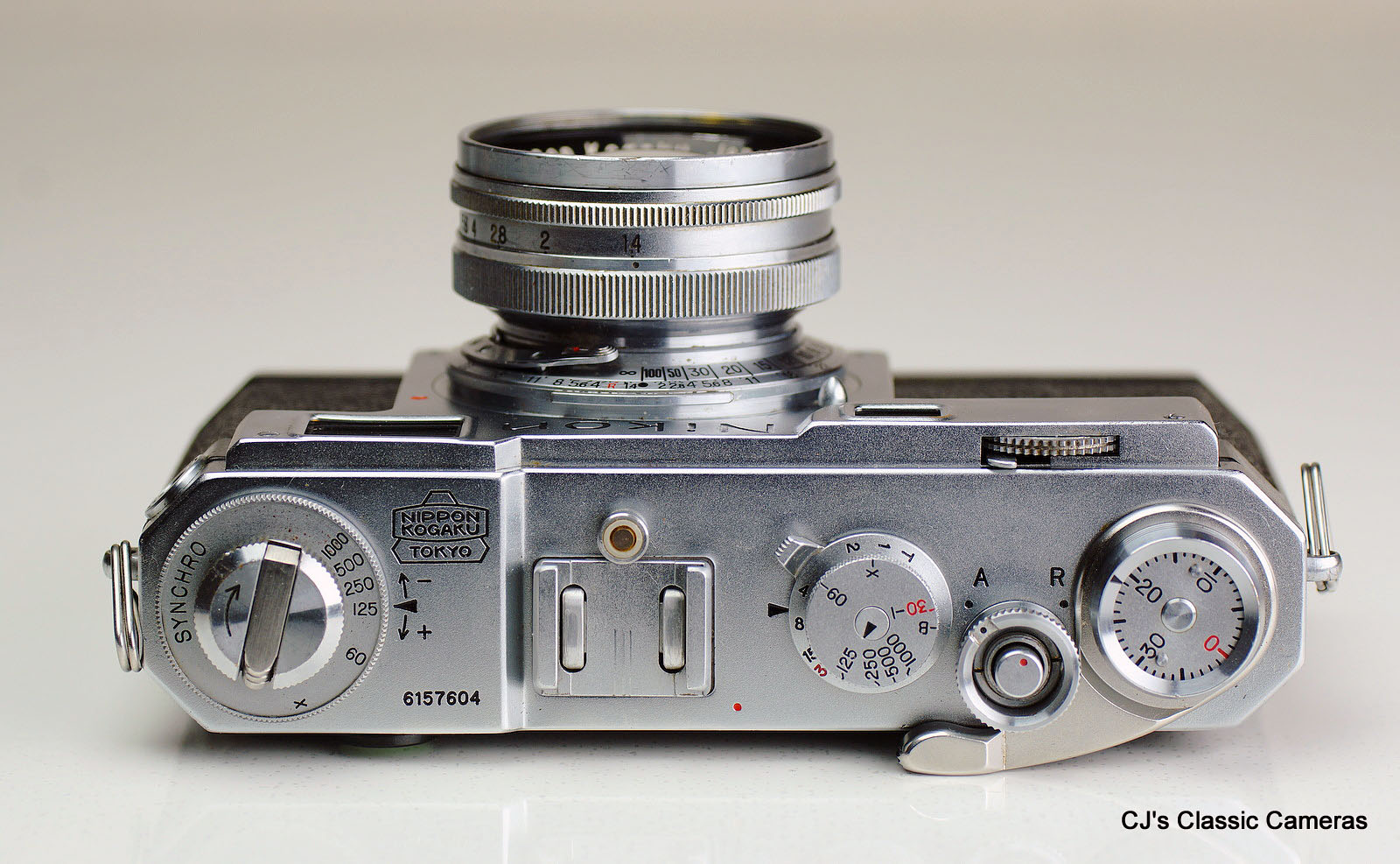
Top view of the Nikon S2. This example is an early version with chrome knobs, later production (the co-called 'black dial') had black knobs.
TLR stands for twin lens reflex, cameras that show the subject through a viewing lens which is focus-coupled to the taking lens and the image is projected by a mirror onto a viewing screen. TLRs are an iconic style of camera and my collection is slowly expanding. It started with a Photavit Photina, a Halina AI and a few Rolleicords, but now includes several Rolleiflexes and a randon collection of other models.
The Rolleicord series was a simpler and cheaper version of the iconic Rolleiflex range. I like the 'Cords' because they are affordable (compared to the Rolleiflex) and it is a pleasure to see the scene you are photographing on a 6x6 viewfinder (even though the image is mirrored!). Because one tends to hold them at chest or waist level the viewing perspective is also different then what you typically get from standard view and rangefinder cameras. Last but not least there is something very appealing about the square image format. If you want to try medium format photography, this is the type of camera I would recommend.
Rollei
Rolleicord I Model 1 Art Deco
The first Rolleicord model, the Rolleicord I Model 1 "Art Deco" introduced late 1933, was also one of the most visually stunning with an intricate Art Deco pattern covering the whole camera body, including the wind knobs. Apparently a version with regular leather covering was also produced although I have never been able to find one.
All Rolleicord had their own film advance system and a frame counter, so there was no need to use the red spy window to look at the frame indicators on the rollfilm backing paper. Like most later models, the Art Deco had the focus knob as well as wind knob on the right-hand side of the camera, but the frame counter was on the opposite side. The main drawback of this early model was probably the rather slow viewing lens, which made the focussing screen rather dim.
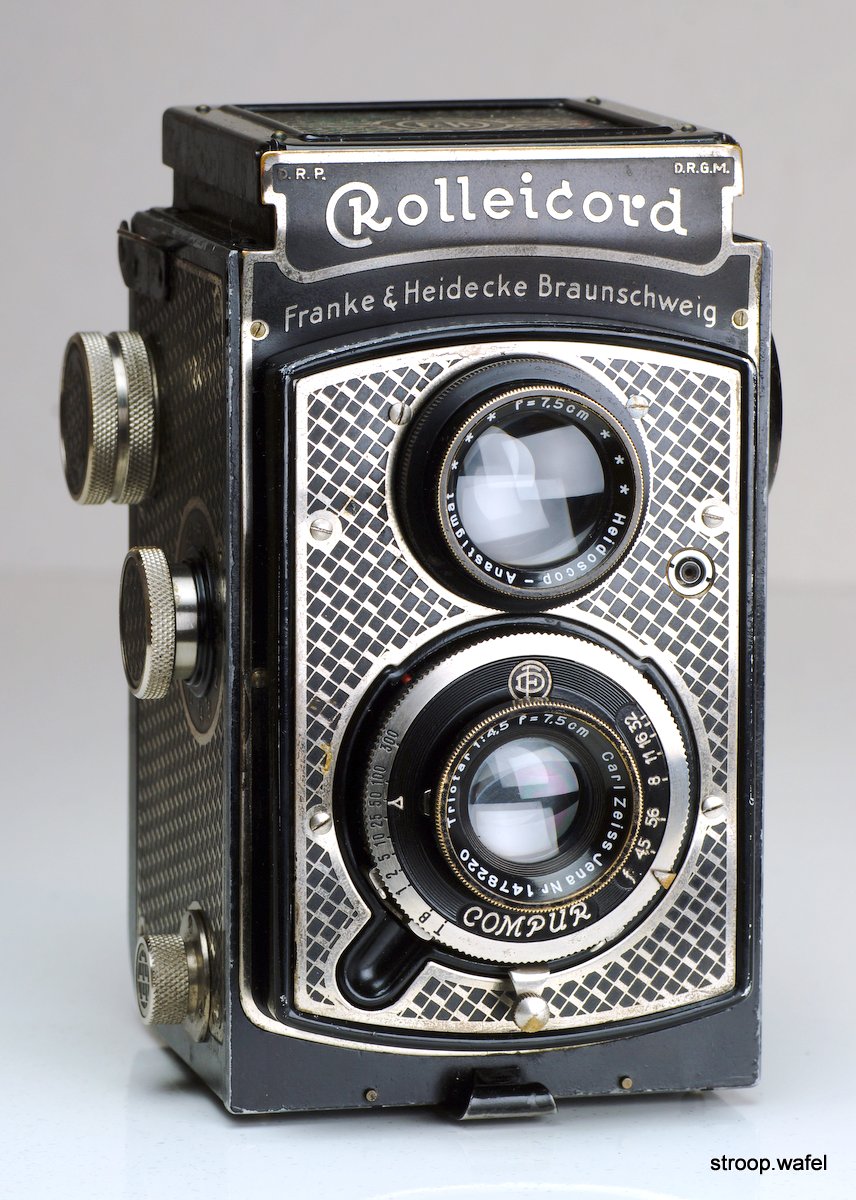 |
A 1934 Rolleicord I Art Deco with uncoated CZJ Triotar 75mm f/4.5 lens in a Compur shutter. The Art Deco covering is still in pretty good condition, despite being about 80 years old. This example has a flash sync socket next to the viewing lens, but that is clearly a later modification. |
There appears to be a wide-spread belief on the internet that the Art Deco model had body serial# between 05001 - 37508 while another version with normal leather covering had body # 00001 - 05000. However, a quick search revealed several Art Deco models with serial# <5000. These serial# matched with the lens serial #, which were all lower than 1,465,000, so less than 5,000 from the first Art Deco with lens serial # 1,460,000. Moreover, there appears to be a gap in the lens serial# of the Art Deco between 1,465,000 and 1,470,000. This gap of about 5,000 lenses could very well represent the leather-clad first Rolleicord model, but I have not been able to find a single one of these to prove this. Nevertheless, it would appear that the Art Deco was the first Rolleicord model to be build, not the leather version.
A few Art Deco with much higher lens serial# also exist (ca. 1,600,000 and 1,740,000). These were quite likely build after the Rolleicord I model 2 was introduced in December 1934, as these have lens serial# starting with 1,590,000. So it appears that a few small batches were produced after the main production of the Art Deco, or perhaps these represented old stock that were fitted with newer lenses.
Rolleicord IIe
Changes in the Rolleicord line-up were mostly incremental. From the Art Deco above to the last version of the Rolleicord II, the frame counter moved to the same side as the wind knob and the filter mount changed from a screw mount to a bayonet mount. The focussing screen received a mask for parallax correction. Also, faster taking and viewing lenses were mounted. The wind knob gained a wind lock, so one didn't even need to keep an eye on the counter while advancing the film. The last version, the IIe introduced in 1949, was the first to have coated lenses and had a flash sync socket as standard.
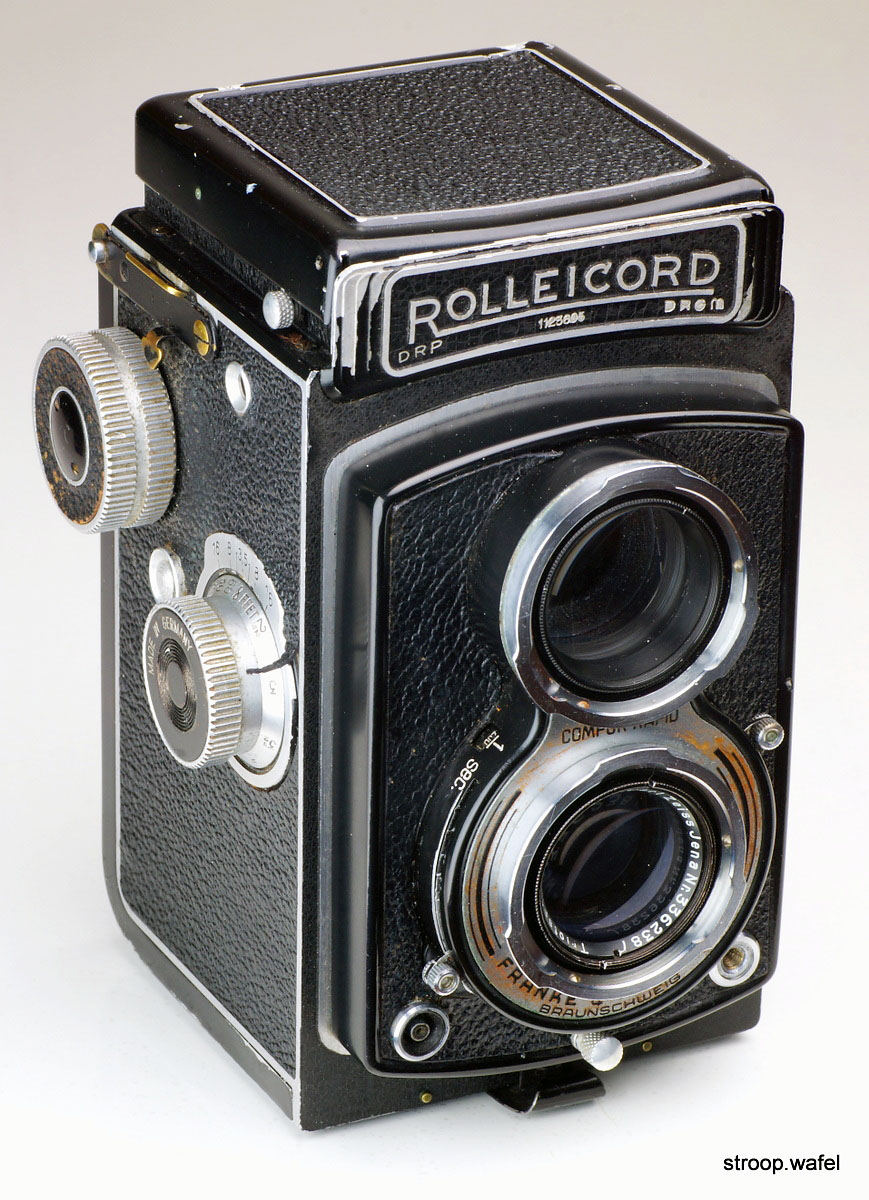 |
A 1950 Rolleicord IIe with coated CZJ Triotar 75mm f/3.5 lens in a Compur-Rapid shutter. Some paint loss and brassing but in excellent working condition after a good clean, some photo samples can be seen here. |
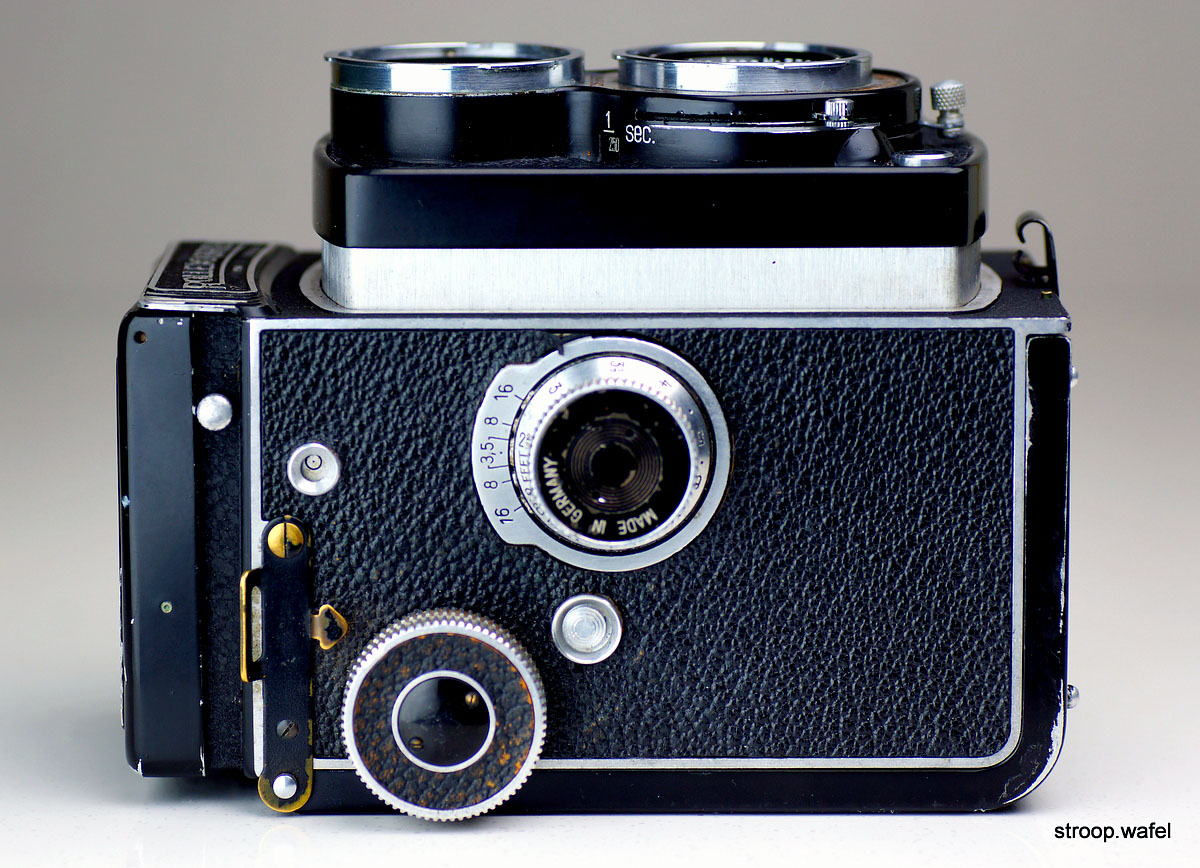
Side view of the Rolleicord with fully extended lens base for closest focus (2 2/3 feet). Viewing and taking lens moved in unison.
Rolleicord Va
The Rolleicord Va was introduced in 1957 and featured several improvements over the IIe above. It had an interchangeable frame counter which made it very easy to adapt for different frame formats such as 6x4 cm or 35mm film. The focussing screen featured parallax control and in addition it had a frame finder. It featured an improved four-element Xenar taking lens. The shutter had LV markings and aperture and speed scales were coupled. The shutter also had a self timer. A little confusing is that the focussing knob was moved to the opposite side of the camera body. At the back it featured a somewhat hard to interpret exposure guide.
The later Vb was the last Rolleicord to be built and featured an interchangeable focussing screen.
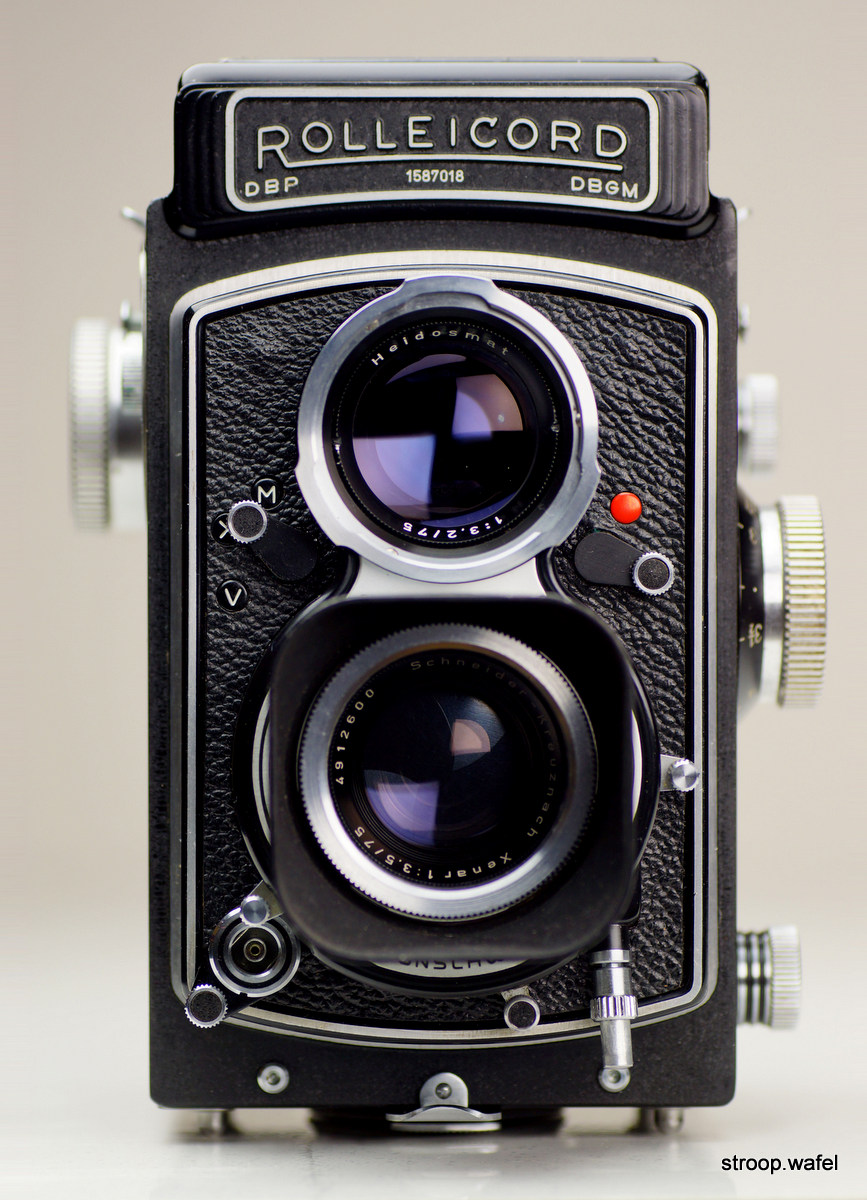 |
A 1957 Rolleicord Va with coated Xenar 75mm f/3.5 lens in a Synchro-Compur shutter. |
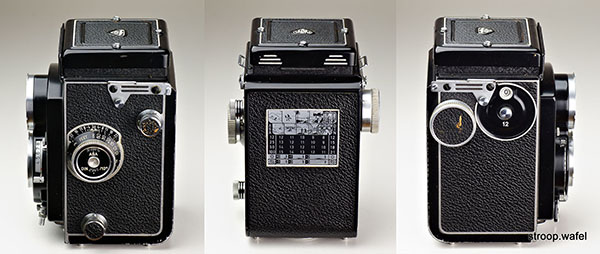
Rolleicord Va from different viewpoints. Note that the focus knob is on the left. The frame counter was replaced with an interchangeable version that could be swapped when using masks for different film frame formats (on the same 120 film).
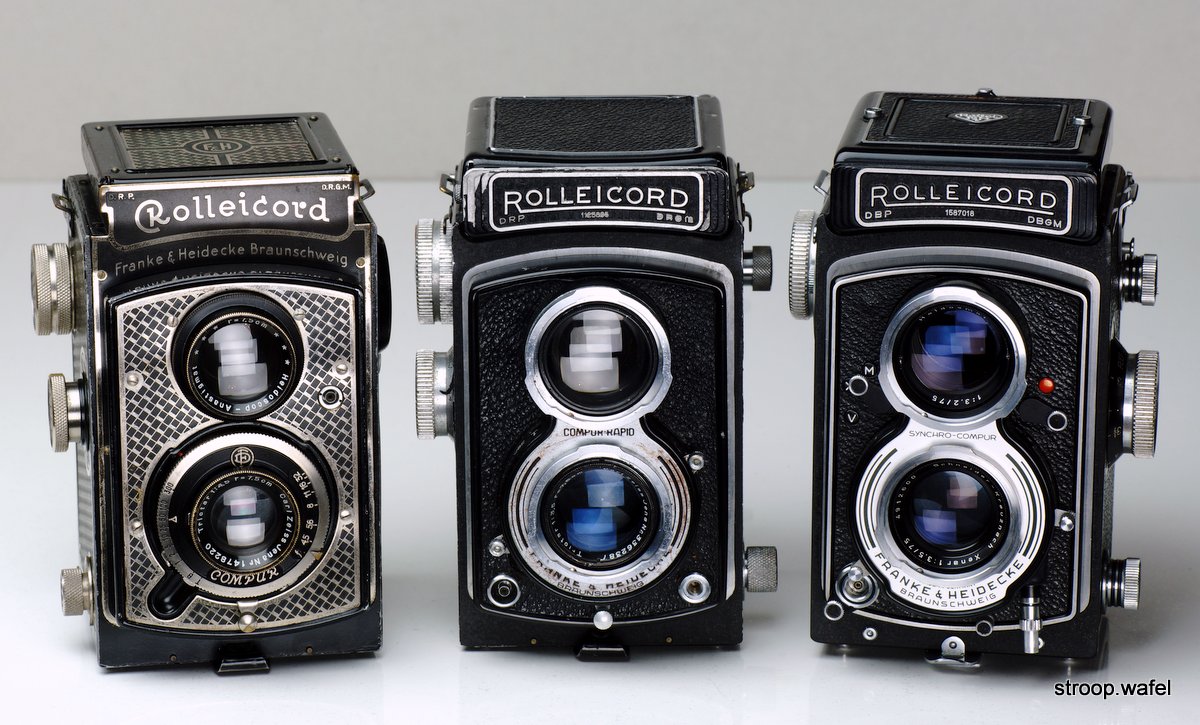
Rolleicord I Art Deco, IIe and Va next to each other. Although they gained more bells and whistles, the basic concept of the later models was very much the same as that of the very first model.
Rolleiflex Original
The Rolleiflex was first introduced in 1929 (before the Rolleicord) and it caused quite a stir. At the time, 35mm cameras were still in their infancy and so were rangefinders. The most common cameras were folding and box cameras, neither of which had great viewfinders, so framing and focussing were not that accurate. Of course there were plate cameras but these were large and cumbersome. The Rolleiflex allowed accurate focussing and framing in a camera which was portable and convenient to use. Hence, it was an immediate success.
The first Rolleiflex model is nowadays known as the 'Original'. Although Rolleiflex are well-known for their lever-wind film transport, the first few versions still had a wind knob. In addition, one had to use a red spy window at the back during film transport, whereas only later versions had automatic film transport stops and frame counters. One of my favourite features of these early Rolleiflex was a little bubble spirit level which was molded onto the focusing screen, a lovely piece of glassmaking which shows the attention to detail which the Rollei cameras became known for, one of the reasons why Rolleiflex have been in production nearly continuously until very recently.
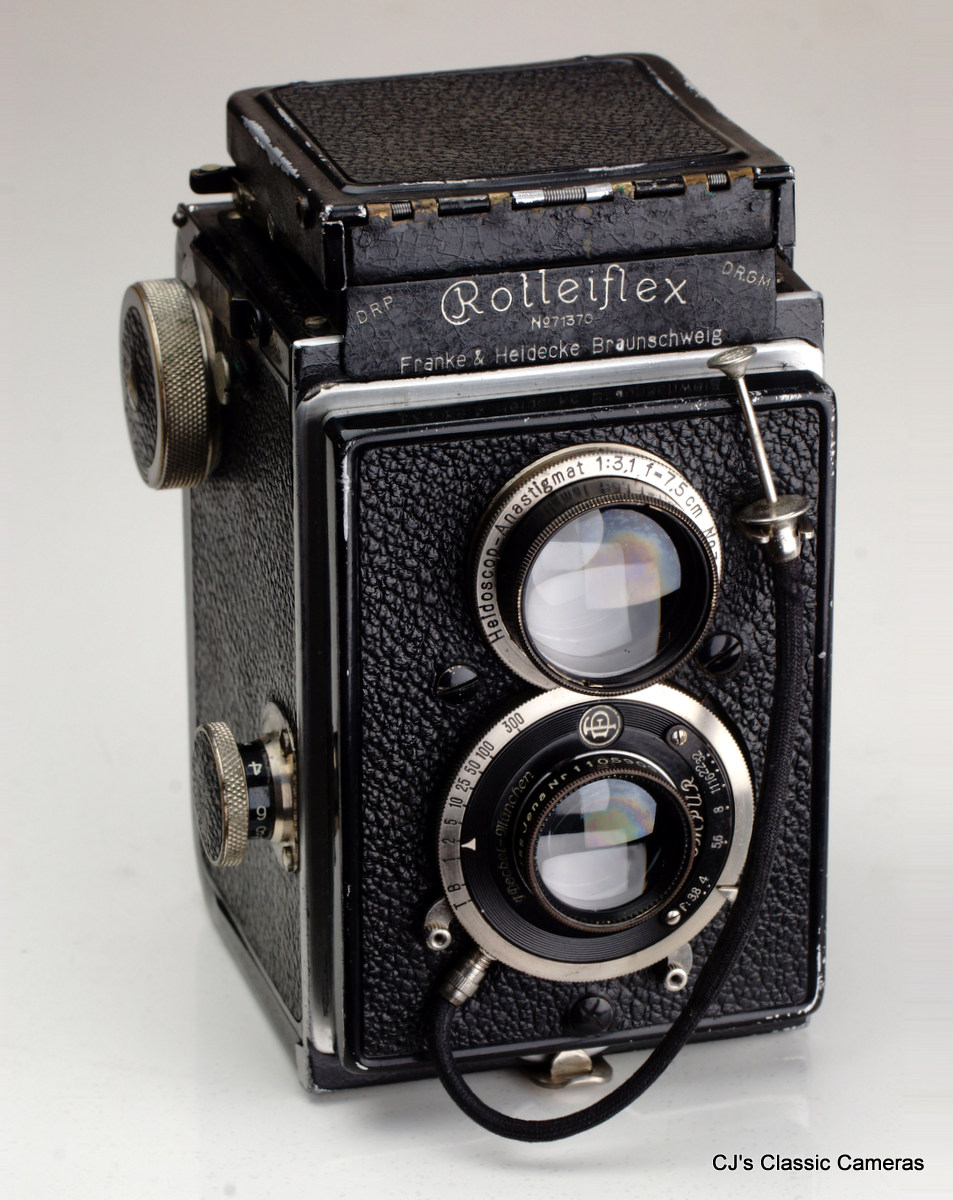
|
Late version (model K1 614 for purists, made in 1930) of the original Rolleiflex, distinguishable amongst others by its hinged back and wind knob with distance indicators. It has a Carl Zeiss Jena Tessar 75mm f/3.8 lens in Compur shutter. Note the little cable release holder next to the viewing lens and the cable release itself, making it easier to fire the shutter whilst holding the camera steady. This example has been updated to use 620 film instead of 117 film it was originally designed to use. 117 film was one of many similar rollfilms produced by Kodak, it was nearly the same size as 620 film but with a thick core like 120 film.
|
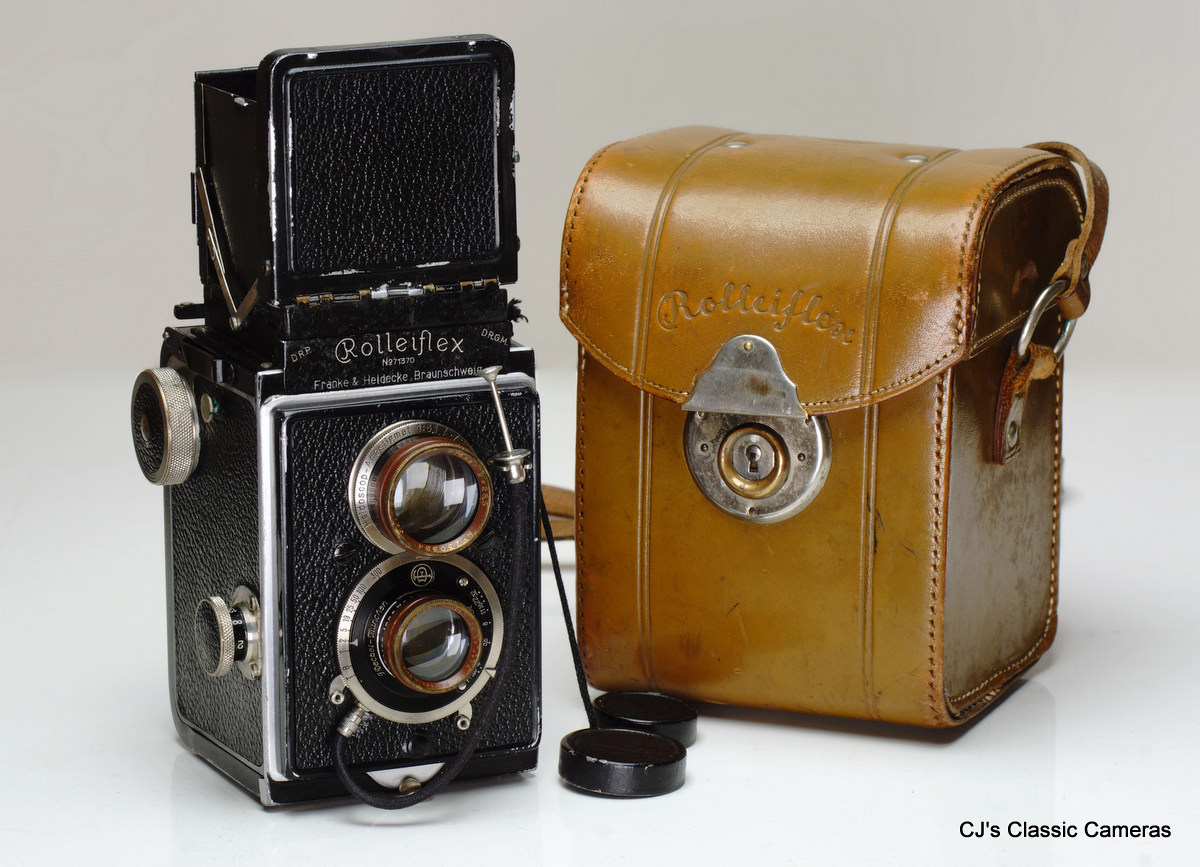
The Rolleiflex Original with its original case. The camera is shown with its accessory Proxar lenses, used for close-up photography. The case had convenient holders for these lenses build in its hood, but nevertheless these lenses have often been lost. A yellow filter was also provided, this was the age of black and white photography after all.
Rolleiflex Standard
The first Rolleiflex model with lever-wind film transport was introduced in 1932 and started to get the familiar Rolleiflex look. It received a film transport lever instead of a wind knob, which improved the speed with which the camera could be used, and therefore the focus knob had to be moved to the opposite side of the camera body. Furthermore, like all later Rolleiflex, the lens board had round top and bottom edges instead of the rectangular look of the Original. A frame finder was integrated in the viewfinder hood. The shutter still had to be cocked by hand, however.
A feature that confused me at first is a red window at the bottom of the camera that says 6x9. Could this be used as a 6x9 camera? But of course not, how would that be possible with a 6x6 frame? It dawned on me that at the time some roll films might not have had 6x6 markings yet, only 6x9 ones. Either window was for finding the first frame only, as further film advance was automatic.
This model was in 1939 replaced with the New Standard. The changes were largely cosmetic but defined the look of all the Rolleiflex models following, including the ones below.
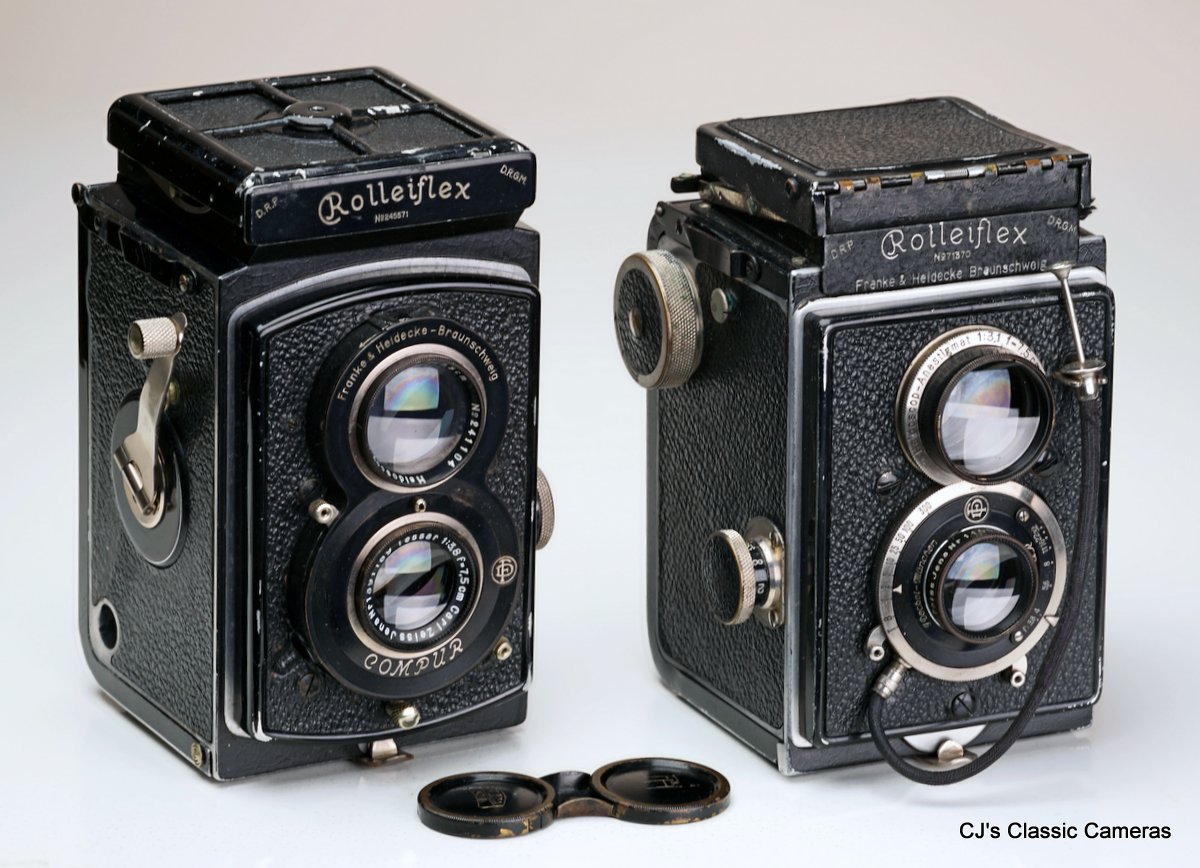
Comparison of the Rolleiflex Standard (left) and the Rolleiflex Original (right). Both examples used the same Tessar f/3.8 lens and Compur shutter.
Rolleiflex 2.8E
I finally succumbed and got a Rolleiflex, just to see how different it is from the Rolleicords I have and if the extra expense is worth it. I'd say probably not, but it is a fantastic camera and I am tempted to keep it (update: or the 3.5F below). After being first introduced in the late 1920s (see 'Rolleiflex Original' above), a number of different Rolleiflex variants were produced, including the 'T' and the 'Automat', but the main production were the 2.8 and 3.5 A-F ranges. The number stood for the taking lens aperture, so the 2.8A would have a Zeiss Tessar f/2.8 lens, whereas the 3.5A would have a f/3.5 lens. They also had slightly different focal lenghts, 80 mm vs. 75mm.
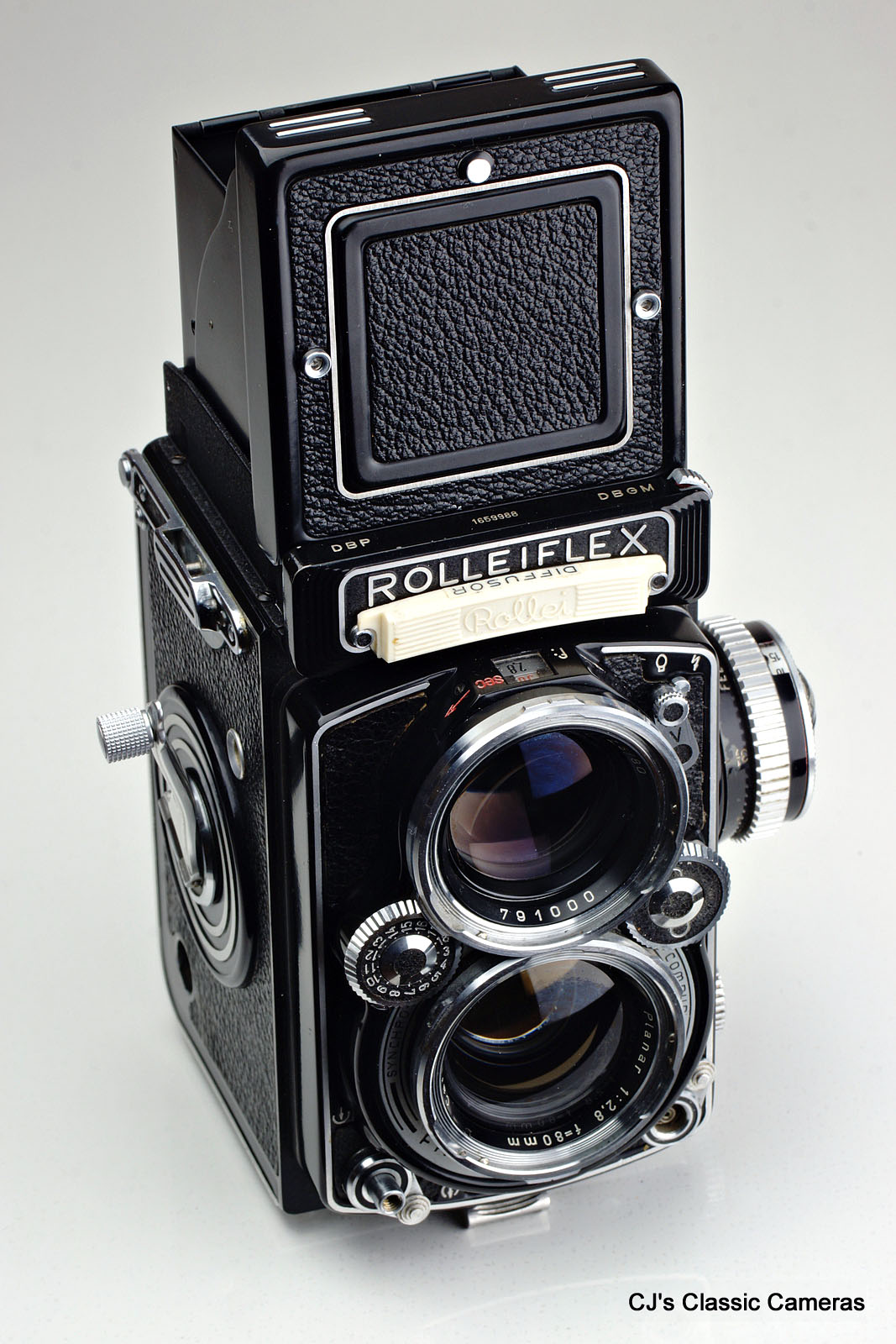
|
The Rolleiflex 2.8E was introduced in late 1956, so is from about the same time as the Rolleicord Va above. So what are the differences? Well, of course there is the taking lens. The f/2.8 Planar is a five-element lens of great reputation, although of course the four-element Schneider Xenar on the Rolleicord is no slouch. The Rolleiflex was also available with a Schneider lens, the Xenotar, which was similar to the Planar. Coincidentally, the f/3.5 Planar was also a five-element lens, but if the drawing in the instruction manuals are accurate, it had a different design than the f/2.8 version. Both were later replaced with six-element versions, although the exact difference in optical design is debated.
Then there is the light meter. The 2.8E was the first model with an (optional) uncoupled light meter, with the light meter cell mounted below the Rolleiflex nameplate at the front of the camera, whereas the light meter was integrated into the distance knob. It would indicate a light value, which could then be transferred to the exposure system.
|
Of course, another difference is the wind lever, which makes winding the film a lot faster than using the wind knob on the Rolleicord. Another useful feature on the Rolleiflex is the rangefinder prism integrated in the centre of the focussing screen, which makes focussing more accurate, and easier in dim light. Furthermore, the viewfinder has an extra mirror which can be pushed down, which allows focussing and viewing at eye level instead of at waist level.
All in all the Rolleiflex definitely has many advantages over the Rolleicord. If it is worth the 4-8x price depends of course on what you want of the camera. The 3.5 models are somewhere in-between in price, but one could argue that in that case the differences are mostly in camera handling and not so much optical. The good thing is, there is never a bad choice!
A 1959 Rolleiflex 2.8E with Carl Zeiss Planar 80mm f/2.8 taking lens in Synchro-Compur shutter and a Heidosmat taking lens of identical speed and focal length, from three different angles. This is the version with light meter. The 2.8E was the first model with a 35mm frame counter (top right behind the focus knob) for use with a 35mm adapter, which was dropped again on later models.
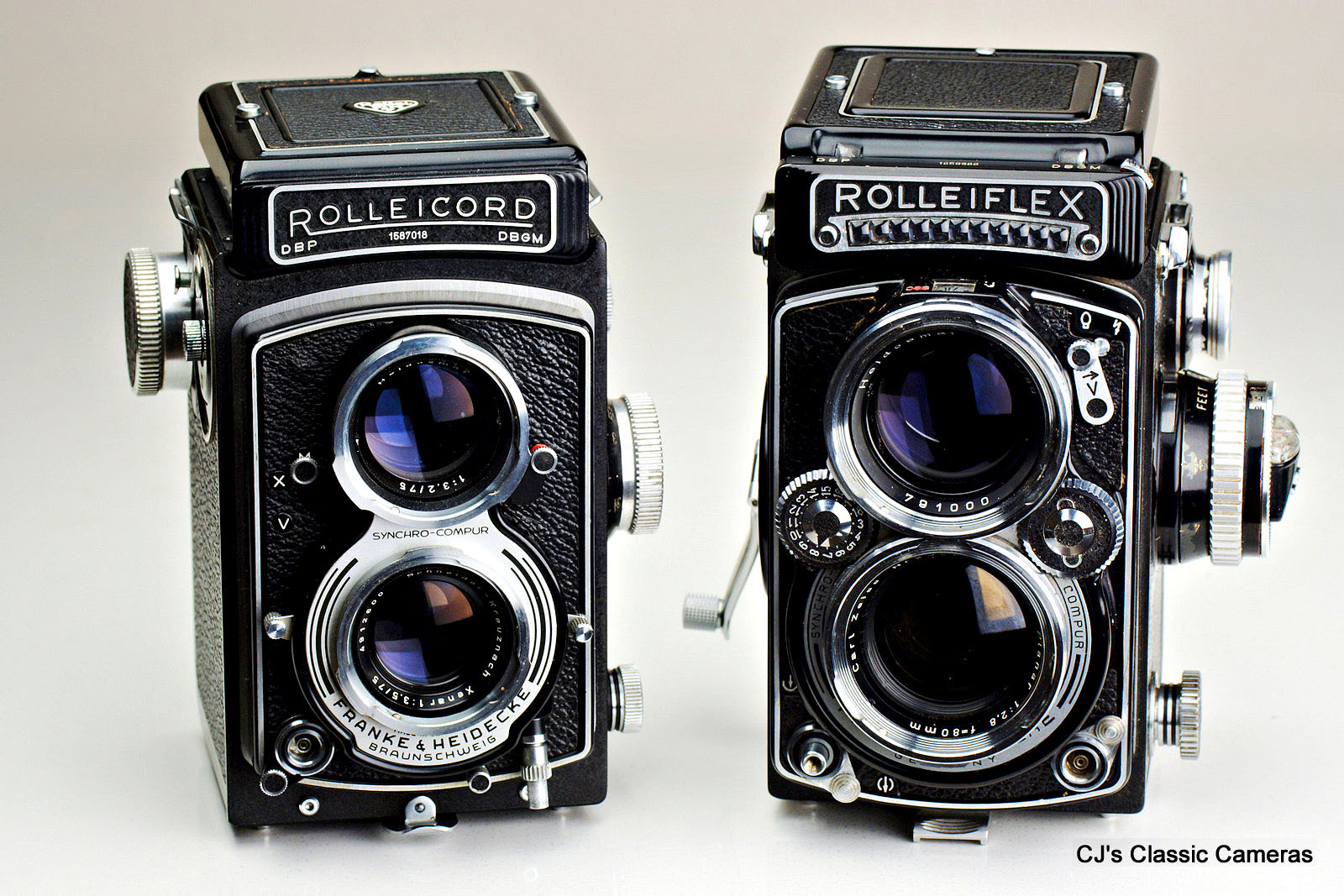
Rolleicord Va and Rolleiflex 2.8E next to each other.
Rolleiflex 3.5F
Much what I said above about the Rolleiflex 2.8E applies to the 3.5F, but it had several important improvements. First of all, it came with a (still optional) coupled lightmeter, so one would adjust the exposure by changing aperture or shutter speed until the lightmeter indicator would match the needle. Second, it had an interchangeable viewing hood, which could be taken off very easily by pressing two push buttons, and allowed a eye-level prism to be mounted. It must be noted that this lead to a size difference of the frosted screen, so one cannot swap the one in a 3.5F (or 2.8F) with previous models or vice versa.
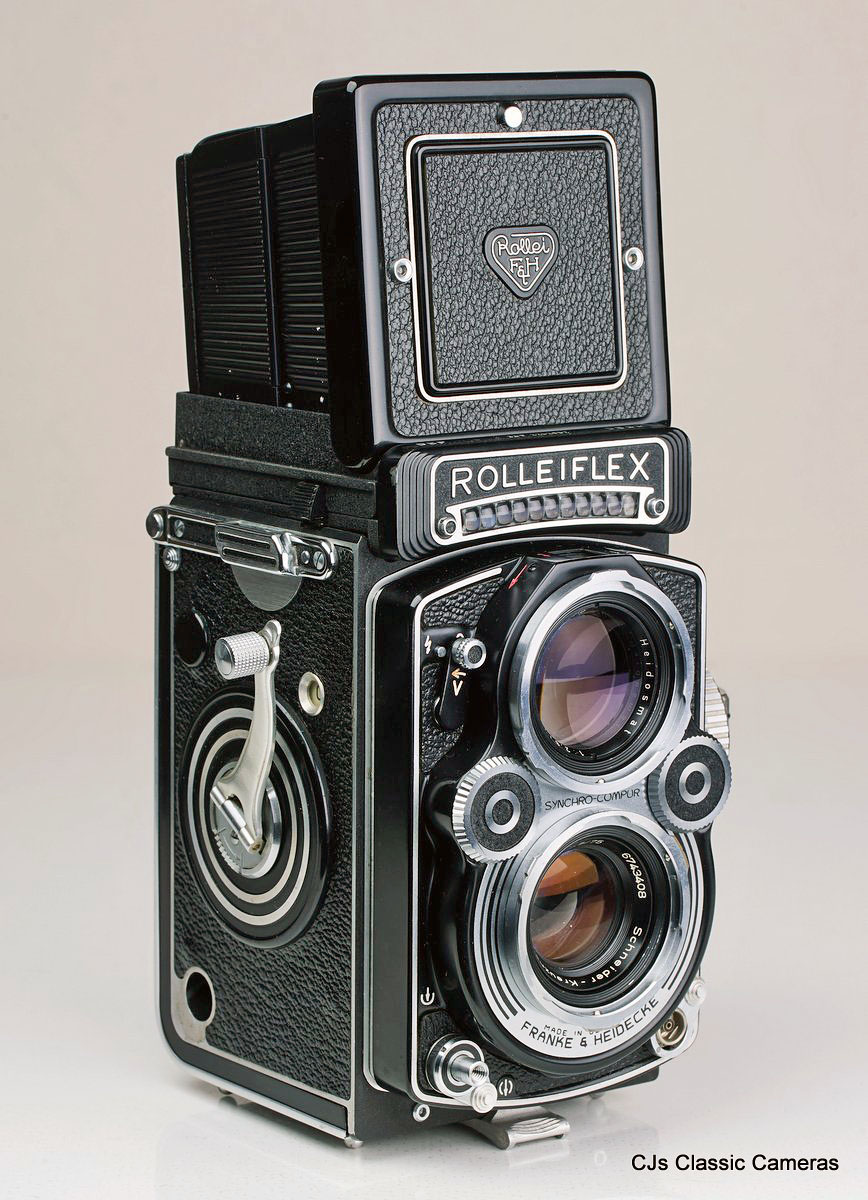
|
A 1961 Rolleiflex 3.5F Model 3 with Schneider Xenotar 75mm f/3.5 taking lens in Synchro-Compur shutter. The question which was the best lens, the Xenotar or Planar, has led to heated discussions on the internet without a clear winner. I'd say the difference was probably small and nowadays depends more on how well the lens and camera have been treated and serviced than on any perceived original difference in quality.
|
The 3.5F and the 2.8F where the final 'classic' models in the Rolleiflex range, so what happened next? Well, first of all these models stayed in production till 1979. After that the company went through a financial rough patch, but started building TLRs again in 1987 with the introduction of the 2.8GX, which featured TTL (through the lens) metering. Early this century it introduced new wide angle and telelens models, the 4/0 FW and FT, respectively. The company changed owners and name a few times, but still exists as Rollei and is still in German hands, although unrelated to the original Franke & Heidecke company. However, it appears any TLR production seized following the last take-over in 2014.
|
A better view of the controls of the Rolleiflex 3.5F, showing the coupled lightmeter unit integrated into the focus knob as well as the aperture and shutter speed read-outs on top of the viewing lens. Note that the viewing lens had a f/2.8 aperture, so there was no difference in viewing screen brightness between the 3.5 and 2.8 models.
|
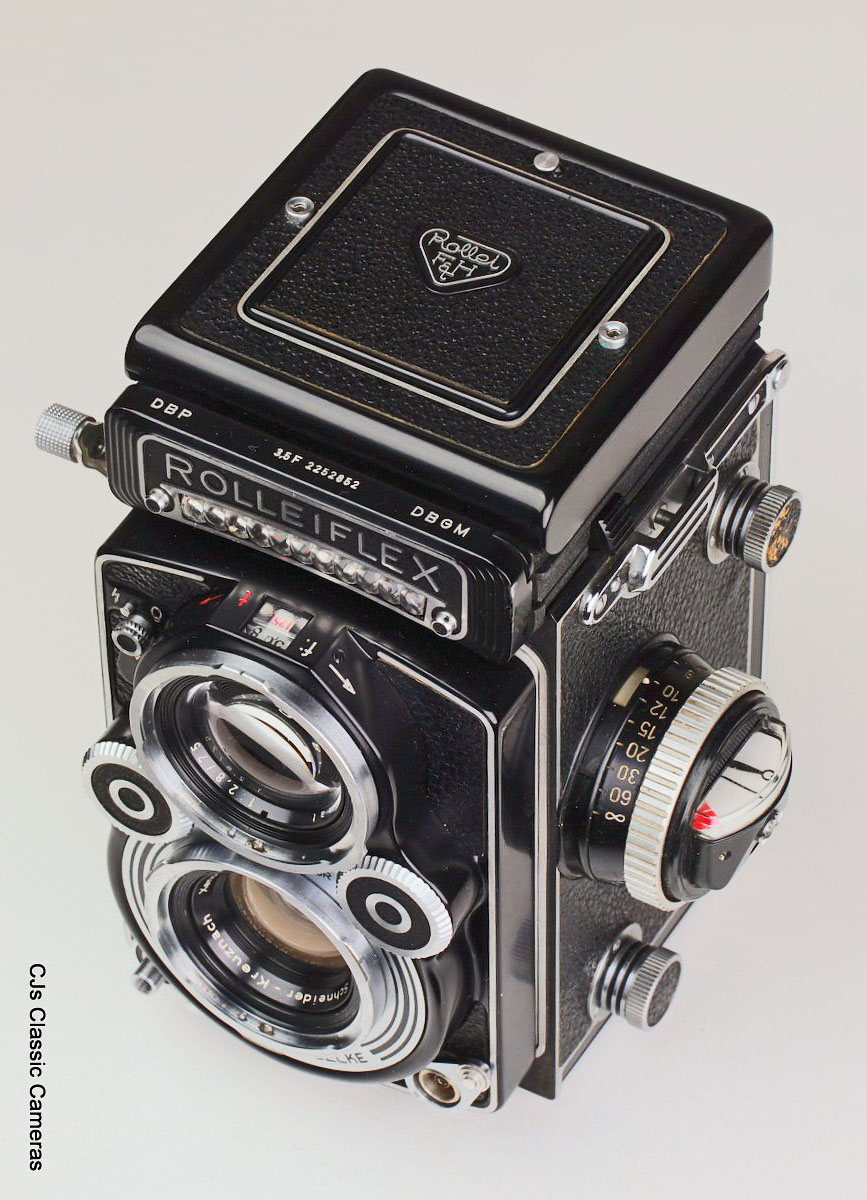
|
Echoflex Semi-Automat
The popularity of the Rolleis resulted of course in a great variety of copies being made. One of those was the Echoflex, which was a Japanese Rolleicord copy from ca. 1955, which is around the time the Rolleicord IV was in production. As is the case for many Japanese cameras (and lenses), it is not always easy to find out which company made what, as many cameras were rebranded under various names or build to order by a different factory than the company that sold it. The Echoflex is no different. There were two different models, most likely made by different companies, the first one a manual model, the second a semi-automatic model, i.e., with an automatic wind stop (no red window) but not with a self-cocking shutter. The second model is shown here and was purportedly made by Lustre, as the accessory shoe on some examples (including mine) show the letters LKK, from Lustre Koki Kogaku. The manual indicates 'Transvision Trading Co. Ltd., Tokyo Japan' as the sole distributor for the Echoflex.
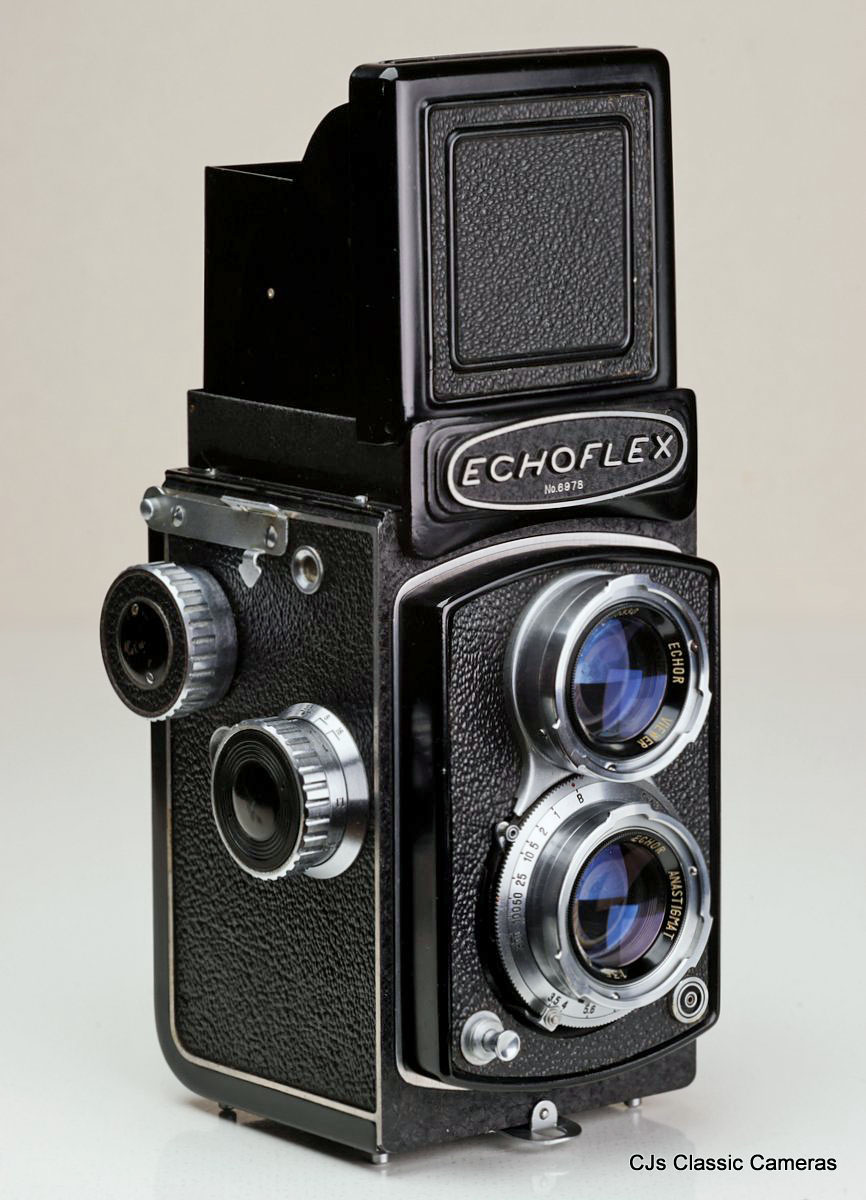 |
A Lustre Echoflex Semi-Automat with coated 75mm f/3.5 Echor Anastigmat lens in Synchro-Super shutter, which is similar to the Prontor-SV. Comparing it to the Rolleicord IIe above you won't spot many differences, except for the shutter release and aperture and shutter speed controls. |
Lustre also made the Lustreflex, some versions of which did look virtually identical to the Echoflex, but were equipped with Tri-Lausar lenses and Chy-FB shutters instead. Then there was the identical Chelicoflex, which also has an Echor lens and Synchro-Super shutter, and even matching serial number ranges. Then there was the Beautycord, some version of which are identical to the Echoflex and had Tri-Lausar lenses and Synchro-Super shutters. The confusing thing is that the Beautycord was made by Taiyodo Koki, not Lustre, and they made a whole series of other copies, like the Wardflex, Gen-Flex, Photoflex and Fodorflex.
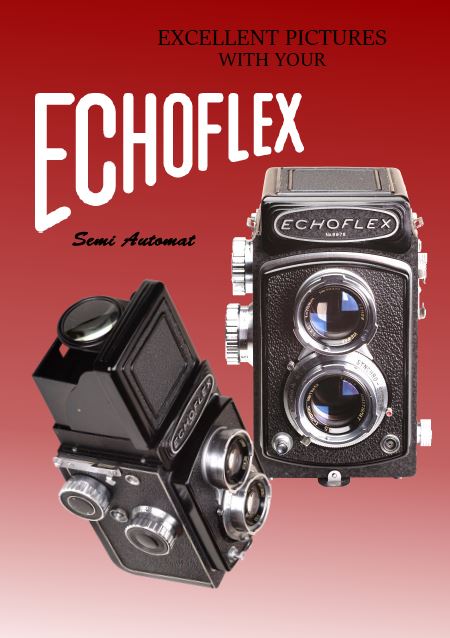 |
It did not stop there. Next I found a Toyocaflex, made by Tougodo. Again, nearly identical to the Echoflex, although now I managed to find a few small differences: the strap lugs, the position of the flash sync, the film speed dial integrated in the wind knob. Other than that, all controls look the same and work the same. Again, many variants including the Hacoflex, Crownflex, and so on. By that time I gave up! There must be at least 20-30 nearly identical cameras made by at least three different companies within a span of five years or so.
I could only find a poor resolution scan of the manual online, so I made an exact copy of it (including typos!) using my own photos. You can be find it here. |
Richter Reflecta
The Richter Reflecta was a TLR camera initially developed by Merkel (from the Metharette, see elsewhere on this page), which company was taken over by the Richter family in the early 1930s. It was a simple camera, but remember, these were the early days of TLRs and the Reflecta had several interesting features, including a helical focus mount on which both the taking and viewing lens were fixed, and which had a focus lever at the bottom of the shutter. This design was later adapted in modified form by Minolta and Flexaret TLRs. The film-loading assembly had to be taken out of the back of the camera for film loading, unusual for a TLR camera but similar to many box cameras at the time.
The Reflecta later changed its name to Reflekta (and the company to Tharandt). Around 1950 the company was taken over by Welta, who updated the camera to the Reflekta II,
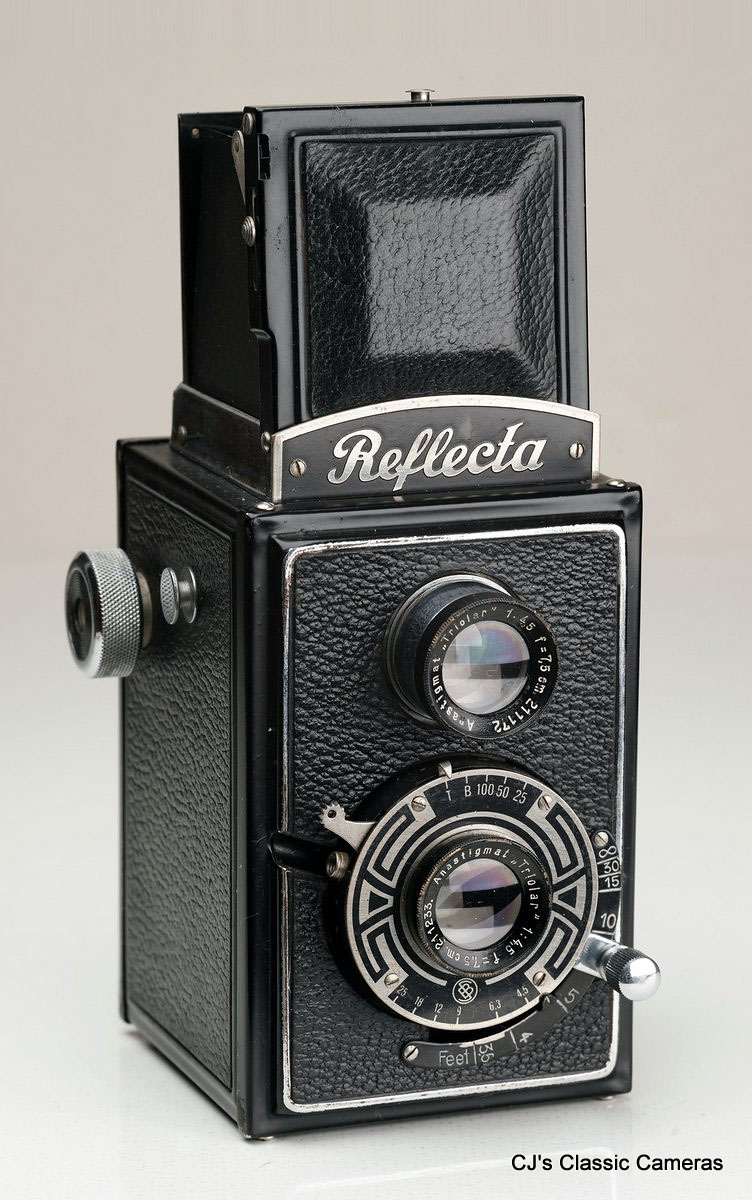
|
still without much actual change other than a double-exposure prevention, and eventually replaced it in 1955 with the Weltaflex, which did away with the focus lever. It longevity was a clear testament to the quality of its original design.
A Richter Reflecta with Anastigmat "Triolar" 75mm f/4.5 lens in unspecified Art Deco style shutter. I tried to figure out what the shutter was and which company made it, but without much luck. There is a small logo that looks like the letters SB (or BS) . The shutter looks a lot like the Stelo shutters found on the other Reflecta examples, but those have the GW logo from the Gebr Werner (incidentally based in Tharandt, just like the Richter company). I have seen the same SB logo on a different, but again unspecified shutter on a Wirgin-branded Reflecta copy. Now the trail has gone cold. If you know more, please help!
|
Montanus Rocca Super Reflex
Montanus is probably not a company you will have heard of. It was a plastics manufacturer based in Solingen, former West Germany, which also produced a range of cameras in the 1950s. Their first TLR was the rather unremarkable 1952 Plascaflex, a camera with bakelite body and no outstanding features, not unlike the Argoflex above in fact. Therefore, it is a bit of a surprise that not long after, Montanus came out with the Rocca Automatic and Super Reflex, rather modern looking TLRs with several impressive features better known from the Rolleiflex line, including a film advance crank for automatic film transport, automatic shutter cocking, removable viewing hood and fast f/2.8 lenses. Admittedly, it did not have the build quality of the Rolleiflex and the taking lens was a triplet, not the magnificent Planar or Xenotar, but nevertheless, this was essentially a poor man's Rollei. I haven't found much price information, but in the USA it was for sale in 1956 for $100 (rather curiously, rebranded as Edixa 6x6 and sold by Wirgin), about a quarter of what a Rolleiflex would have cost, and still cheaper than a Rolleicord. It appears though, that these cameras did not sell that well, probably not helped by the manufacturer having little reputation in the camera market, and these TLRs are rare to find these days.
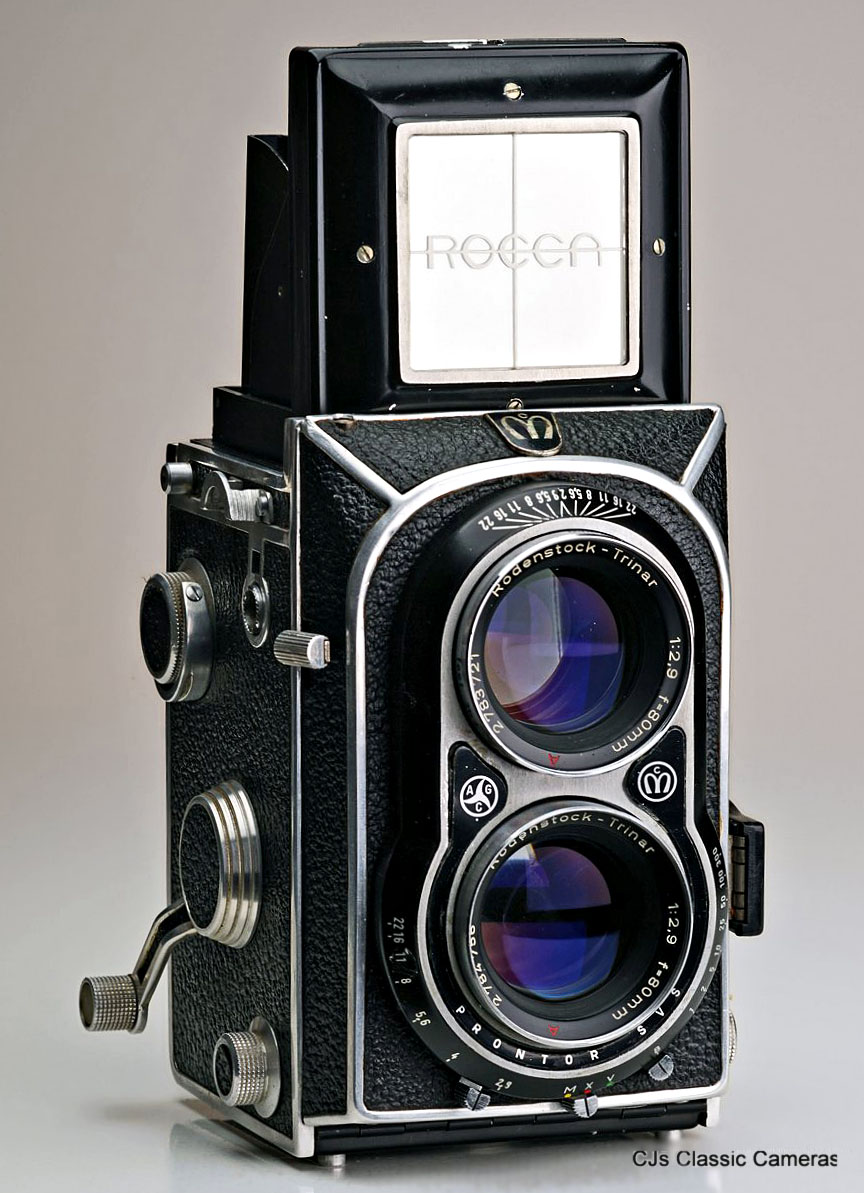 |
A Montanus Rocca Super Reflex with two Rodenstock Trinar 80mm f/2.8 lenses. Focussing was done with a slider with a fold-up handle (just visible to the right of the taking lens), which allowed for a fast focus action. |
Lipca Rollop 2.8 Automatic
After coming into possession of the above Montanus Rocca Super Reflex with f/2.8 lenses I started wondering how many other TLRs had similarly fast lenses, as before I had only been aware of the Rolleiflex 2.8 and Mamiya C range. Lo and behold, I came across a Rollop 2.8 by Lipca. Again, a fairly unknown camera maker, although arguably a little better known than Montanus. Lipca was founded just after WWII in Barntrup, West Germany, and traces its origins to Kamera-Werk Richter Tharand, which took over Merkel, the company behind the Reflecta TLR. Lipca only build TLR cameras, first the Flexo and Flexora, later the Rollop I, II and Automatic, which were all fairly successful. The Rollop II was the first Lipca TLR to feature a wind crank, whereas on the Rollop Automatic this crank did not just transport the film but also cocked the shutter (hence the name). The camera did not have a lightmeter, but did have LV markings on its shutter and the exposure could be locked to a set LV value
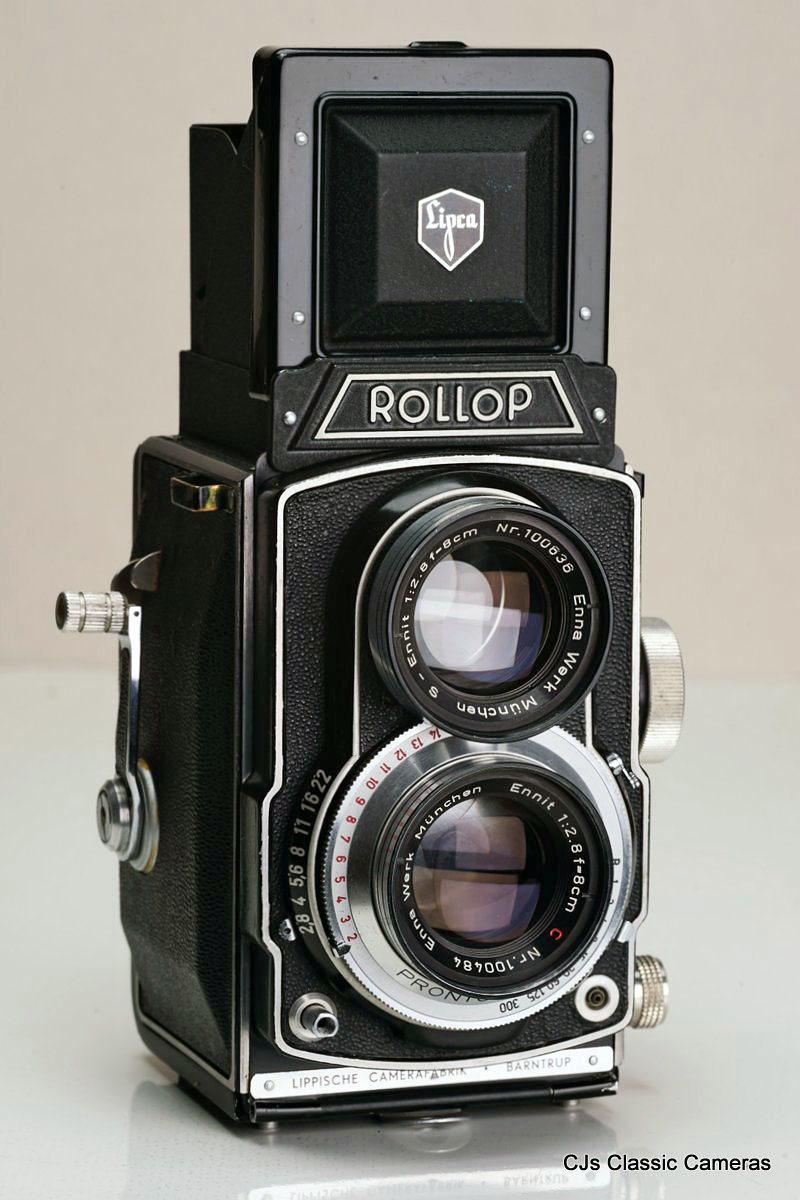 |
by a little switch, so that changing the shutter speed would also change the aperture and vice versa. Arguable the most exciting feature of the Automatic was the four-element Enna Ennit 80mm f/2.8 lens, a lens also found on other highly-rated cameras such as the Balda Super Baldax, and in terms of quality somewhere in-between the Planar and Xenotar on the Rolleis on the one hand and the Trinar on the Rocca Super Reflex above on the other hand. It was produced from 1956 to 1961.
Early version of the Lipca Rollop 2.8 Automatic with two four-element Enna Ennit 80mm f/2.8 lenses. This version did not yet have the name 'Automatic' beneath its name badge. It is also missing the accessory shoe and shutter release lock found on later production.
|
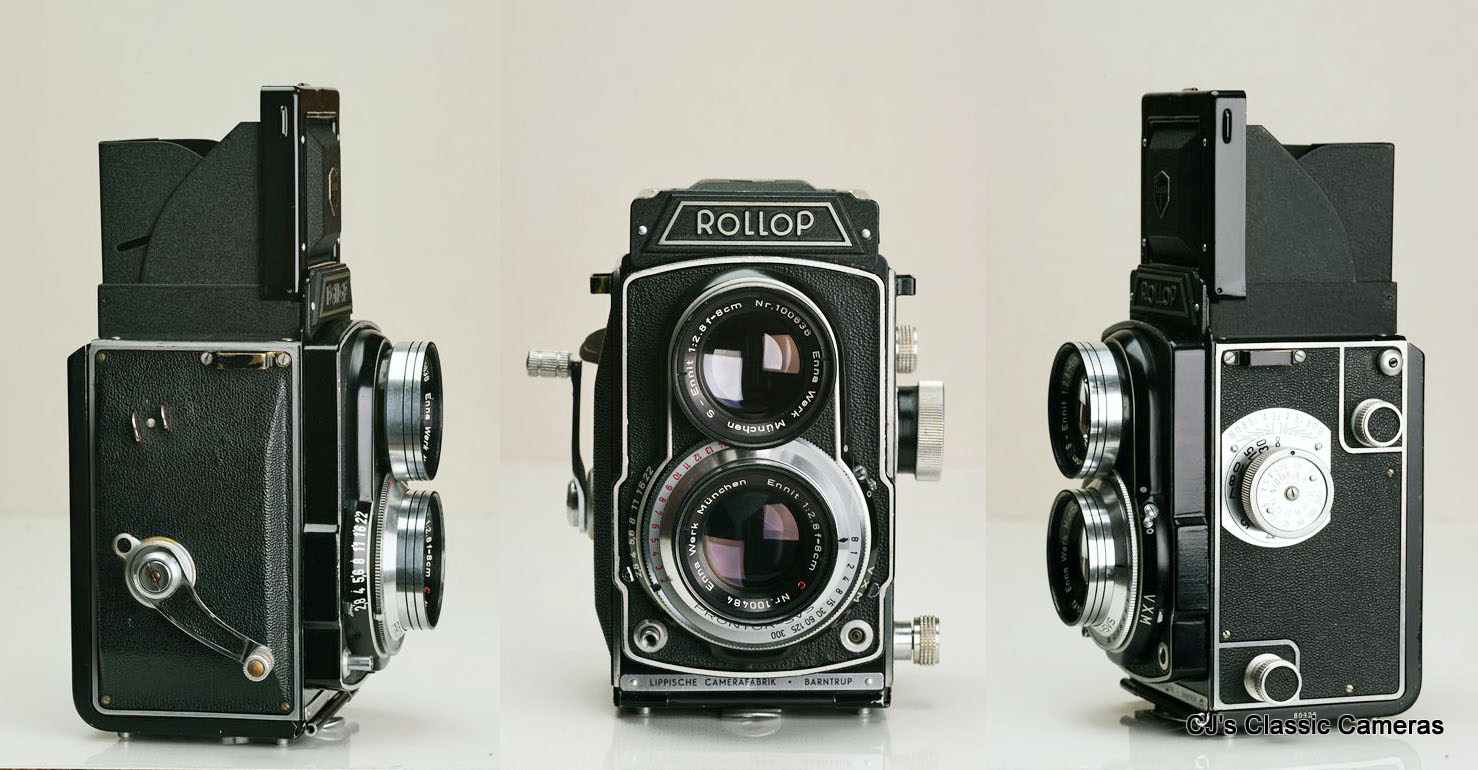
Several more views of the Lipca Rollop 2.8 Automatic.
Lipca Flexora
The Lipca Flexora was a much simpler camera than the Rollop from the same company (see above). Due to the name and the fact it has a focussing lever at the bottom of the camera, I initially thought it was made by Meopta (see Flexaret below). It had a wind knob and the traditional red window for film advance, with no double exposure prevention.
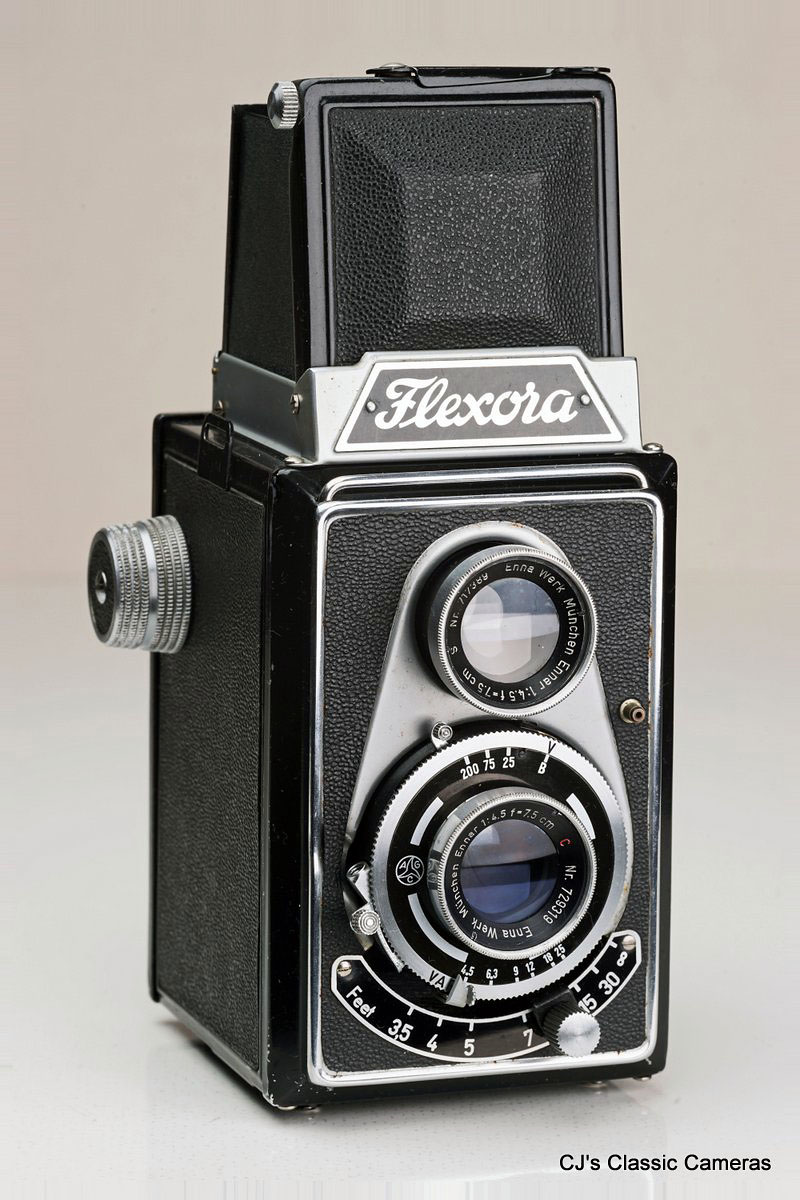
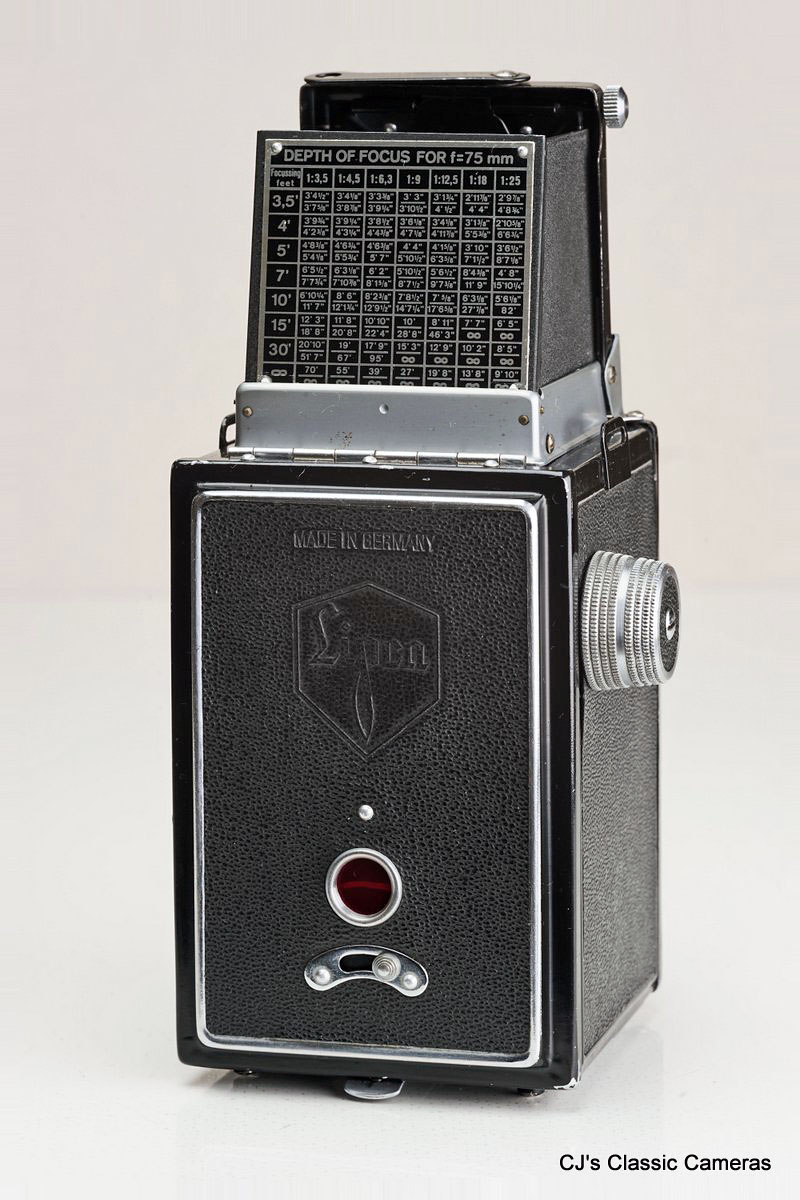
A Lipca Flexora with Enna Ennar 75mm f/4.5 lens in Vario shutter. The three-speed shutter is nothing special, but the Enna lenses had a good reputation - the same lens can also be found on the Balda Mess Baldix. Note the metal bar just beneath the Flexora name plate, this was actually the top part of a frame finder which could be pulled up.
Meopta Flexaret IVa
Meopta is not a brand I know much about but it is actually a company that still exists. It is an optical company that was founded in former Czechoslovakia in the 1930s which made several high-quality camera lines, including Leica style rangefinders (the Opema), large format technical cameras and a range of TLRs, the Flexaret, as well as photo enlargers. One of the interesting features of the Flexarets was that many of the models were designed to be quite adaptable in terms of film type or frame size. The Flexaret IVa is a good example of that.
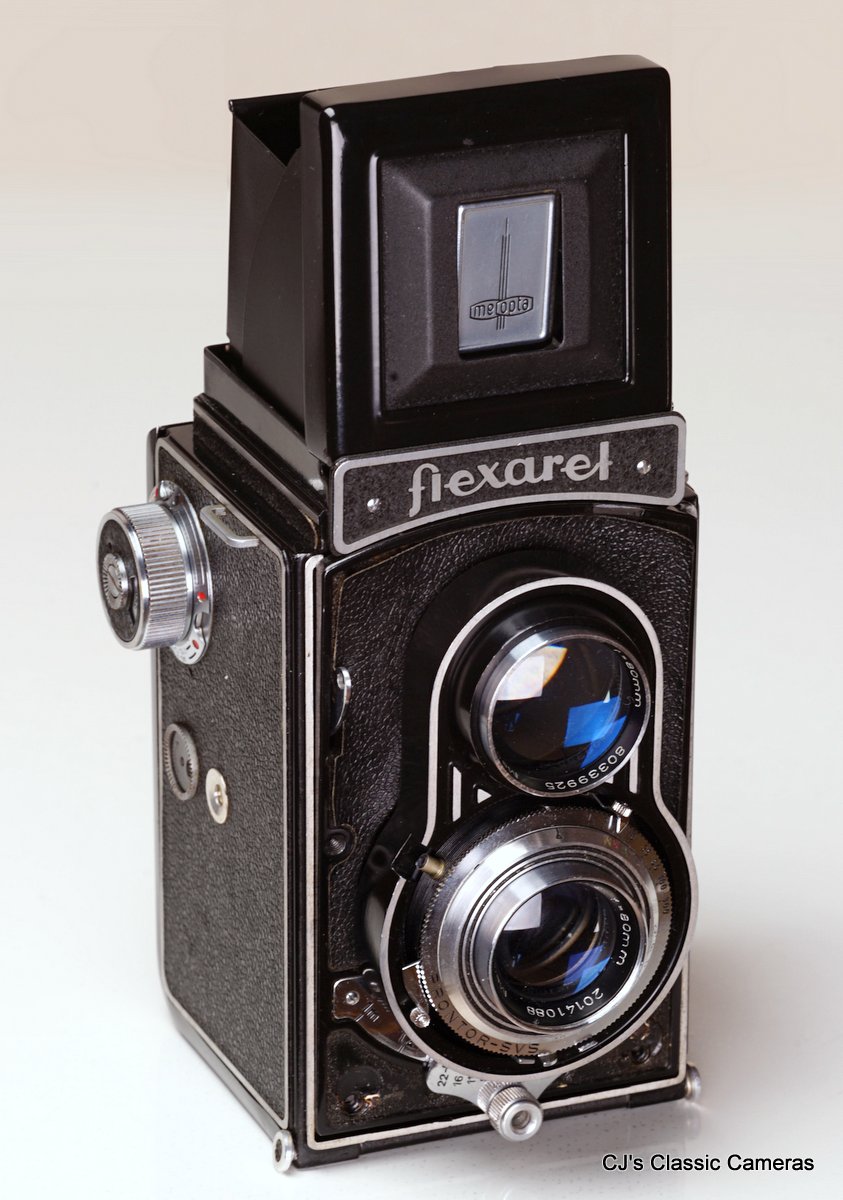
| |
It was introduced in 1956 and has a film transport feeler spool that also had sprocket wheels for 35mm film, which would give telephoto shots in portrait mode. The film counter could be adjusted to 35mm film also, albeit it manually. Unfortunately, this was all a little confusing if one used the camera in its regular 6x6 120 film mode. As Meopta was first and foremost an optical company, its cameras were equipped with its own lenses, which have a great reputation.
(left) A Meopta Flexaret IVa with coated four-element Belar 80mm f/3.5 lens in Prontor-SVS shutter. The small silver insert in the viewing hood with the Meopta logo can be folded away, which turns the hood into a 35mm direct viewfinder.
|
Another interesting feature was the focus mechanism, which consisted of a lever beneath the lens which would turn the focus helicoid on which the viewing and taking lens were mounted. This is similar to the mechanism on most Minolta TLRs, but Meopta introduced it earlier, although they did not invent it, as a similar construction can be found on older TLRs such as the Richter Reflecta.
|
The construction of the Flexaret was quite different from most other TLRs - it came apart in two main pieces: the film compartment with wind mechanism and the lens board-focus mechanism-viewing hood. With most other TLRs you can remove the viewing hood separately but access to the focus mechanism is often difficult.
|

|
Yashica-D
Besides producing rangefinders and half frame cameras that you can find elsewhere on this site, Yashica had a great reputation as a maker of TLR cameras. However, there's such a large range of them that I've always been somewhat reluctant to look at them closely, until one showed up on my doorstep as a repair job: the Yashica-D below.
It appears that TLRs were in fact the first type of cameras made by Yashica, starting in 1953 with the Yashimaflex, soon after to be followed by the Yashicaflex, which was available in quite a few variants, such as the Yashicaflex A, B, C, S and AS. These were all knob-wind TLRs, so more comparable to Rolleicord than to the Rolleiflex, but it is interesting to point out that some of these were equipped with light meters. At some point around 1957 or 1958 (even the experts disagree) the Yashica A, B, C and D were introduced. These all had the same lenses but the higher 'letters' had better shutters and some additional features. Then there were the Yashica 635 and LM, which were a D with 35mm option and C with light meter, respectively. If you are starting to get confused, so am I!

|
A Yashica-D with Yashikor 80mm f/3.5 lens in Copal MXV shutter from around 1969. In addition to making many models, Yashica also kept building them all for a long time. The Yashica-D had a life span of no less than 14 years!
This example had a sticky shutter with greasy blades but was other than that in great condition, as the picture shows.
|
Of course it didn't stop here. Soon followed the Yashica-Mat with wind crank, also available in LM and EM versions, the fully automatic Yashica E, then the Yashica 24, 12, both replaced by the Yashica Mat-124 (we're in the late 60s now) and the final model, the 124G. If you're getting cranky, so am I (pun intended).
All the mumbo jumbo aside, Yashica build their TLRs in large numbers as they were well-featured with highly respected lenses for a reasonable price. Perhaps they weren't as robust as the Rolleis, but good enough for amateur enthusiast, i.e., the people who could afford these, but not the Rolleis.
The Yashica-D is a good example. First of all, it looks like a Rollei, it has the same bayonet filter mount and similar shutter controls, the materials look of good quality, in fact it comes across as a Rolleiflex, just with knob wind, and it certainly compares well with the Rolleicord Va from the same time. All in all, the same counts today as all those years ago, if you want a TLR that does the job but doesn't break the bank, try a Yashica! If you want to know more, check out the Yashica TLR site.
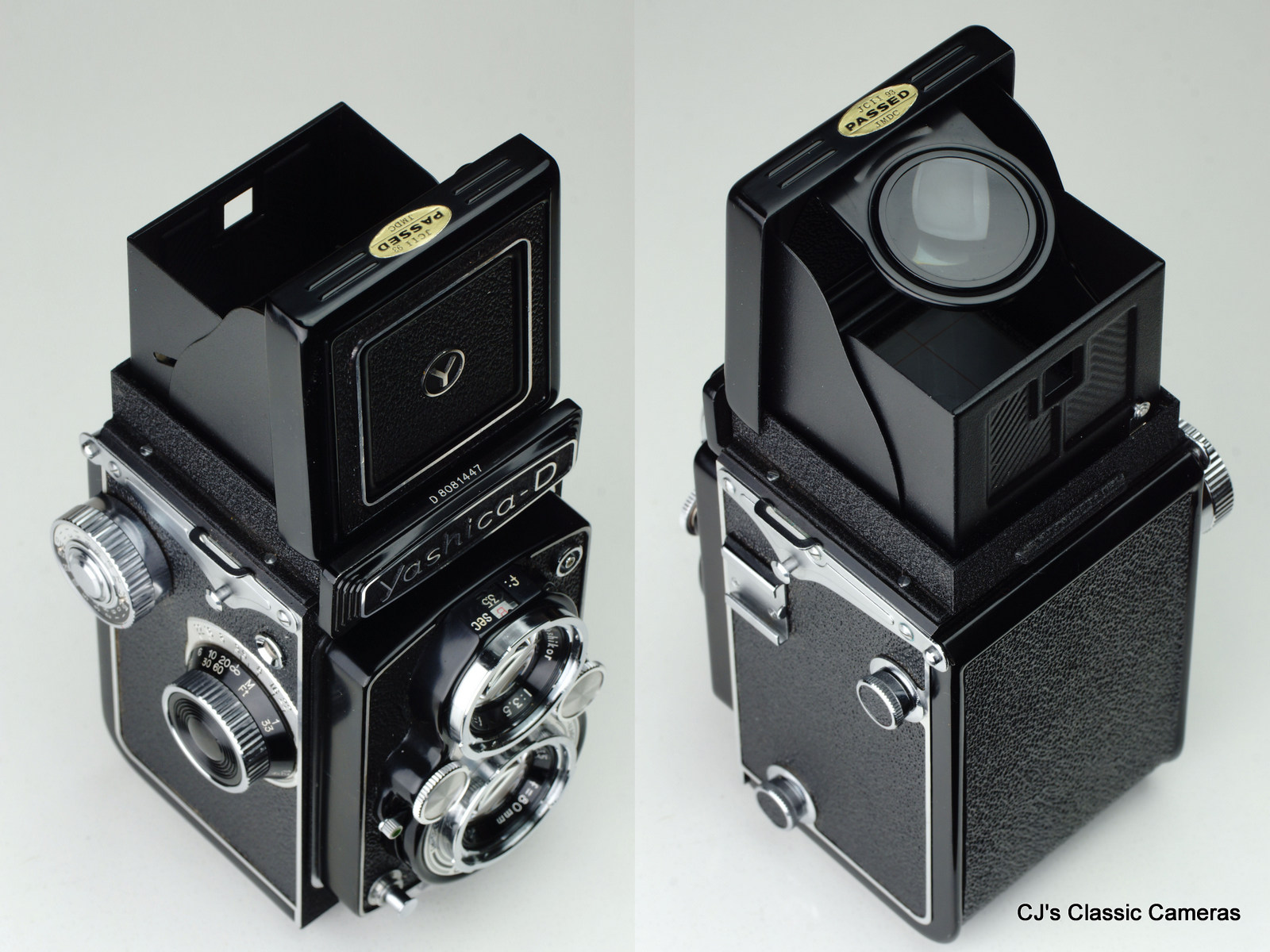
Two top views of the Yashica-D. All rather familiar looking, but that's a good thing in this case.
Argus Argoflex EM
Argus was an American camera company that produced its own cameras as well as licensed cameras build by other companies (e.g., the Argus V-100 by Iloca). Its most famous cameras were the Argus A and Argus C ranges (latter a.k.a. 'the Brick'), which made 35mm photography affordable nearly for everyone.
The TLR cameras made by Argus, the Argoflex range, are relatively unknown, certainly on this (non-US) side of the Atlantic and I only got one by accident in a lot with other cameras. The Argoflex E series, which my example is part of, differed considerably from the Rolleicords above, as the Argoflex took 620 roll film, had a front cell focussing taking lens which was coupled to the viewing lens by a gear system and had a self-cocking shutter. It did not have a wind lock mechanism so film winding had to be monitored using the customary 'red window'. The frosted focussing screen was a little smaller than the 6x6 Rolleicord ones, but did include a magnifier and sports finder. Only a few models were produced, the earliest had a plastic body, later models had metal bodies and the last version, the EF, had a flash sync with accessory shoe at the side of the body.
Later Argoflex models had plastic bodies but were pseudo-TLRs, lacking focus-coupling of the taking lens.
 |
An Argoflex EF from the late 1940s with coated 75mm f/4.5 Varex lens. |
SLR stands for single lens reflex, cameras that show the subject through the camera lens by means of a mirror and pentaprism or waist-level viewfinder. I tend not to collect these, at least not systematically as I prefer the range- and viewfinders of earlier days (and one has to draw a line somewhere!), but I do have several scattered on this site, including a Retina Reflex and some Exa/Exaktas. I also still own a Minolta 9xi from my pre-digital days and a Sony A77, which technically is called an SLT as it has a semi-transparent mirror. My other SLRs (only one so far!) follow here.
KW Praktica
The KW Praktica was one of the first SLR cameras on the market and sort of a poor man's Exakta. It was a further development by Kamera Werkstatten (KW) if its first SLR, the Praktiflex. KW was based in Dresden and had developed some innovative cameras in the early 1930s, including the Pilot Reflex, a small handsome TLR camera. After WWII KW resumed production fairly quickly and introduced the Praktica with M42 screw mount, which mount had only recently been introduced with the Zeiss Ikon Contax S. The Practica was a great succes and soon after followed a whole range of Praktica SLRs, which lasted until well in the 1990s (as part of VEB Pentacon).
The 1949 Practica was a fairly simple SLR camera with a non-interchangeable waist-level viewfinder, a wind knob and a fastest speed of 1/500s. It was relatively cheap and reliable. A separate pentaprism viewfinder which could be mounted on top of the waist-level viewfinder was available as an option.
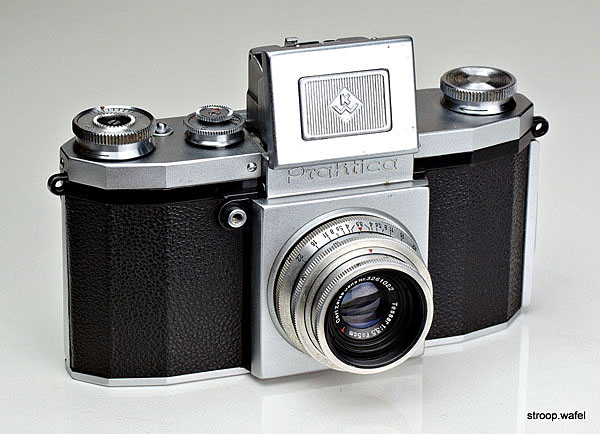
An early version of the KW Praktica, recognisable by its integrated strap lugs, with coated CZJ Tessar 50mm f3.5 lens. The waist-level viewfinder could also function as a so-called sportsfinder by opening the flap with the KW logo on it.
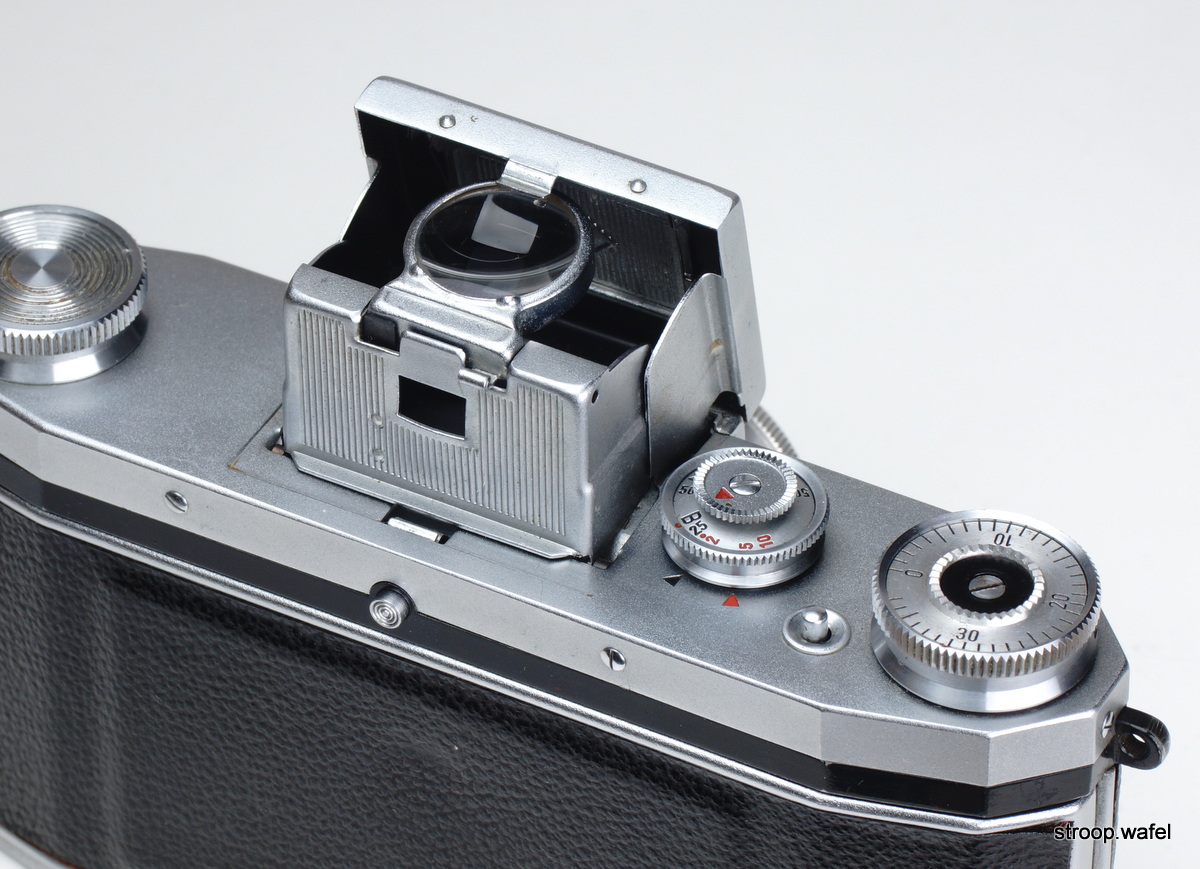
Detailed view of the top of the KW Praktica showing the waist-level viewfinder unit with magnifier. Also note the shutter speed dial, the top dial of which functioned as the slow and fast speed selector. If it pointed to the black triangle, the black numbers applied, and if it pointed to the red triangle, the (slow) red numbers applied. The speed itself was indicated by a small red dot on the lower ring.
KW Praktina
The 1954 Praktina was a more advanced model of Kamera Werkstatten's Practica, described above. It was highly adaptable, having interchangeable viewfinder, focussing screen and camera back, as well as a provision to mount a motor wind. In addition, the Praktina had a revolutionary feature: automatic aperture control, which allowed to focus at maximum aperture but would automatically stop down to the selected aperture upon firing the shutter. Of course this was also available on the Ihagee Exakta Varex, but there it was done on the lens whereas on the Praktina it was implemented in the body. Moreover, the Praktina took it a step further. On early models (the Praktina FX) one still had to open the aperture manually after shooting, but on the 1958 Praktina IIA the aperture would be opened during film winding (on lenses that allowed this feature), so one never had to worry about it anymore.
A peculiar feature of the Praktina was the presence of a direct viewfinder in addition to the through-the-lens viewfinder. It was brighter so useful in low light, and would not blank out during shutter release, one of the drawbacks of SLR cameras without automatic mirror return.
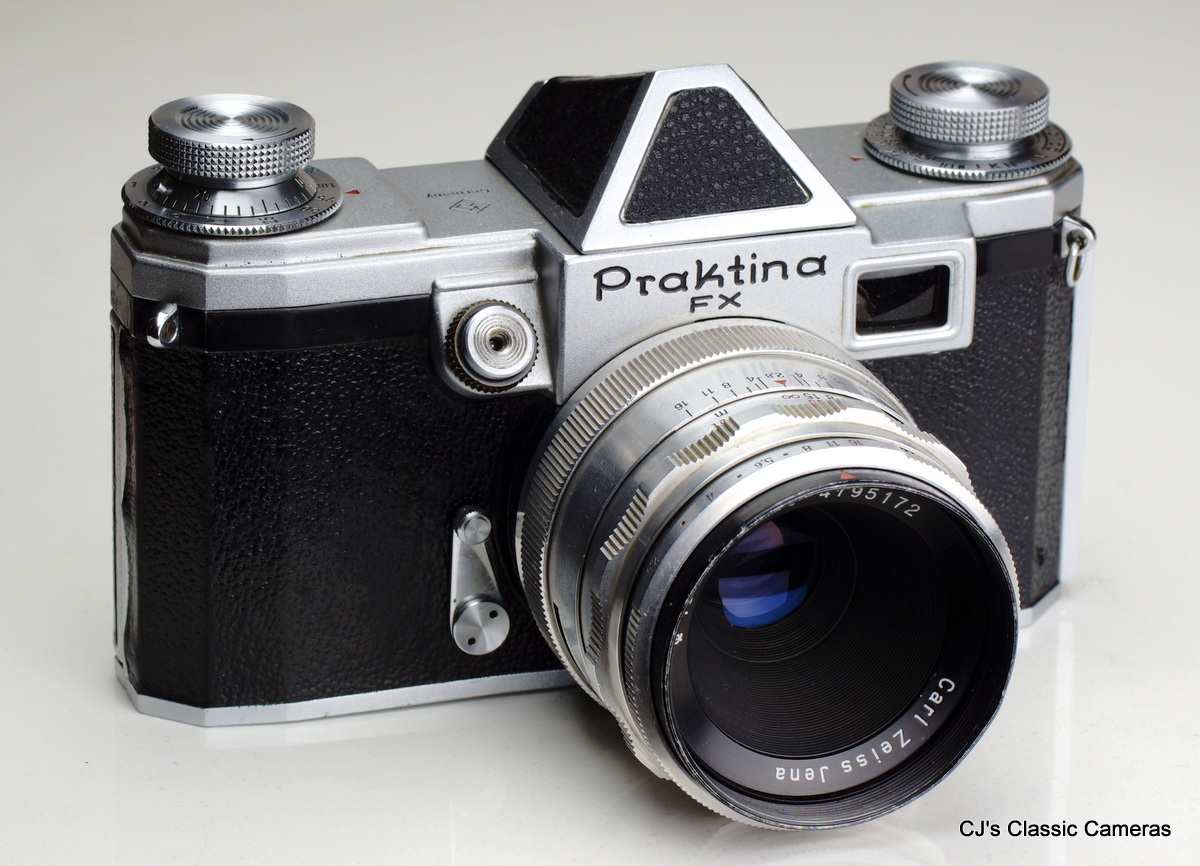
A KW Praktina FX with Carl Zeiss Jena Tessar 50mm f/2 lens with semi-automatic aperture control. I believe this to be a Praktina FX-SA3 version 2 according the praktina.com website, as it has a film reminder dial with both DIN and ASA film speed settings.
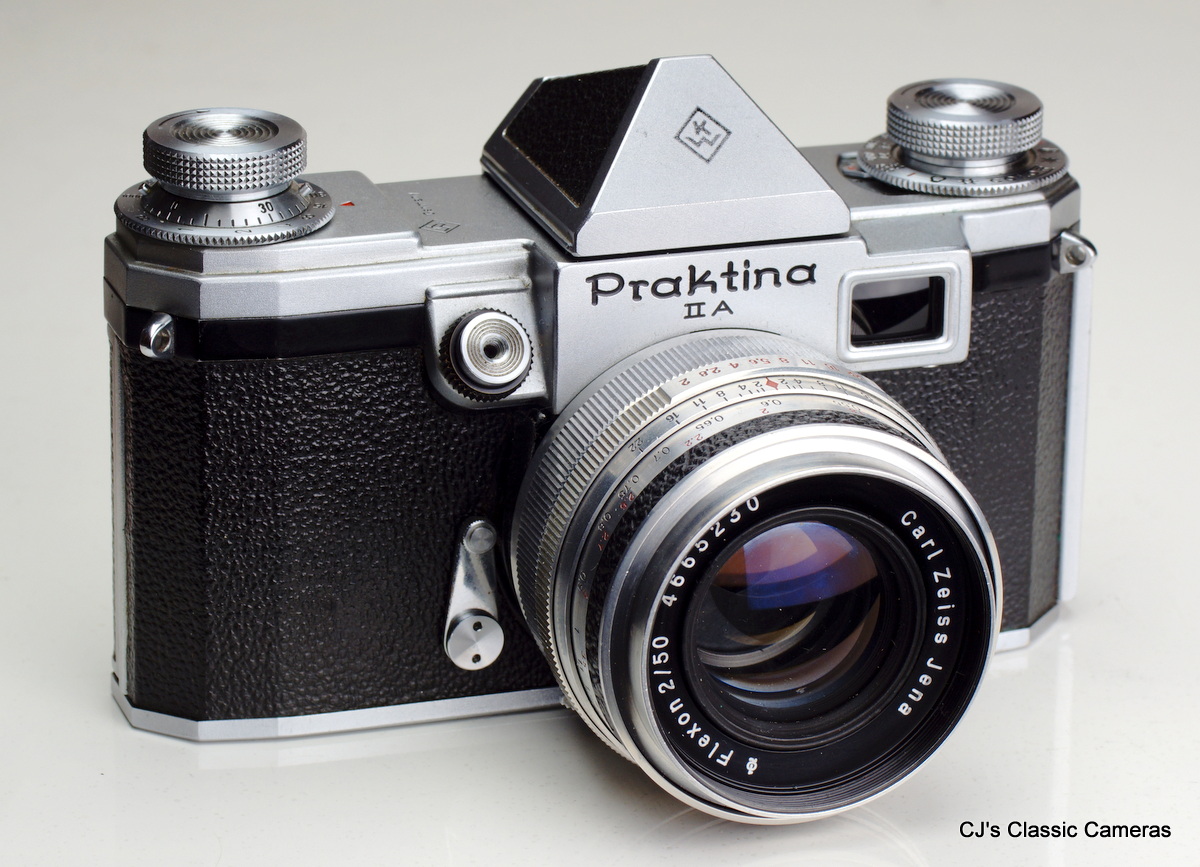
A KW Praktina IIA with Carl Zeiss Jena Flexon 50mm f/2 lens with fully automatic aperture control. This is a Praktina IIA-A version 2 according the praktina.com website.
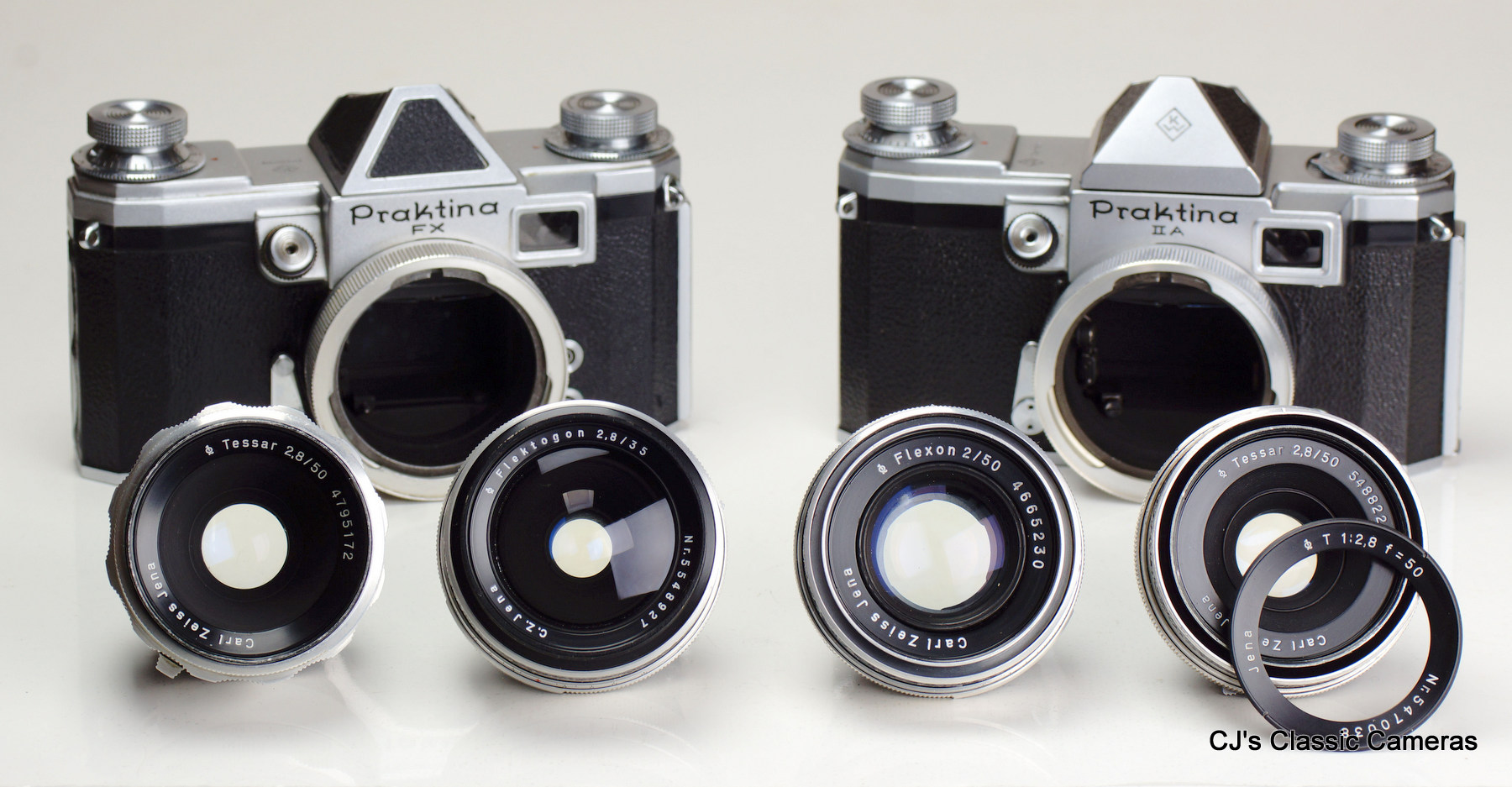
Two KW Praktinas with various lenses, including a wide-angle 35mm f/2.8 Flektogon . The one on the right is quite curious. It's marked Jena T, which is what the original East German Carl Zeiss factory called their Tessars after they lost the trademark in a dispute over the rights of the name with Zeiss Ikon, the new West German branch. I removed the front ring from this lens in an attempt to clean the front cell, only to find out there was a second ring beneath it marked Carl Zeiss Jena Tessar and sporting a different serial number. So the ring looks like a quick patch after Carl Zeiss Jena lost the rights to their name. Curiously, the Flektogon has a later serial# but still carries the name C.Z. Jena.
Pentacon F
The Pentacon SLRs were made by the former Zeiss Ikon factories in Dresden, which in the late 1950s merged with several other companies and was renamed VEB Pentacon due to legal disputed with the new Zeiss Ikon company in West Germany. One successful range of cameras produced was the Contax SLR range, which soon after was renamed Pentacon for the same legal reasons.
The Pentacon F was first introduced in 1957 and had a semi-automatic aperture which was set while cocking the shutter.

A Pentacon F displayed with a Carl Zeiss Jena Tessar 50mm f/2.8 lens. The Pentacon logo om the front can also be found on the Pentona II elsewhere on this site.
Kalimar Reflex
The 1957 Kalimar Reflex was built by Fujita and was an improved version of the earlier Fujita 66 and Soligor 66. Although technically an SLR, it handled very much like the TLR cameras above, the main difference being the mirror which was not fixed (to a viewing lens), but retractable and therefore could use the taking lens as viewing lens. The system is best known from the Hasselblads. A focal plane shutter was used to make this setup possible (as a leaf shutter would block the view). Other than that, one would wind the film with a knob on the side and view the image from the top through a hood with a frosted glass, very much like most TLRs. The Kalimar Reflex also featured an instant return mirror, making the experience even more similar to a TLR.
One important difference was the ability to change lenses, which is simpler to implement on a system like this than on TLRs, as one didn't have to worry about different viewing and taking lenses. In fact, the Kalimar had a 52mm wide angle lens available, one of the few medium format SLR systems to do so. The lens mount was a 46mm screw mount.
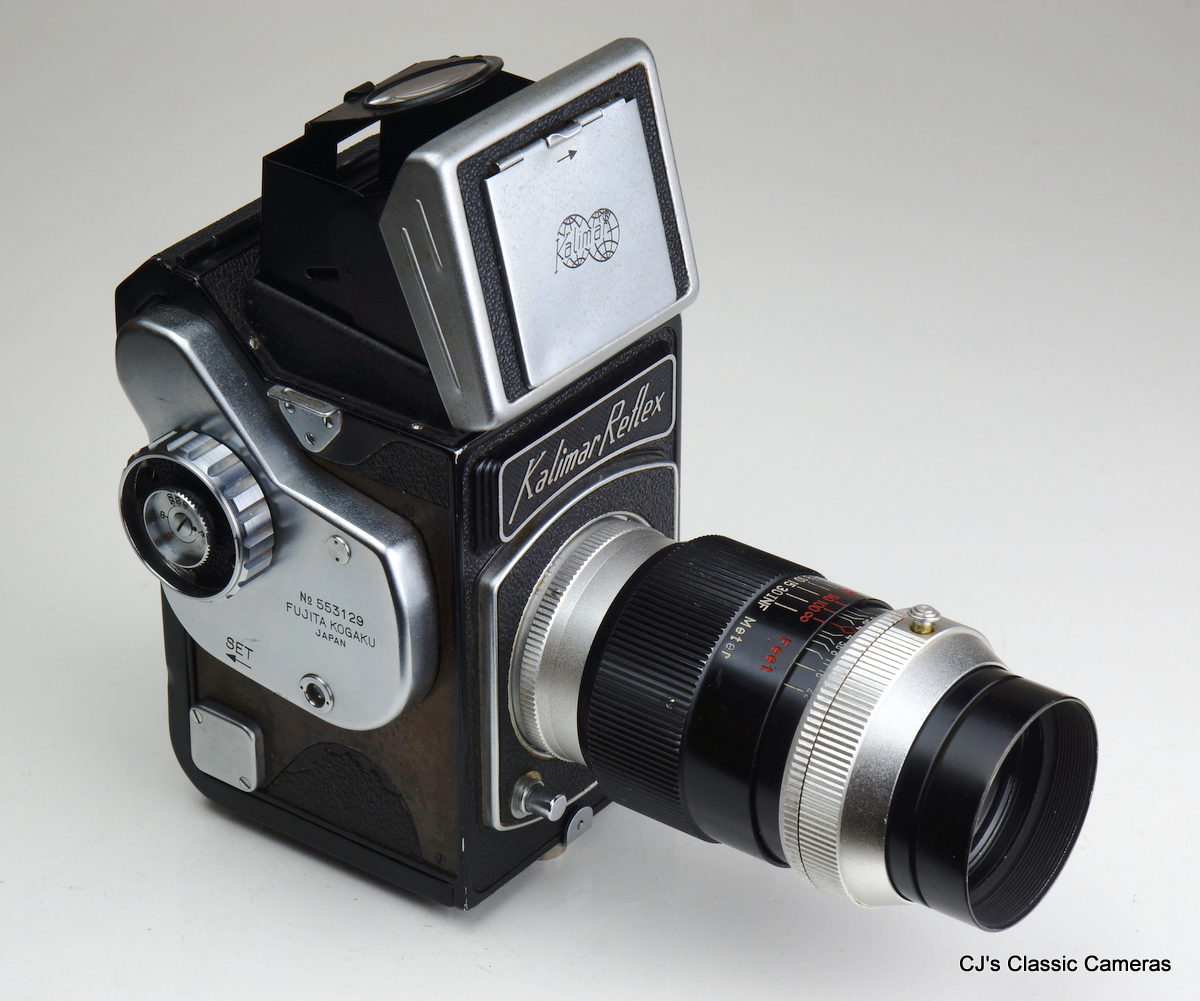
A Kalimar Reflex with Kaligar 150mm f/4 lens. This is not the standard lens for this system, as that would be the 80mm f/3.5, which I do not have.
Zenit 3M
The Zenit line of SLR cameras was introduced in the early 1950s by KMZ, the maker of the Zorki Leica copies, and started in fact off as a Zorki II which had been converted to an SLR model by adding a groundglass screen and a mirror. It kept the same L39 screw mount but the flange distance increased to make room for the mirror, so lenses are not interchangeable between the two mounts. In 1960 the Zenit-3 came out, which featured a film advance lever instead of a wind knob. It was still bottom loading (like most Leica copies), this was however changed to a hinged back on the Zenit-3M, like the one shown below. The next model received a lightmeter in 1967 the lens mount was changed to the more practical m42 mount. Many more generations were to follow; the Zenits were a great succes with a production in the tens of millions, and as recently as the early 2000s.
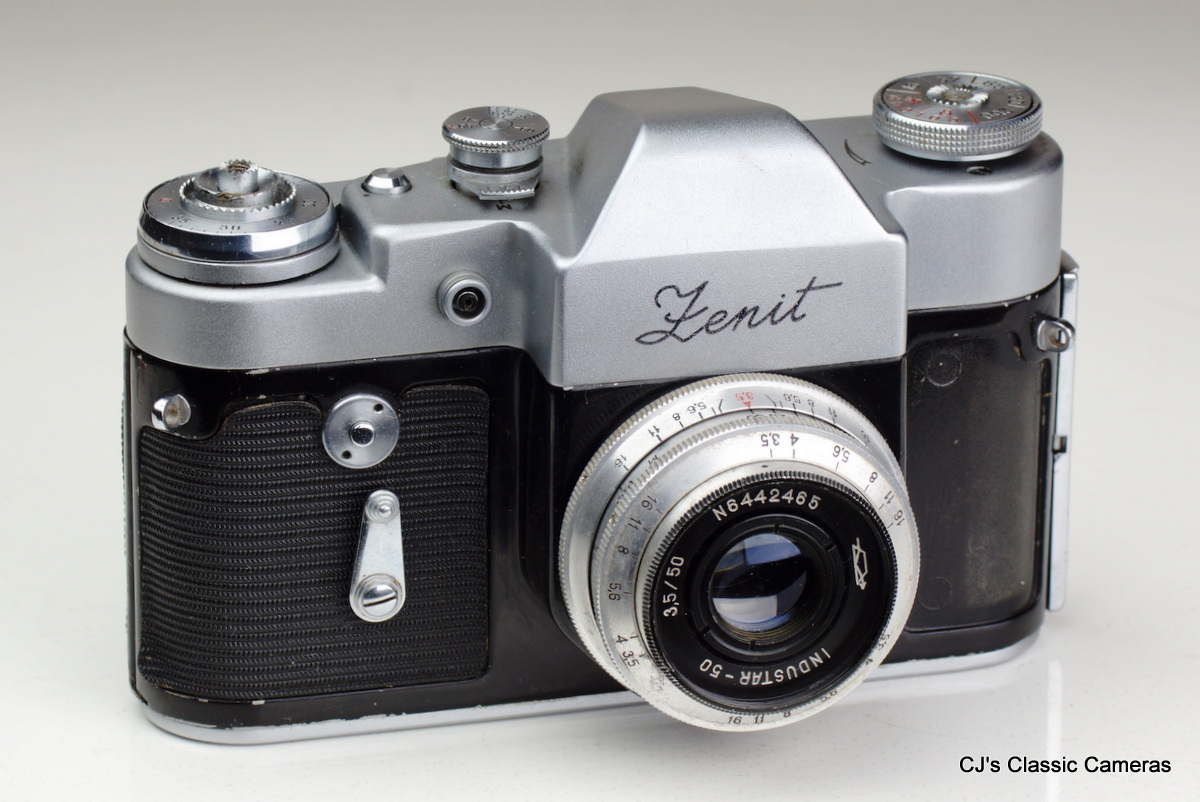
An Zenit 3M from 1966, assuming the serial# starts with the year of production. It is fitted with an Industar-50 50mm f/3.5 lens. It is not a particular advanced camera for its time, lacking slow shutter speeds and having a top 1/500s speed, no lightmeter or automatic diaphragm, etc. But that also means not much can go wrong with it, and indeed it still works quite smoothly.
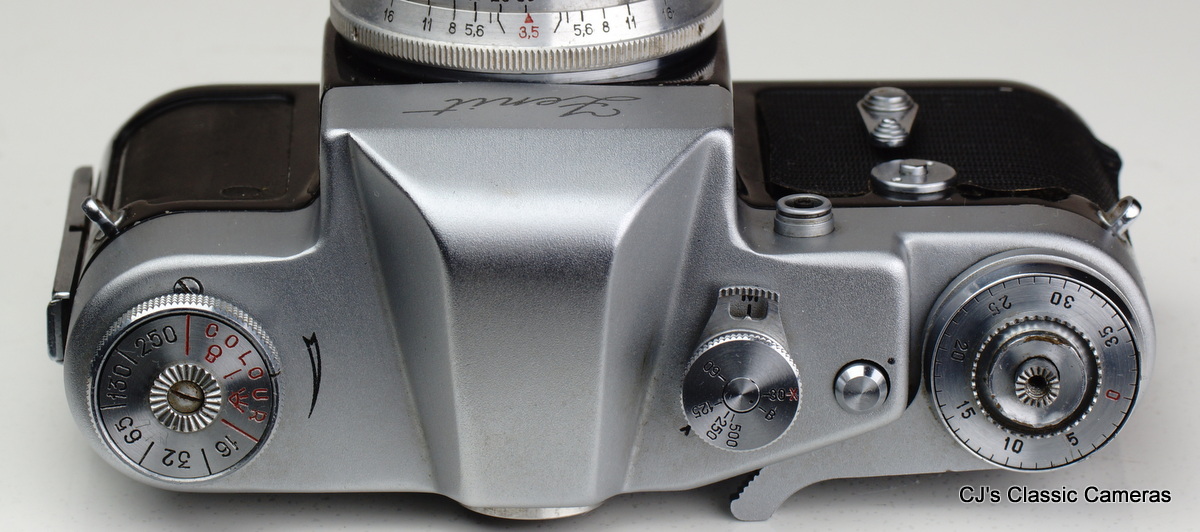
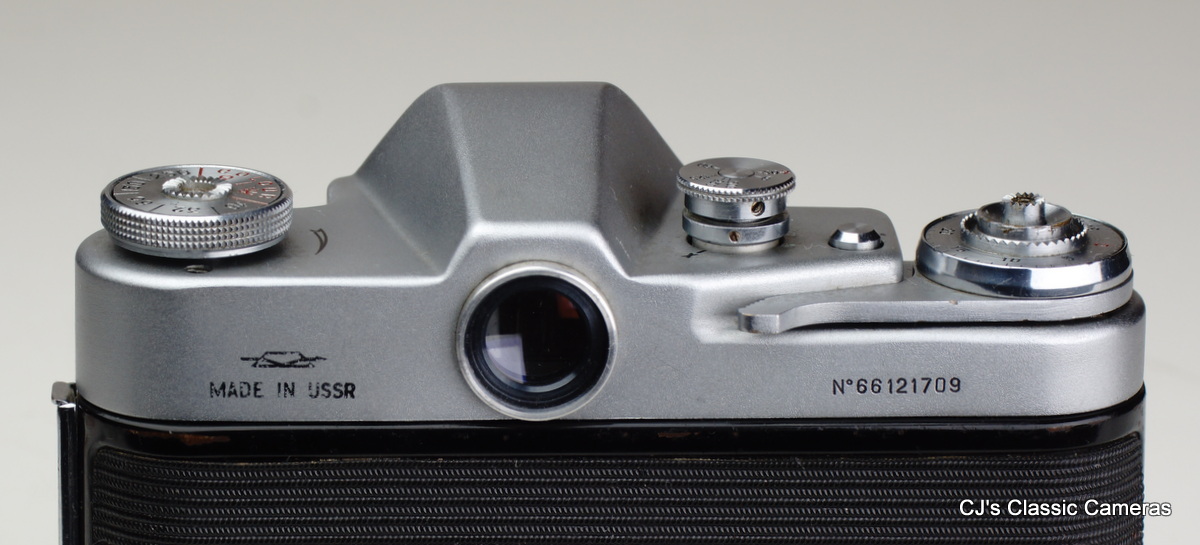
Top and rear views of the Zenit 3M, showing off its unassuming and functional design. One neat feature of this otherwise fairly low-spec model was the mirror lock-up button in-between the wind-lever and speed dial: push it once and the mirror would lock up, push it twice and the shutter would fire. A similar way of avoiding mirror shake could be achieved with the time delay button, as it would lock up the mirror several seconds before opening the shutter.
Polaroid SLR 680
Polaroid is one of the most recognisable names in photography, but perhaps more so due to those iconic instant photographs with thick white borders which used to cover people's refrigerators and pin boards than as a brand of cameras. The instant camera was developed in the 1940 by Edwin Land, the founder of Polaroid, hence the name Land cameras for the early Polaroid models. The concept caught on quickly and Polaroid sold many millions of their cameras. Although with the advance of digital cameras and photo printers the concept is less popular now, the Polaroid company still exists.
The Polaroid SLR 680 camera was introduced in the early 1980s and was based on the SX-70, the first fully automatic instant folding camera. The Polaroid 600 series used a film cassette which also included the battery to run the camera. Unfortunately Polaroid recently stopped making these, but a new company, the Impossible Project, has developed an equivalent film. Ironically, Polaroid still advertises a camera that uses this film, as well as the film itself.
Most 600 series cameras were simple point and shoots, but there were some more advanced models, including the SLR 680, a professional quality camera which featured auto-exposure, auto-focussing, automatic electronic flash, through-the-lens viewing and an excellent lens. In addition it folded down to a flat but fairly large package. It was discontinued after about five years, but was reintroduced in 1996 as the SLR 690 with only minor (internal electronic) modifications. Both models are still sought after these days.
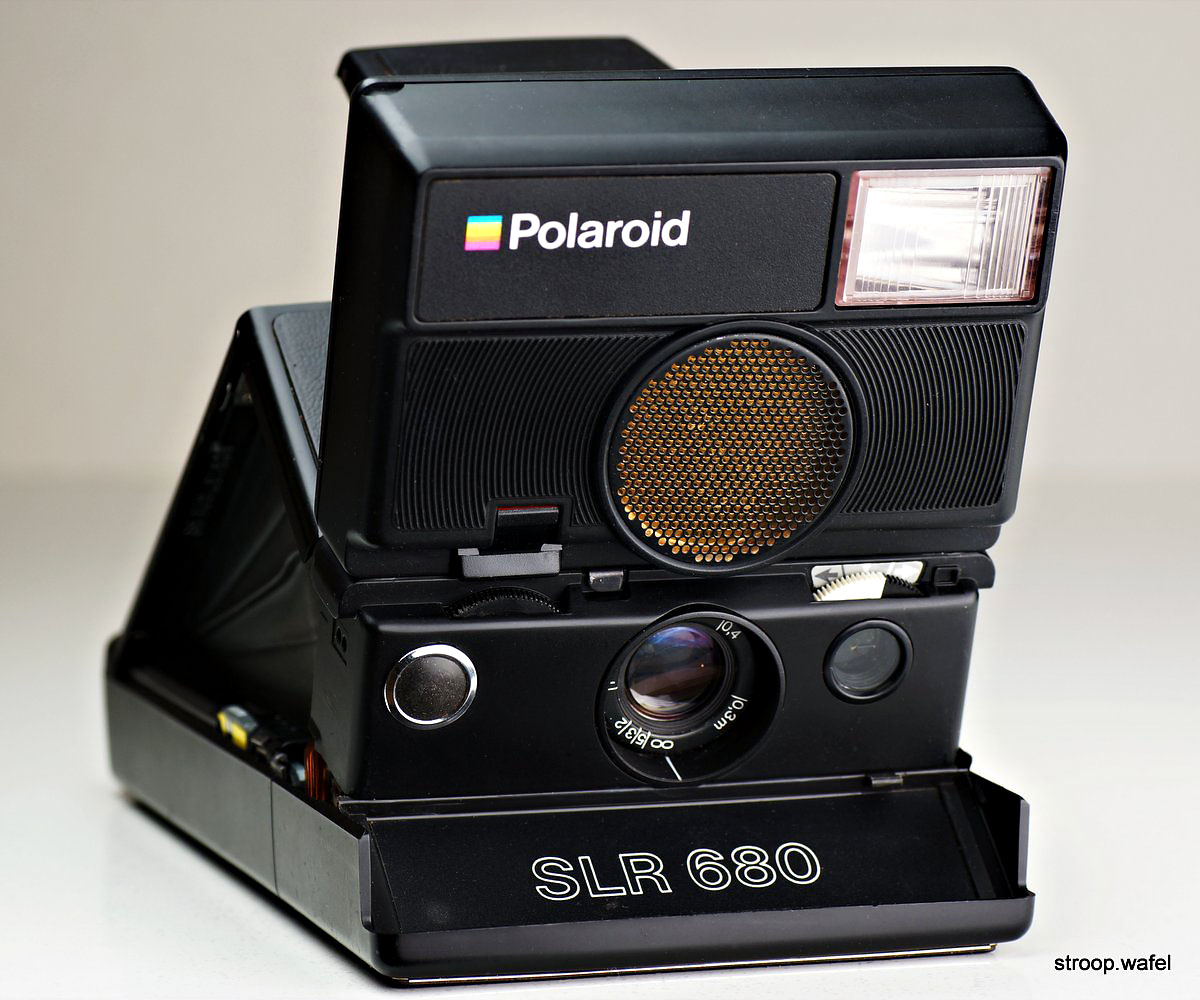
A Polaroid SLR 680 camera with 4-element lens 116 mm f/8 lens which (auto)focusses from 26 cm to infinity. What looked like a little gold-coloured speaker on the camera was indeed just that: an ultrasound generator that the camera used to calculate the distance to the nearest object and to autofocus the lens, i.e., a sonar system. The flash angle would also be automatically adjusted.
Other SLRs
The following SLR cameras can be found elsewhere on this site. Please click the photo to go there.
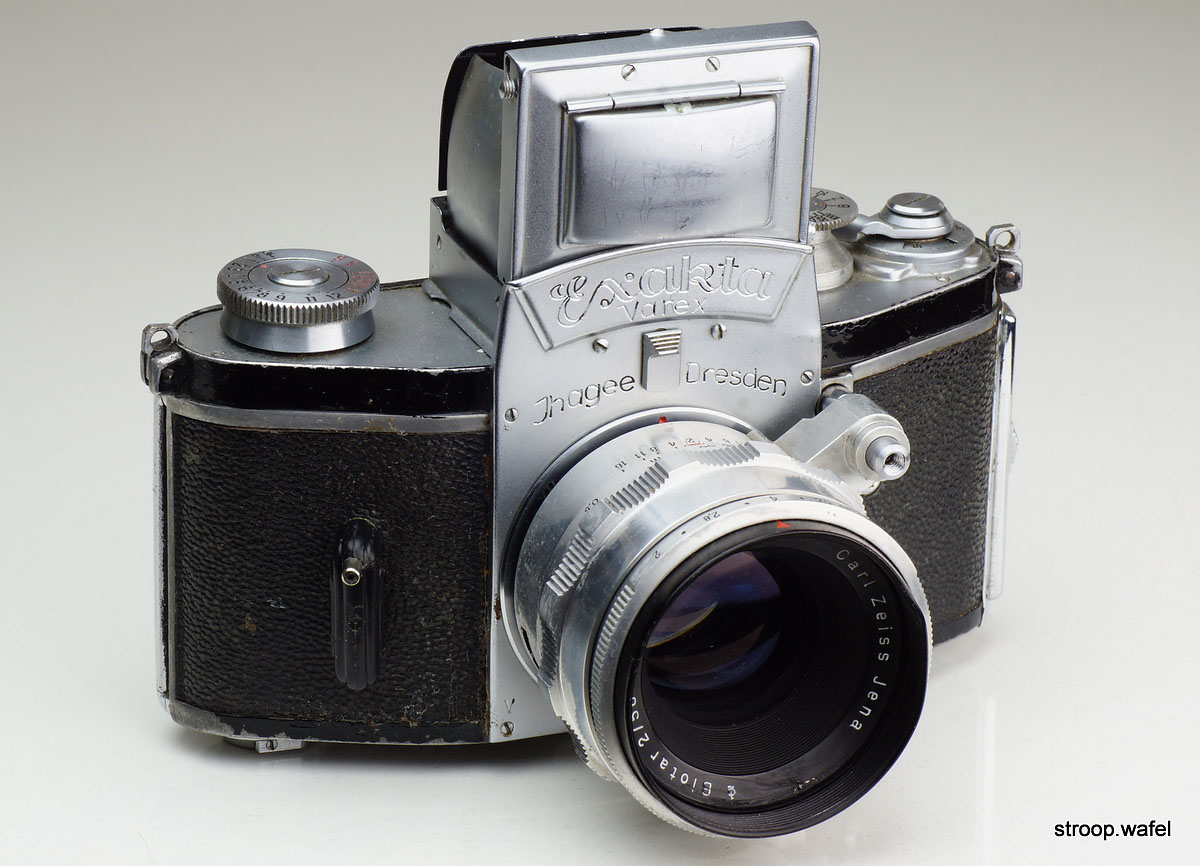
|
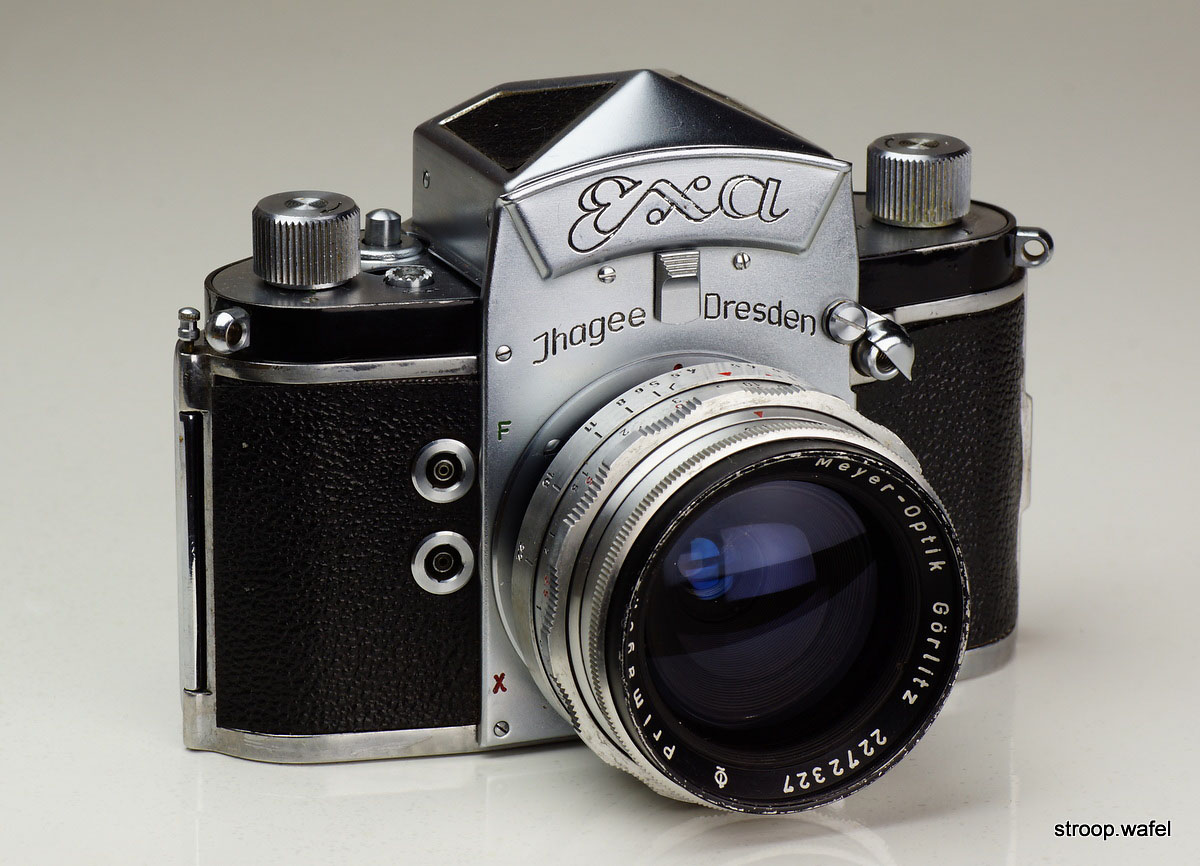
|
|
Ihagee Exakta
|
Ihagee Exa
|
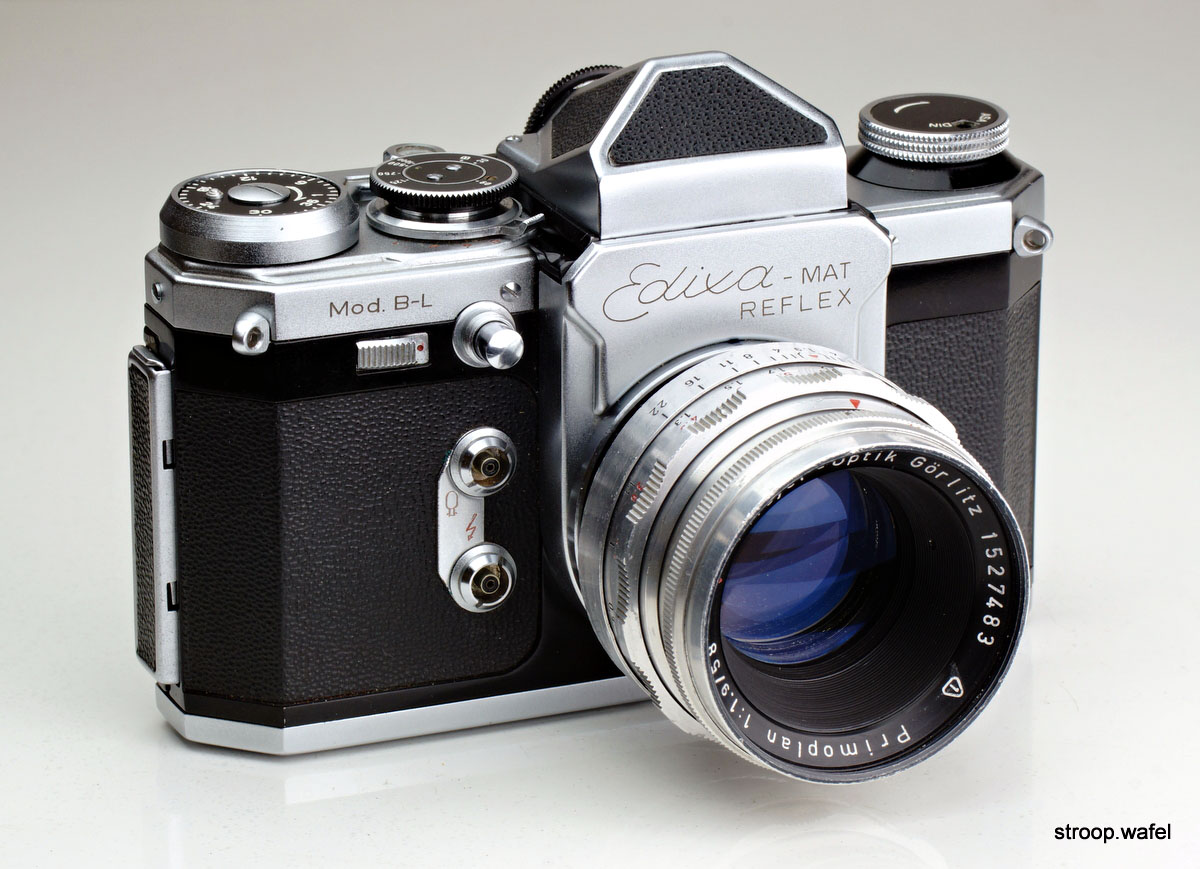
|
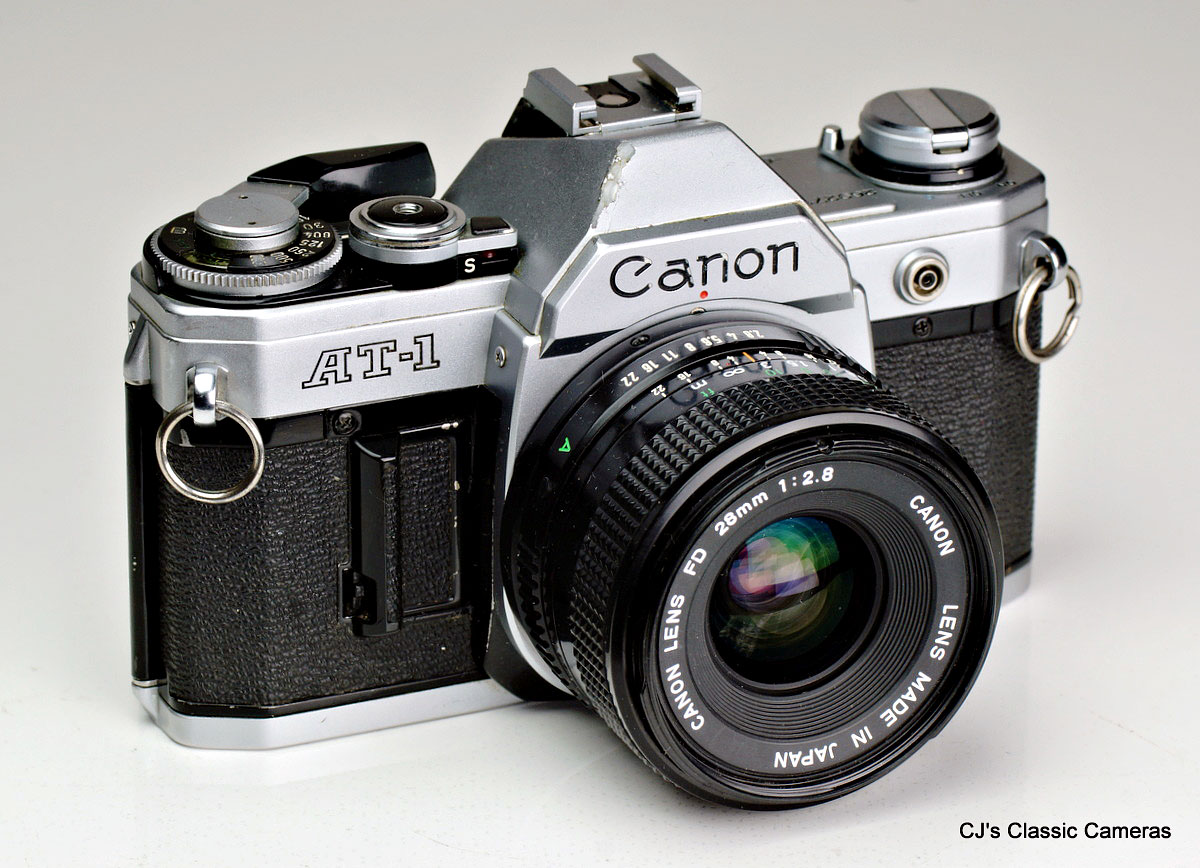
|
|
Wirgin Edixa-Mat Reflex
|
Canon AT-1
|
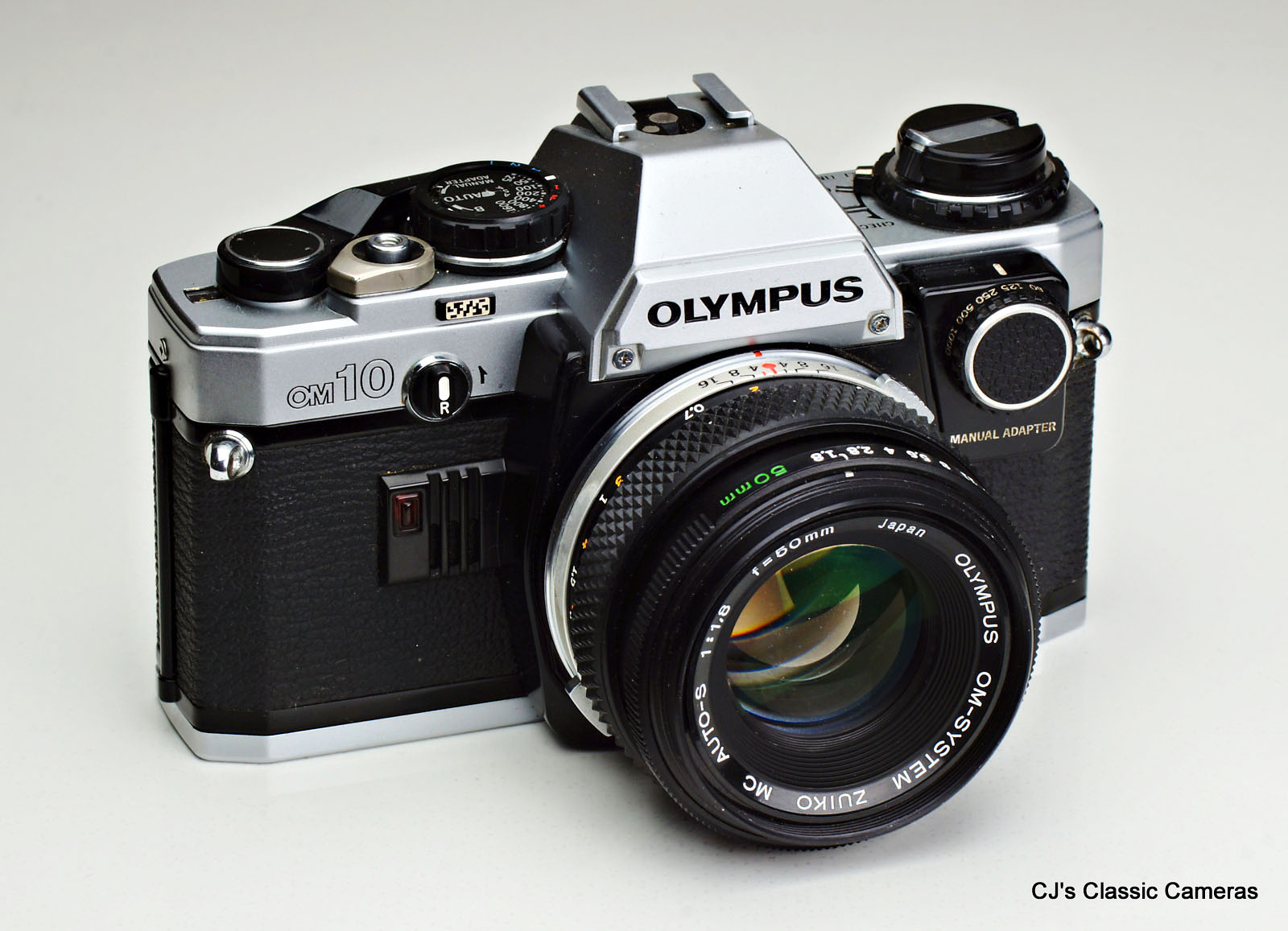
|
|
|
Olympus OM10 / OM2
|
|
|

